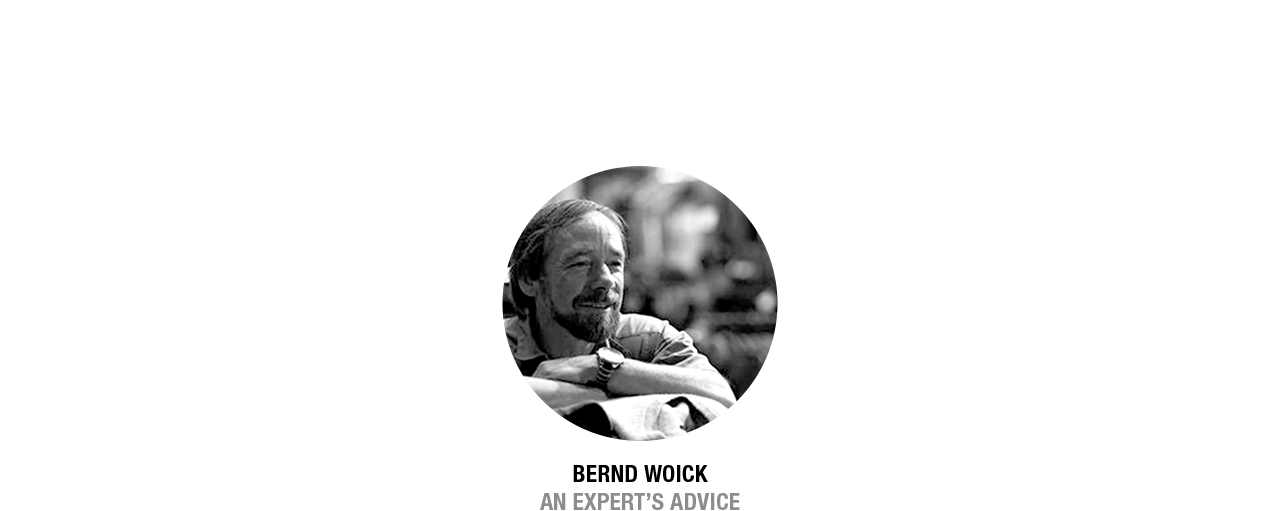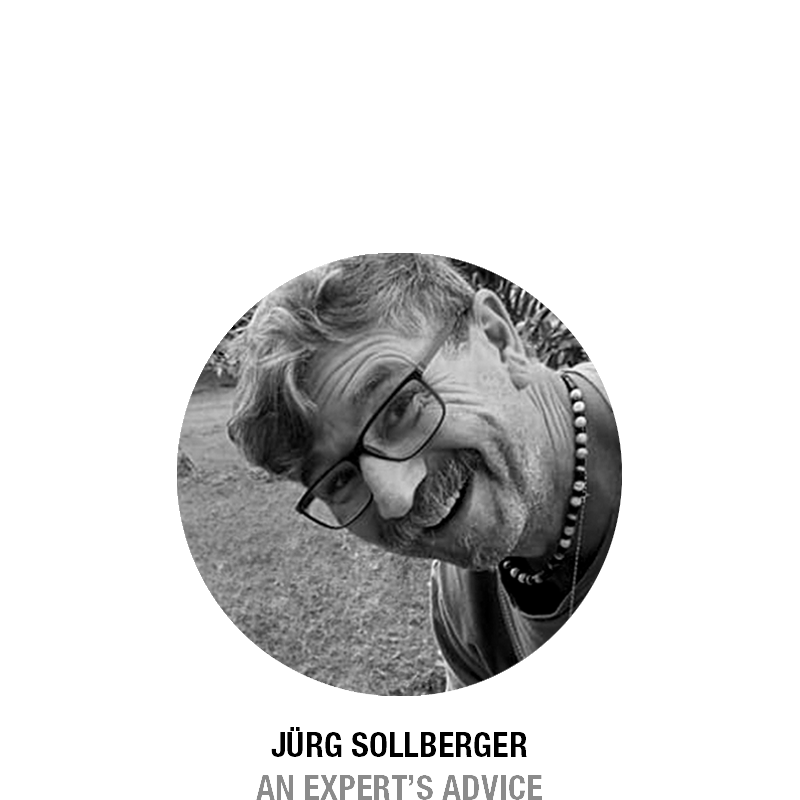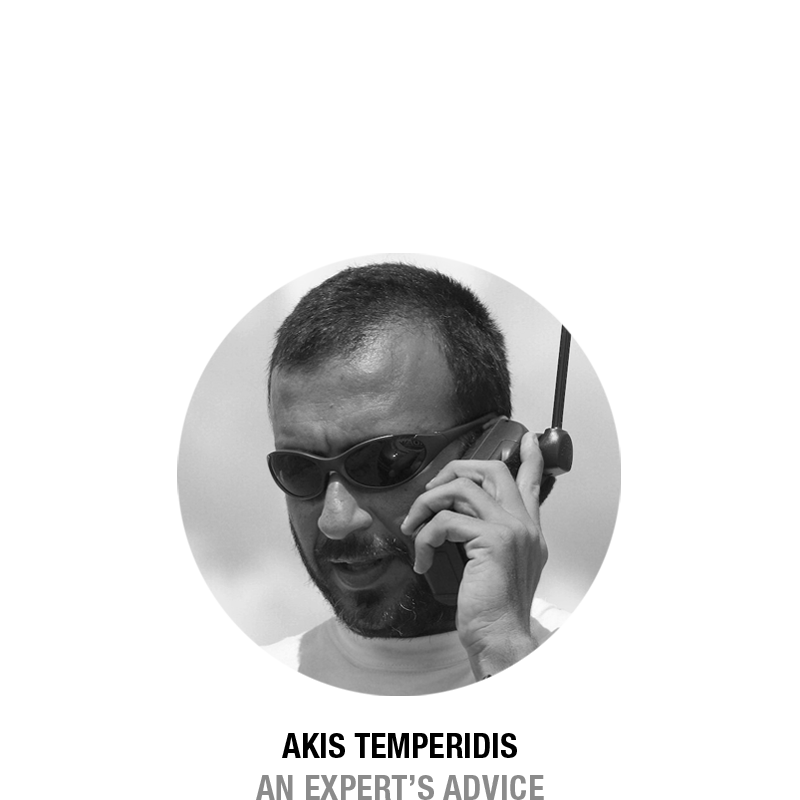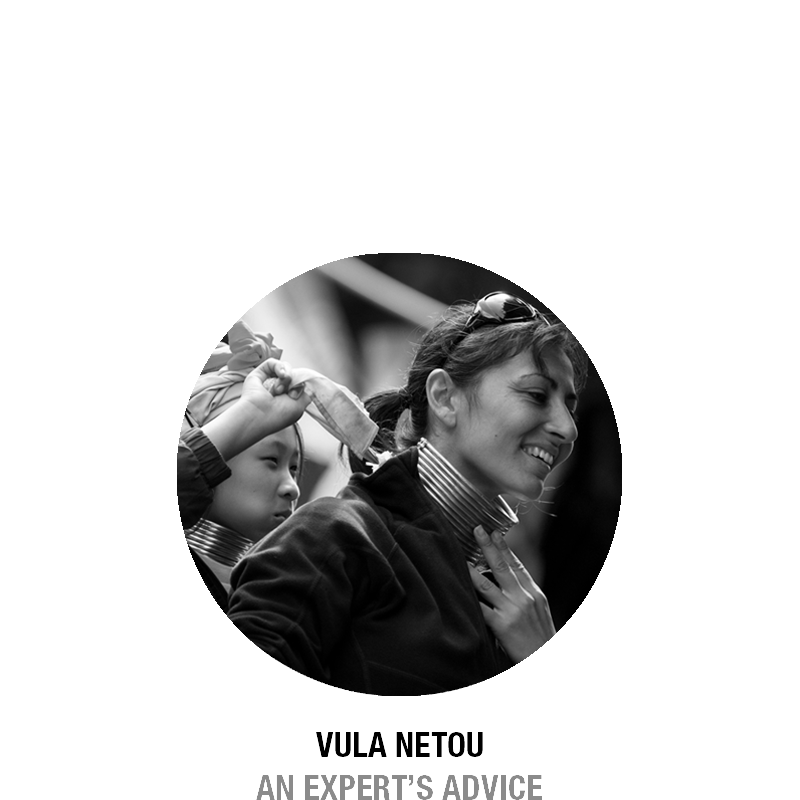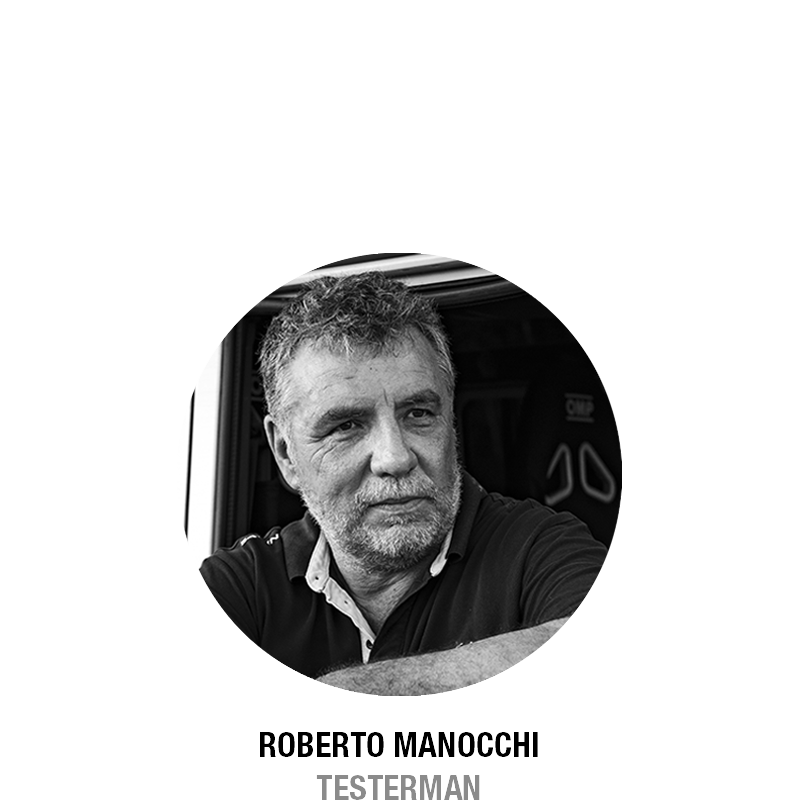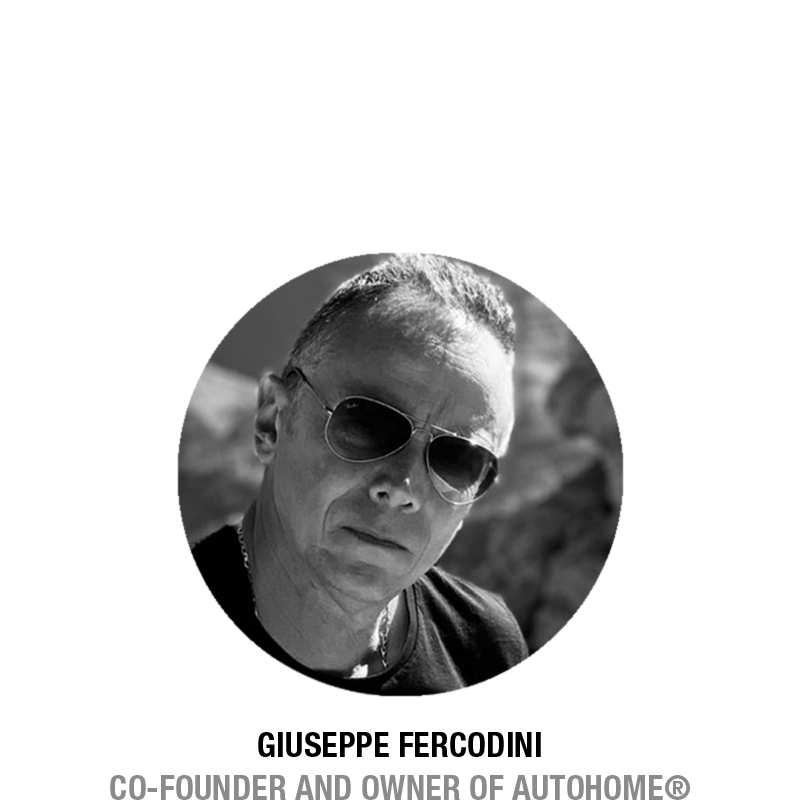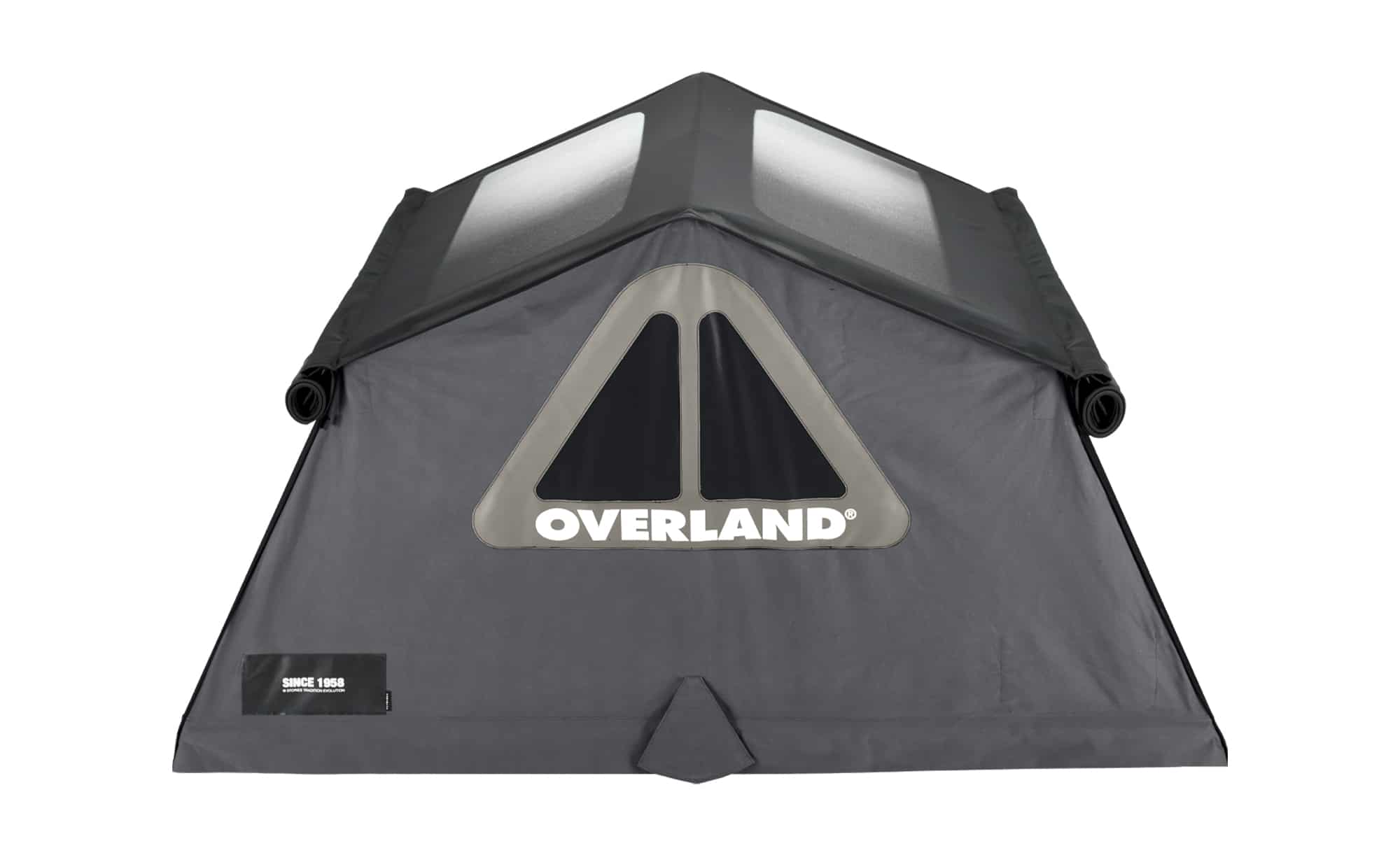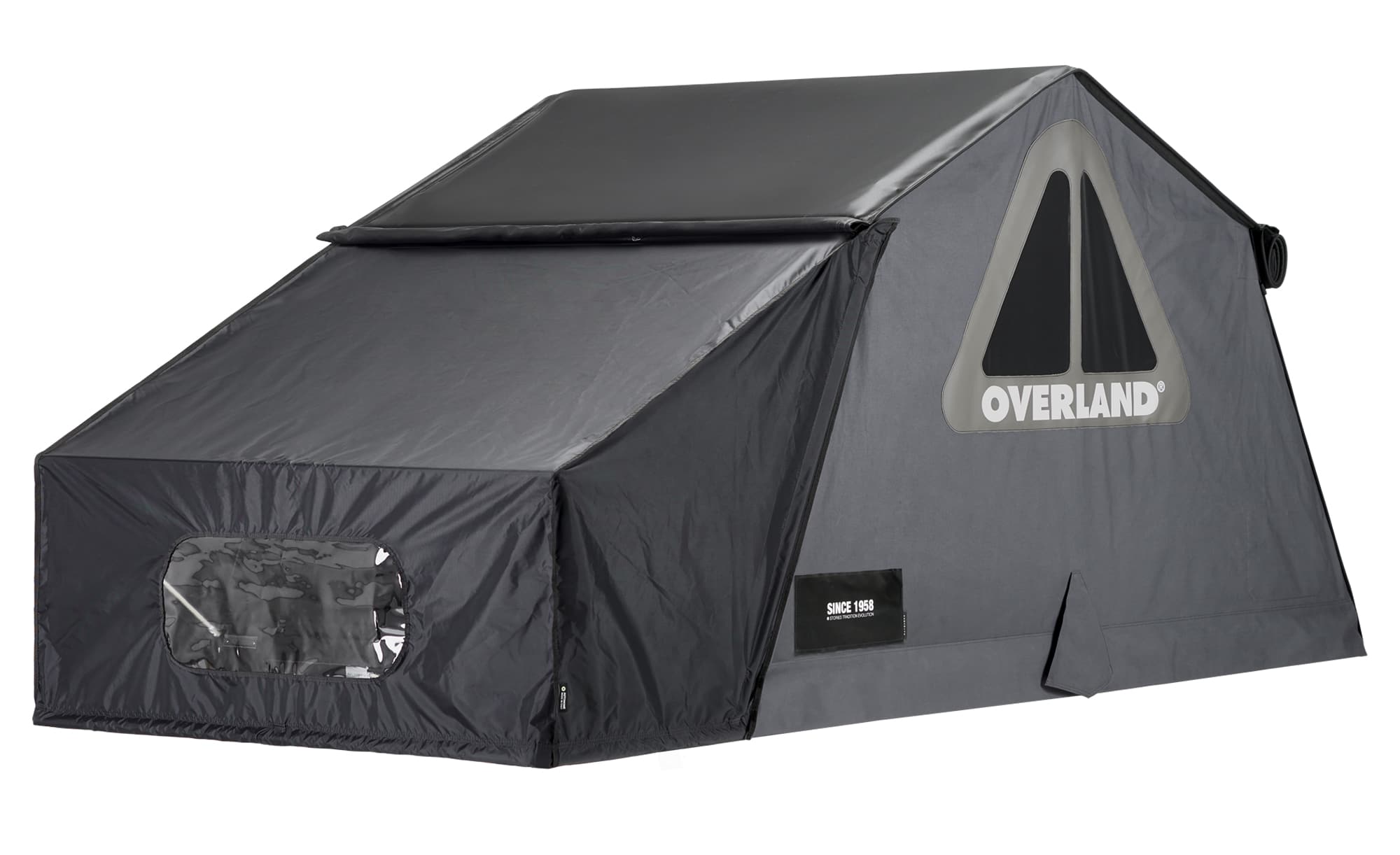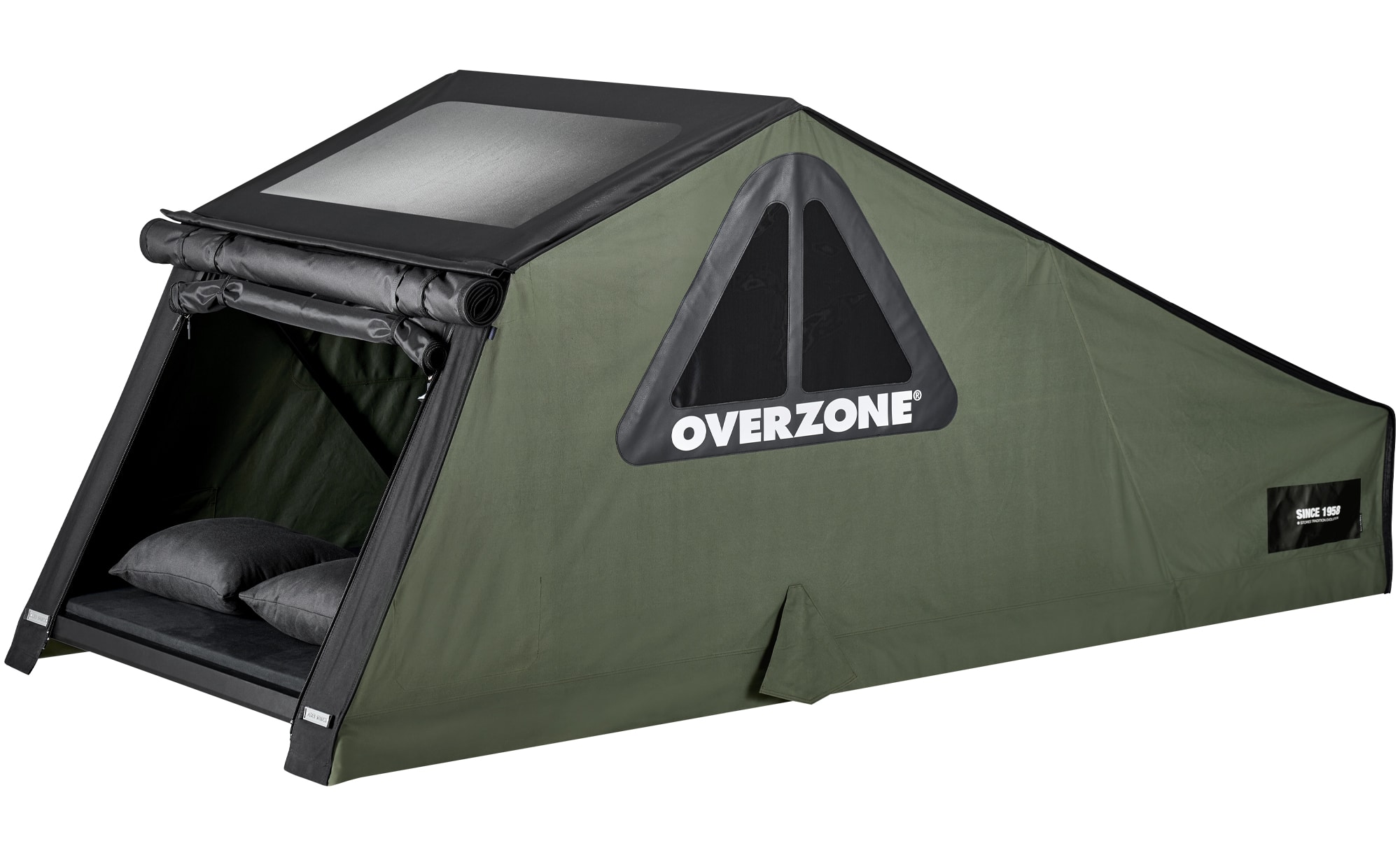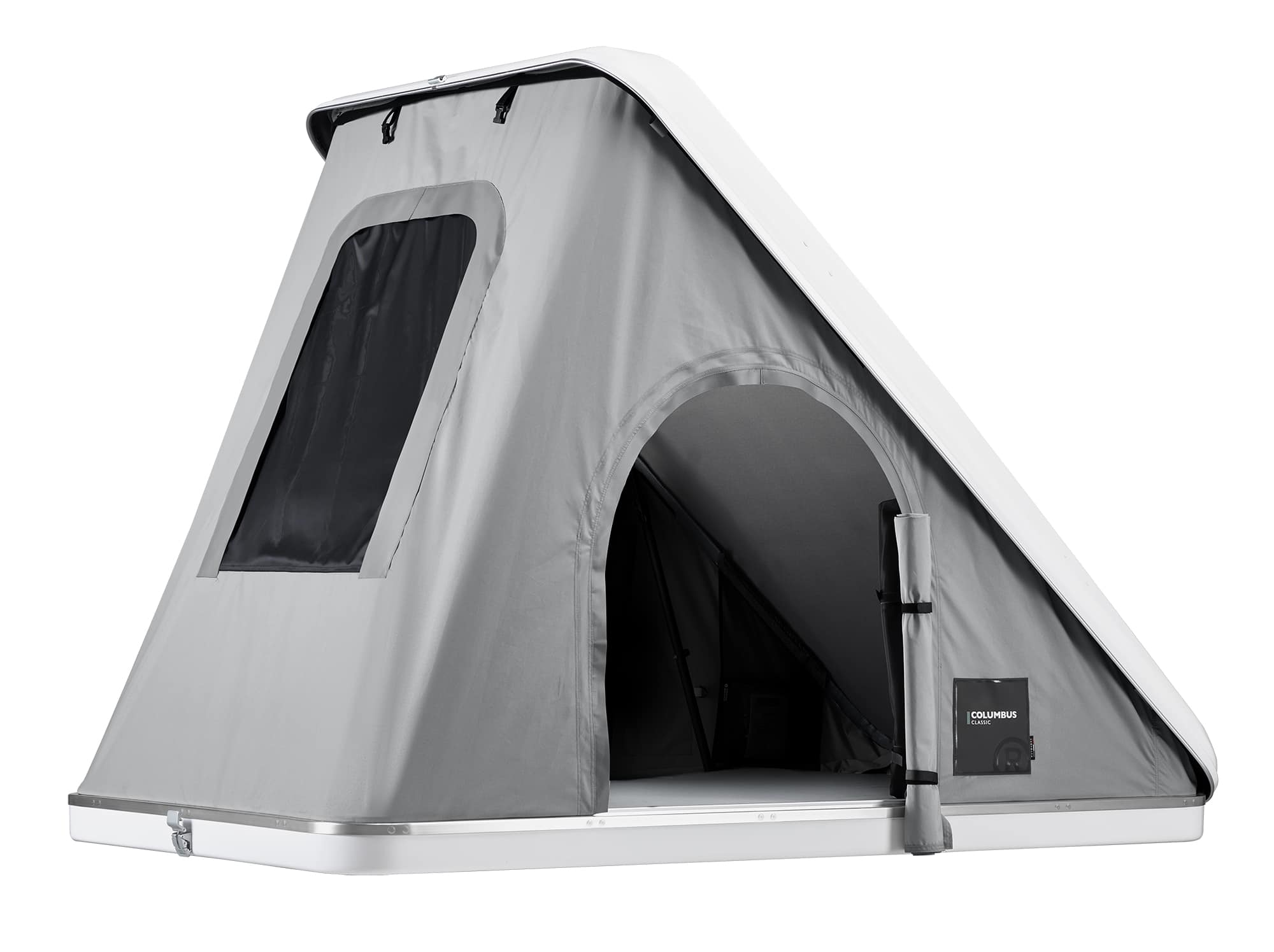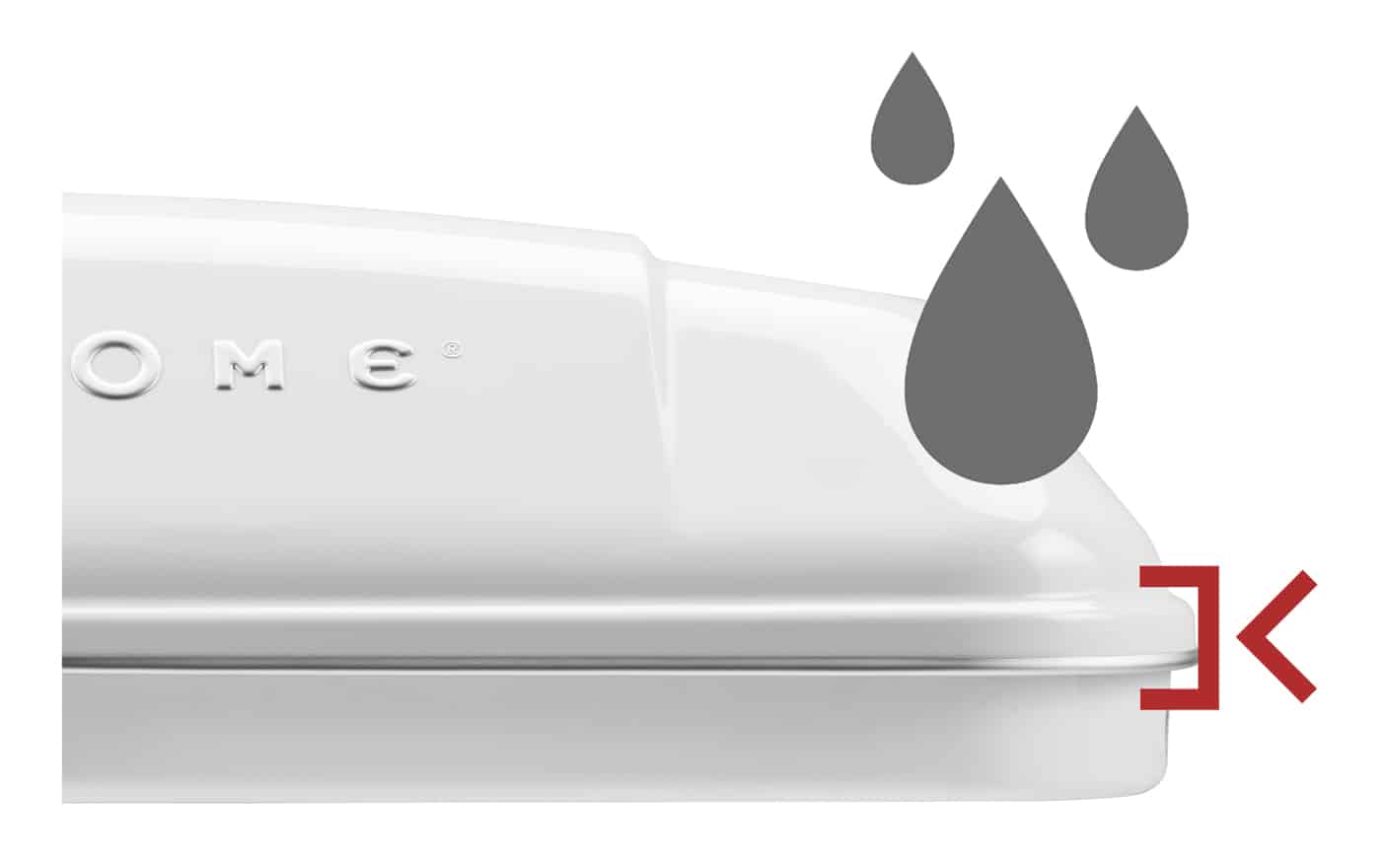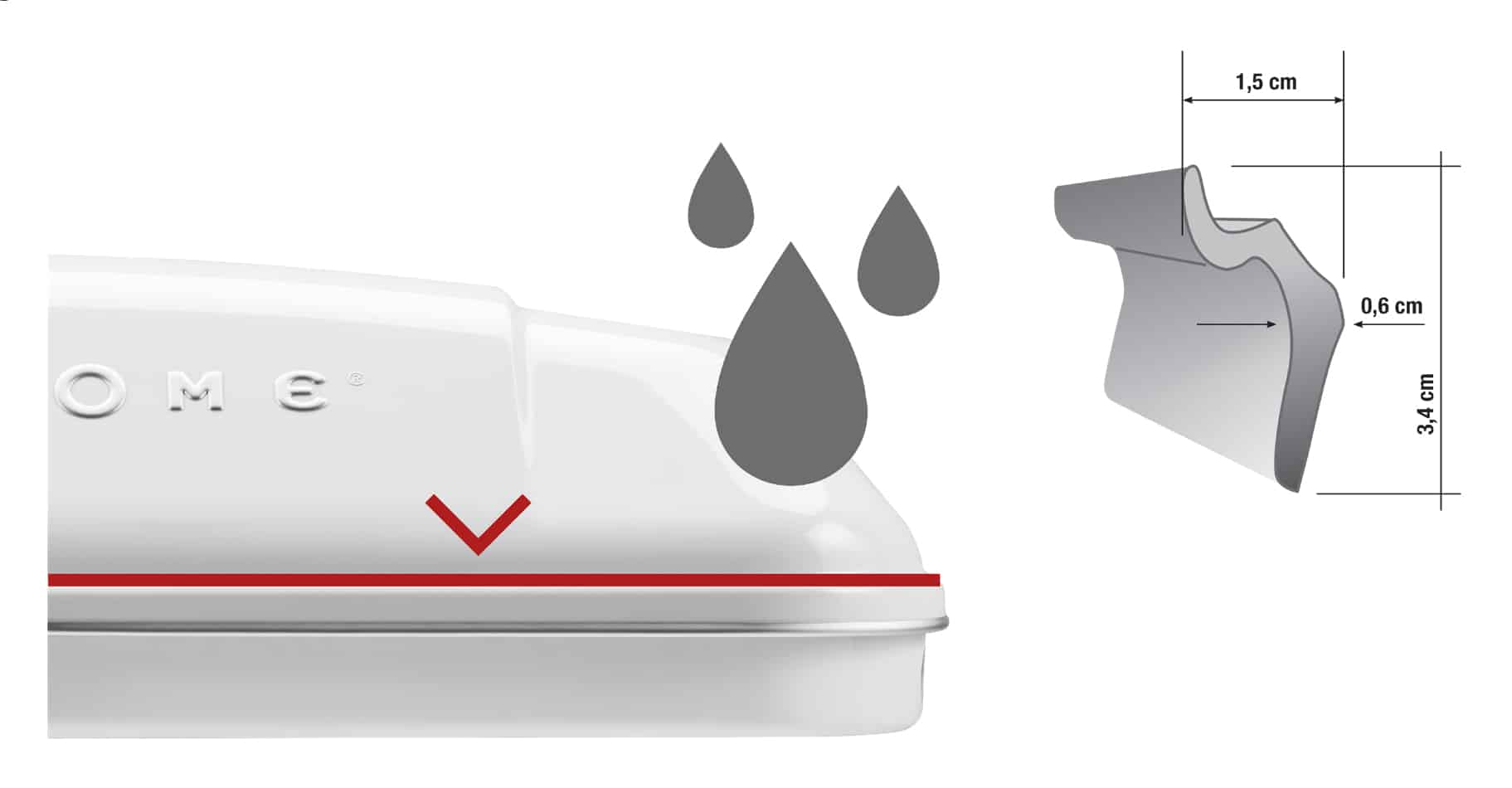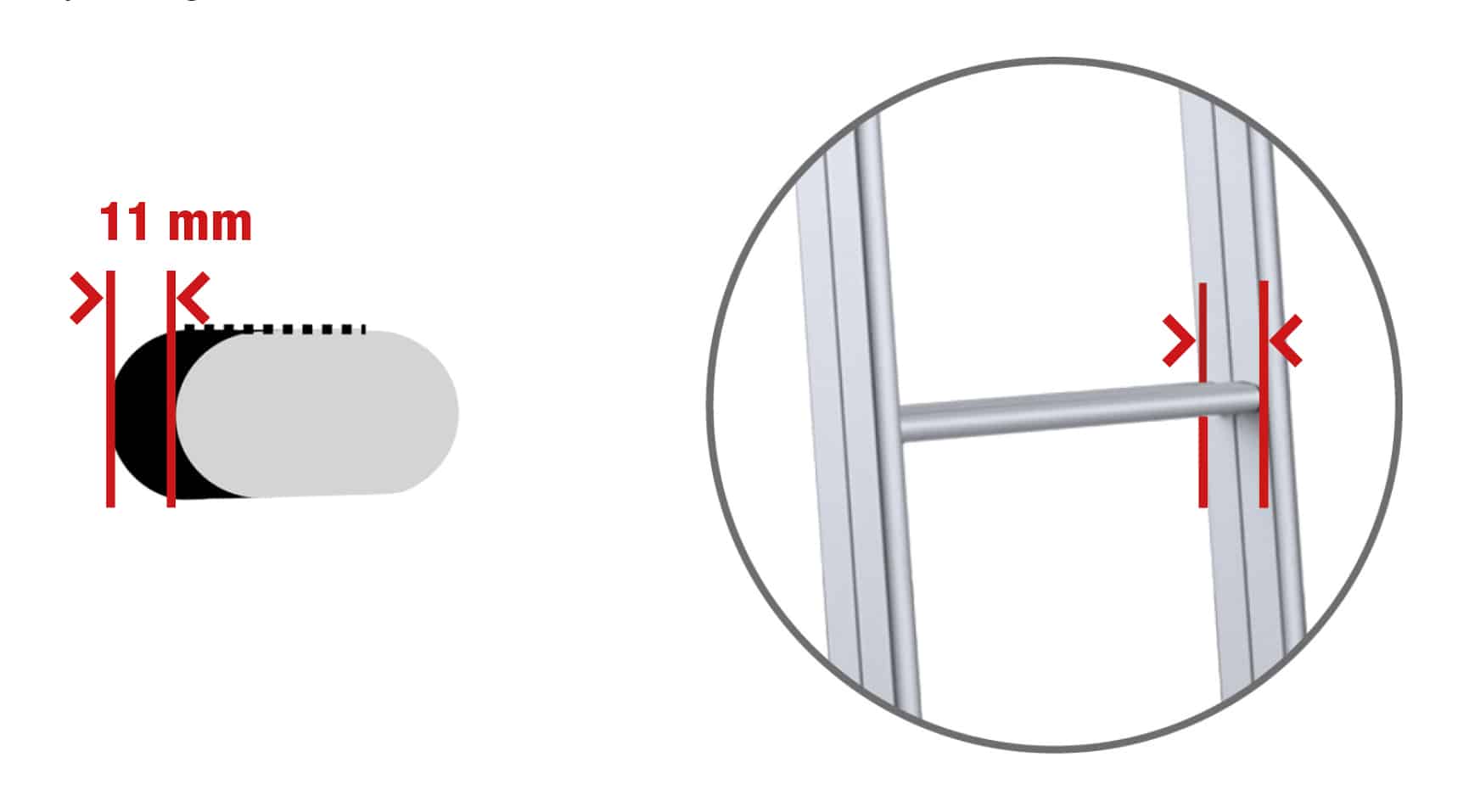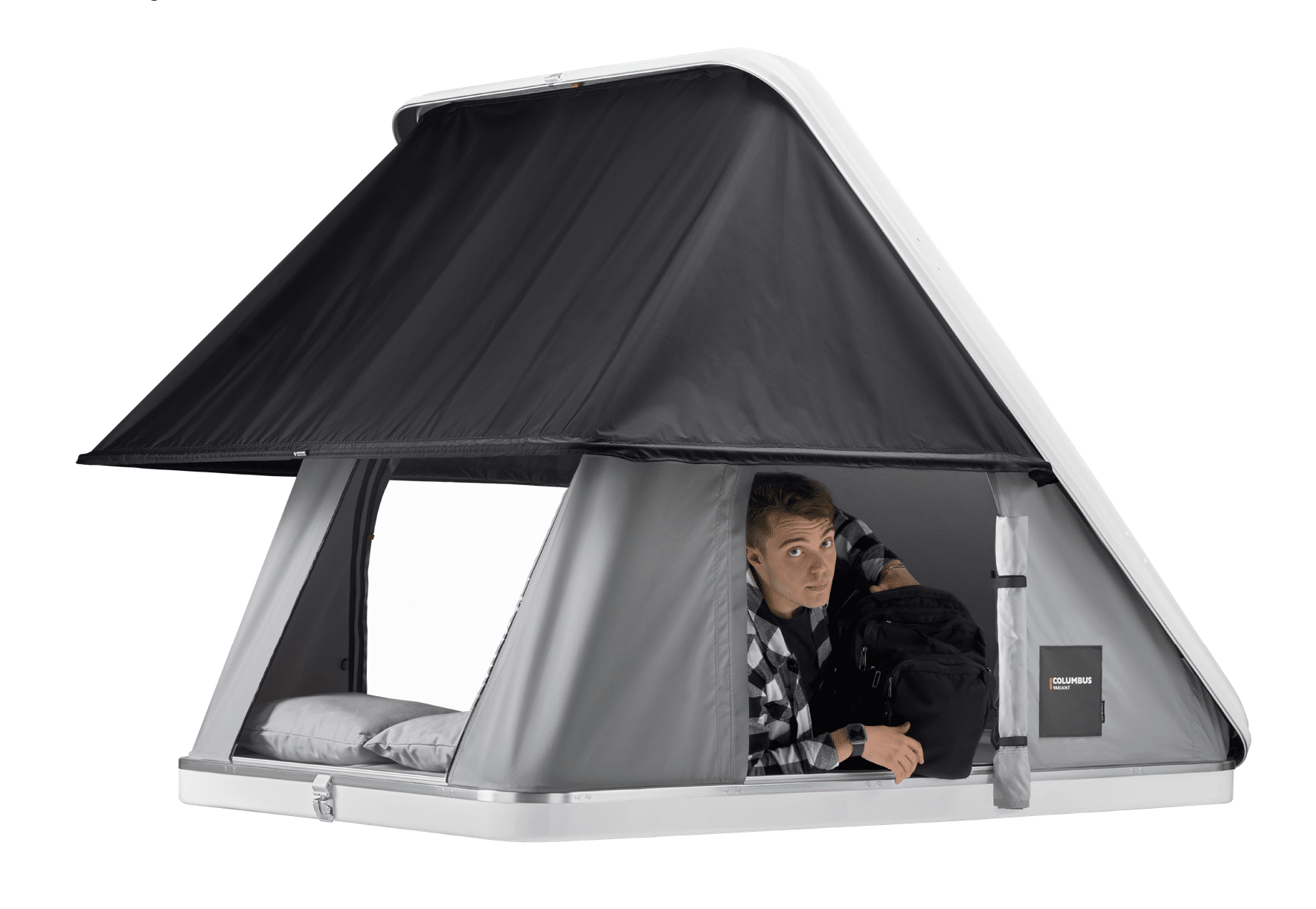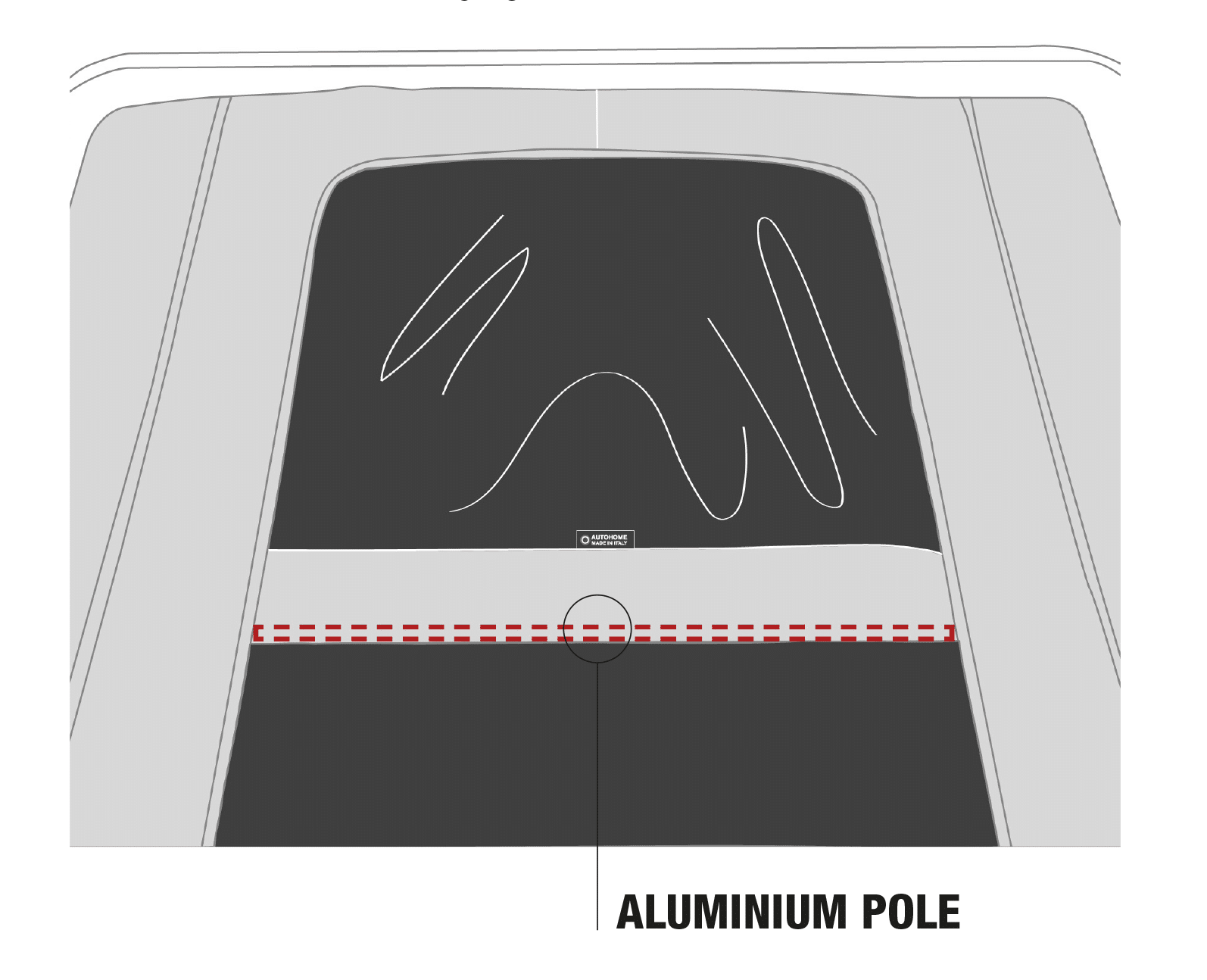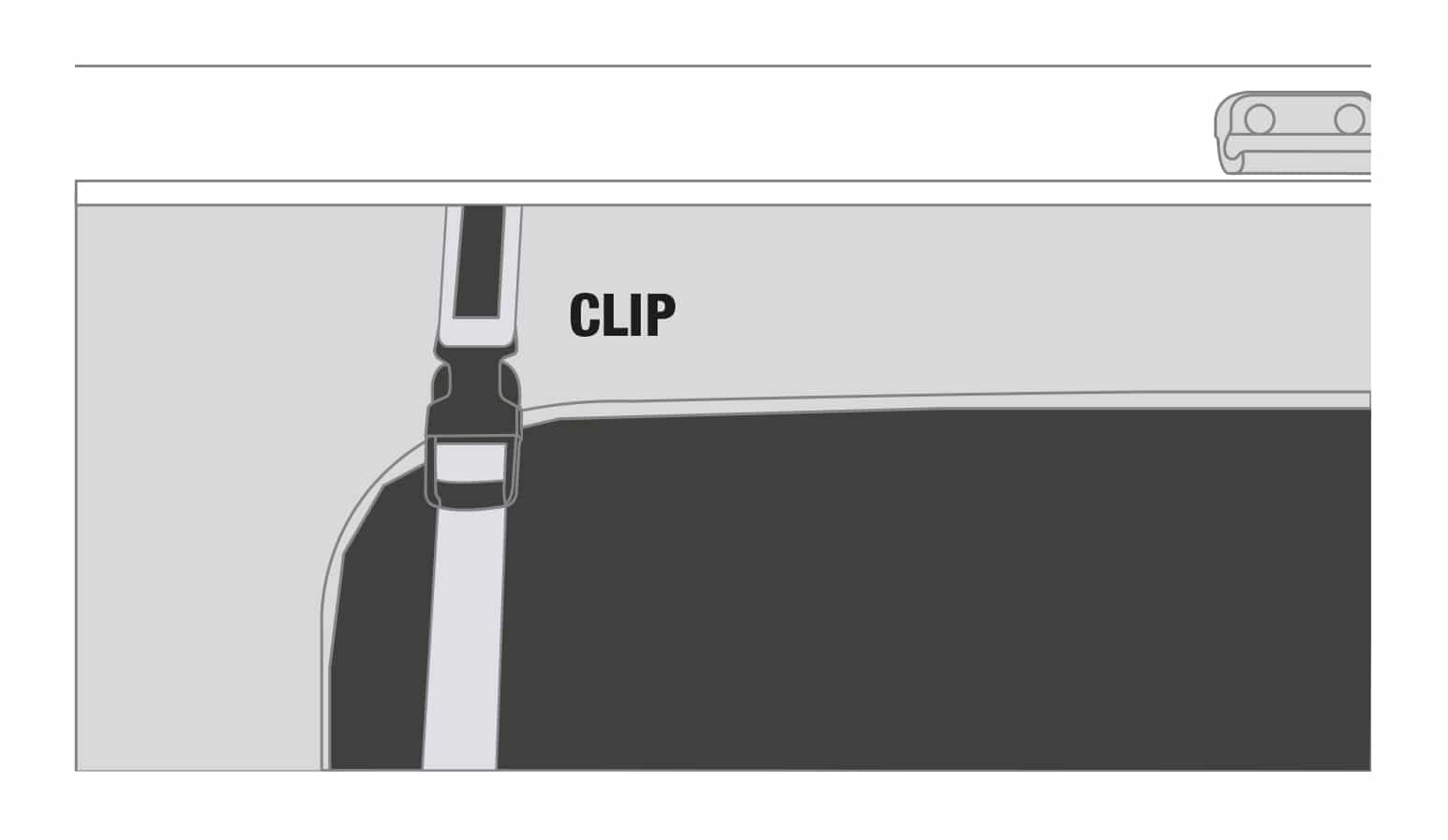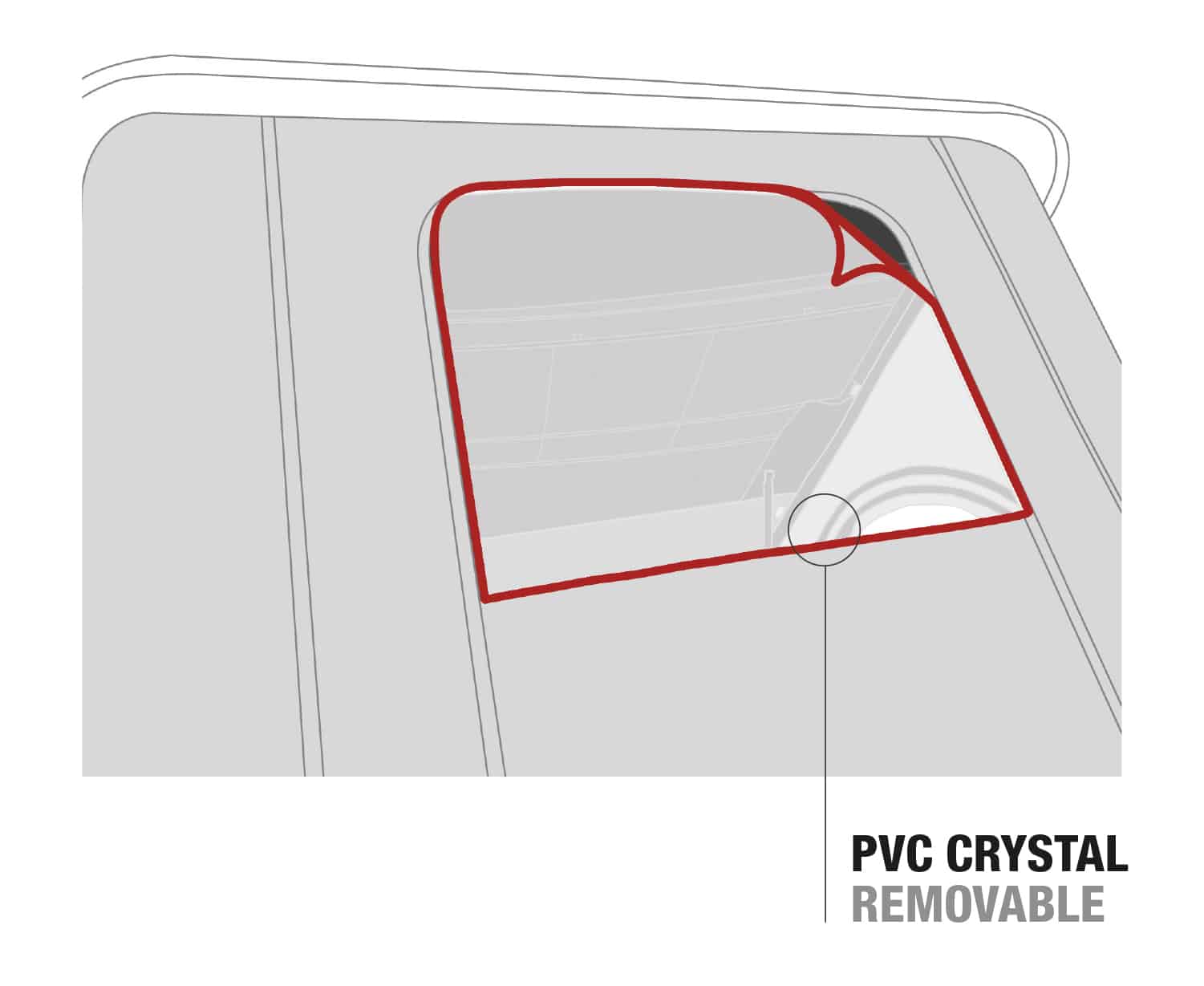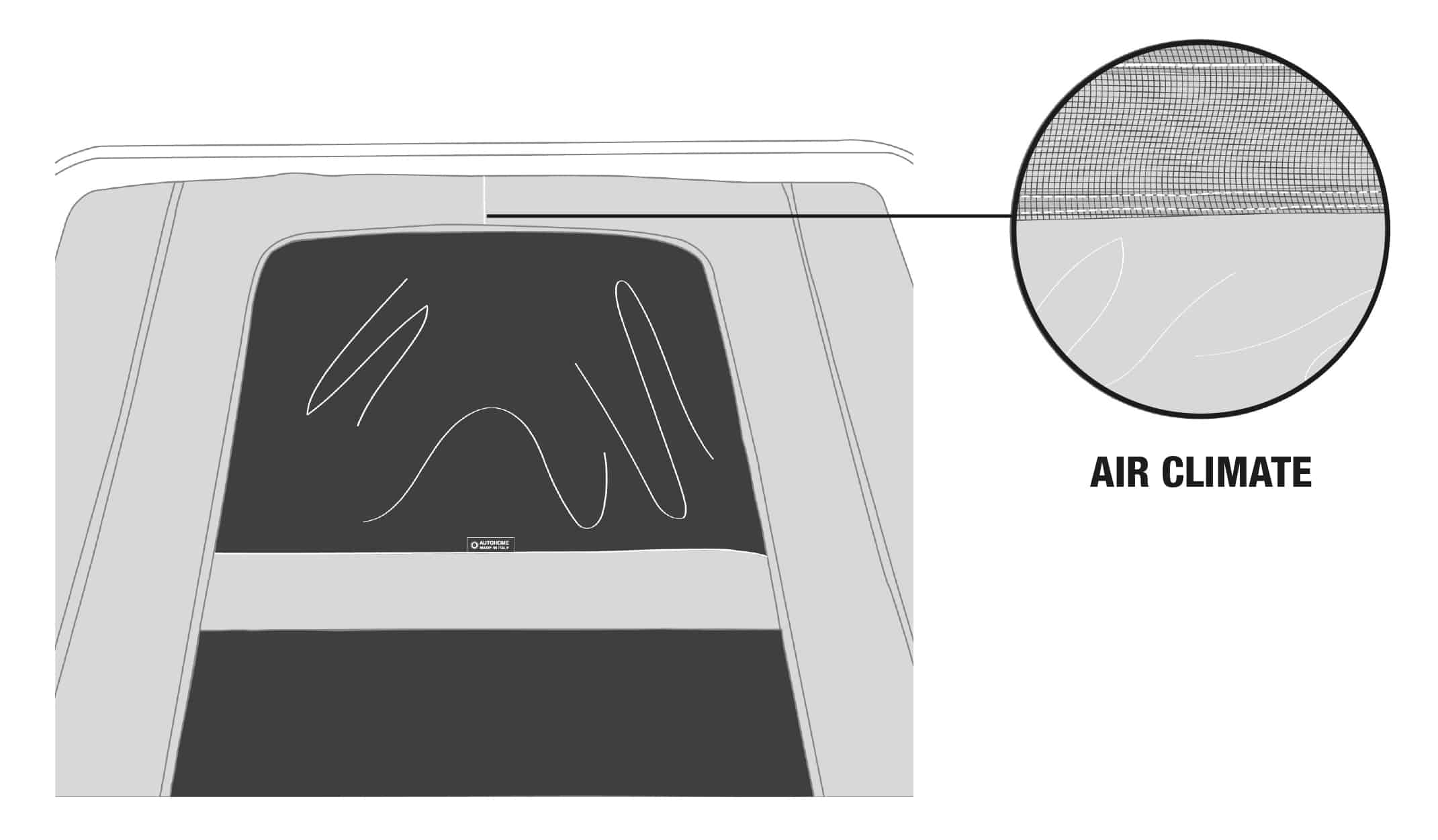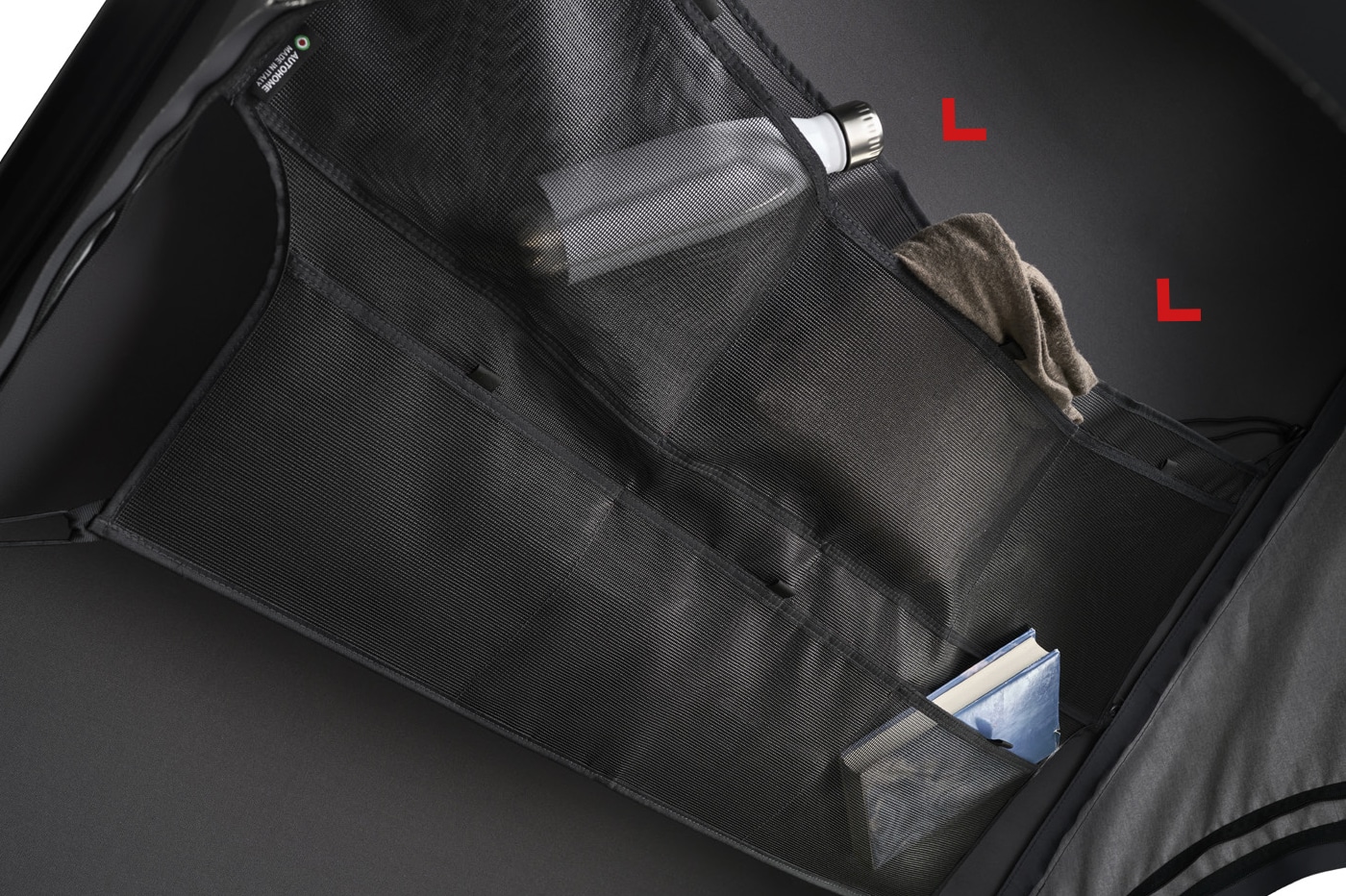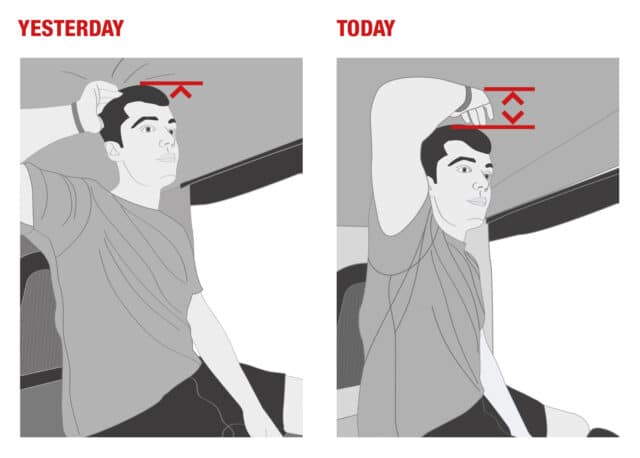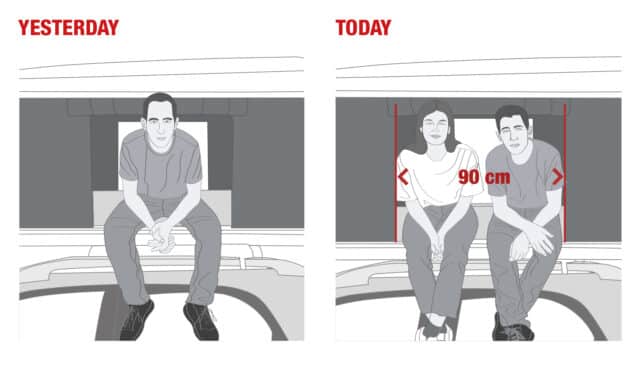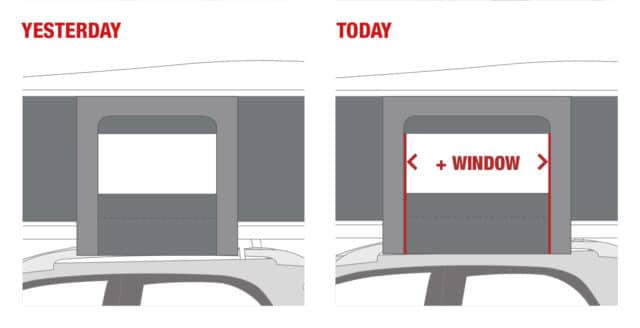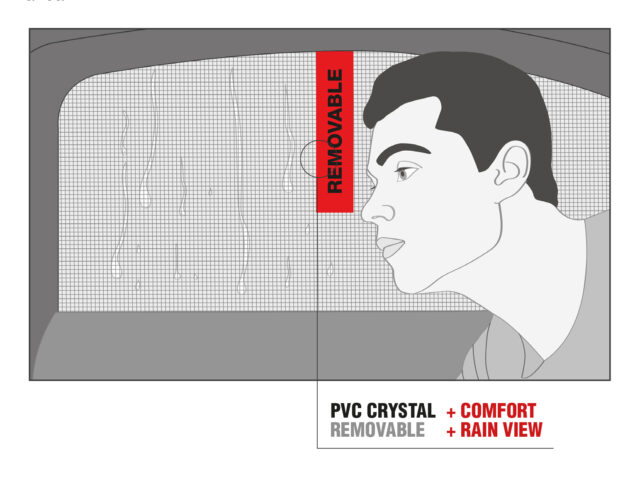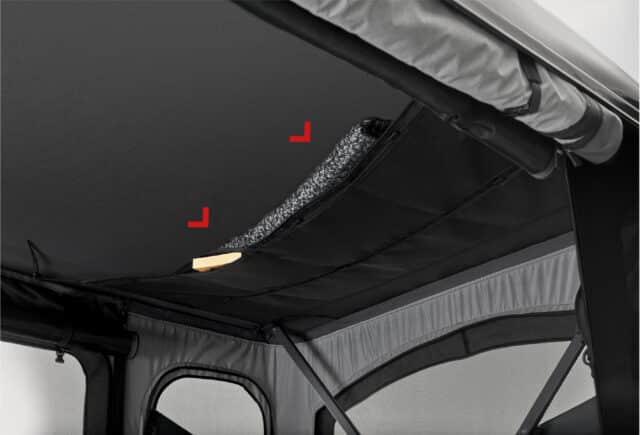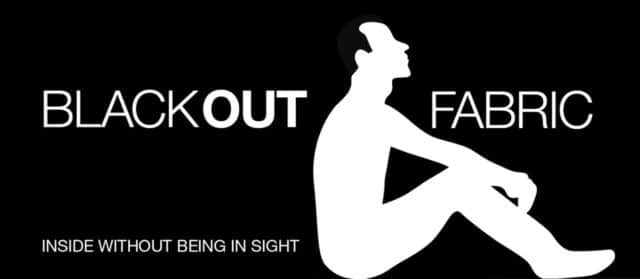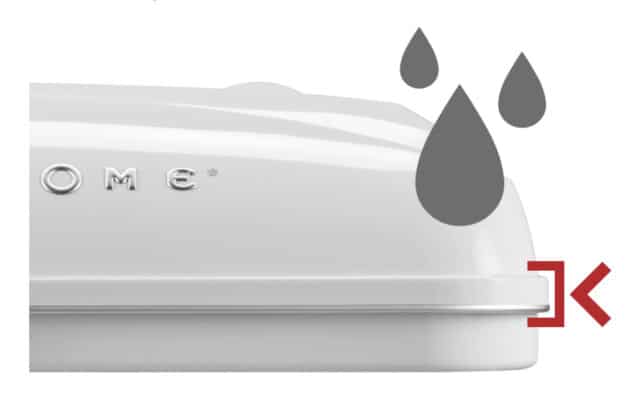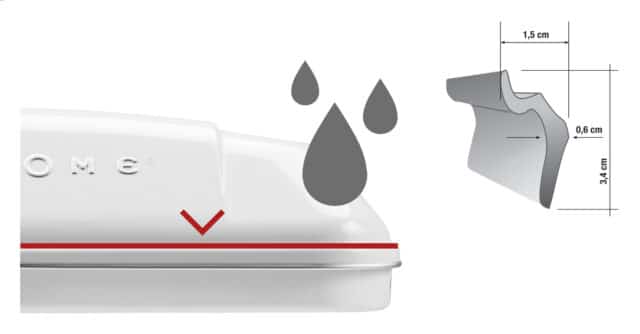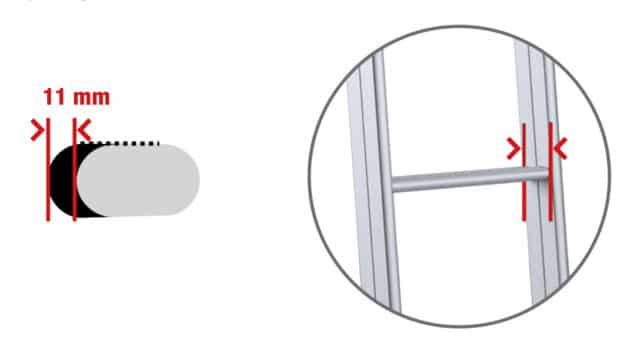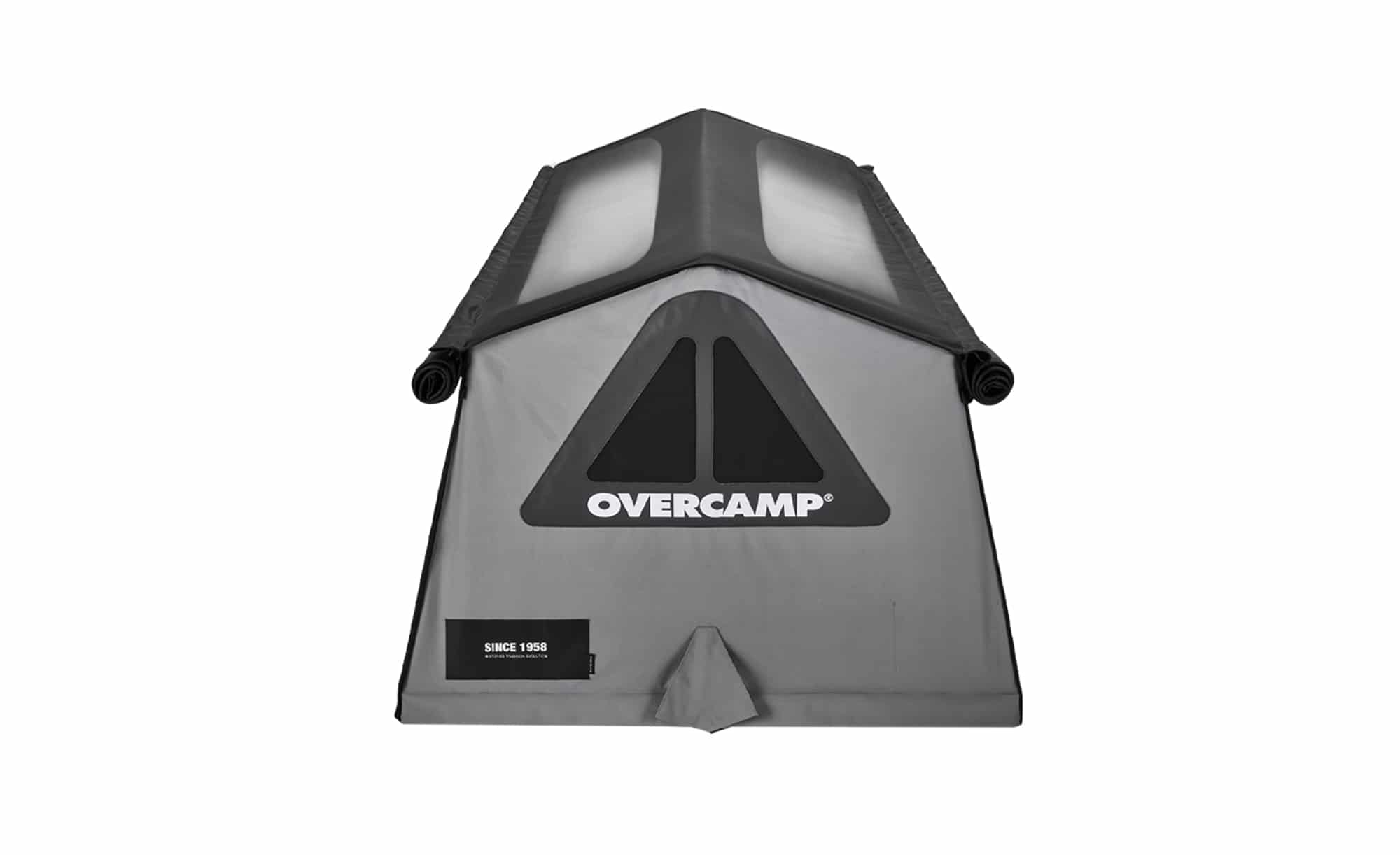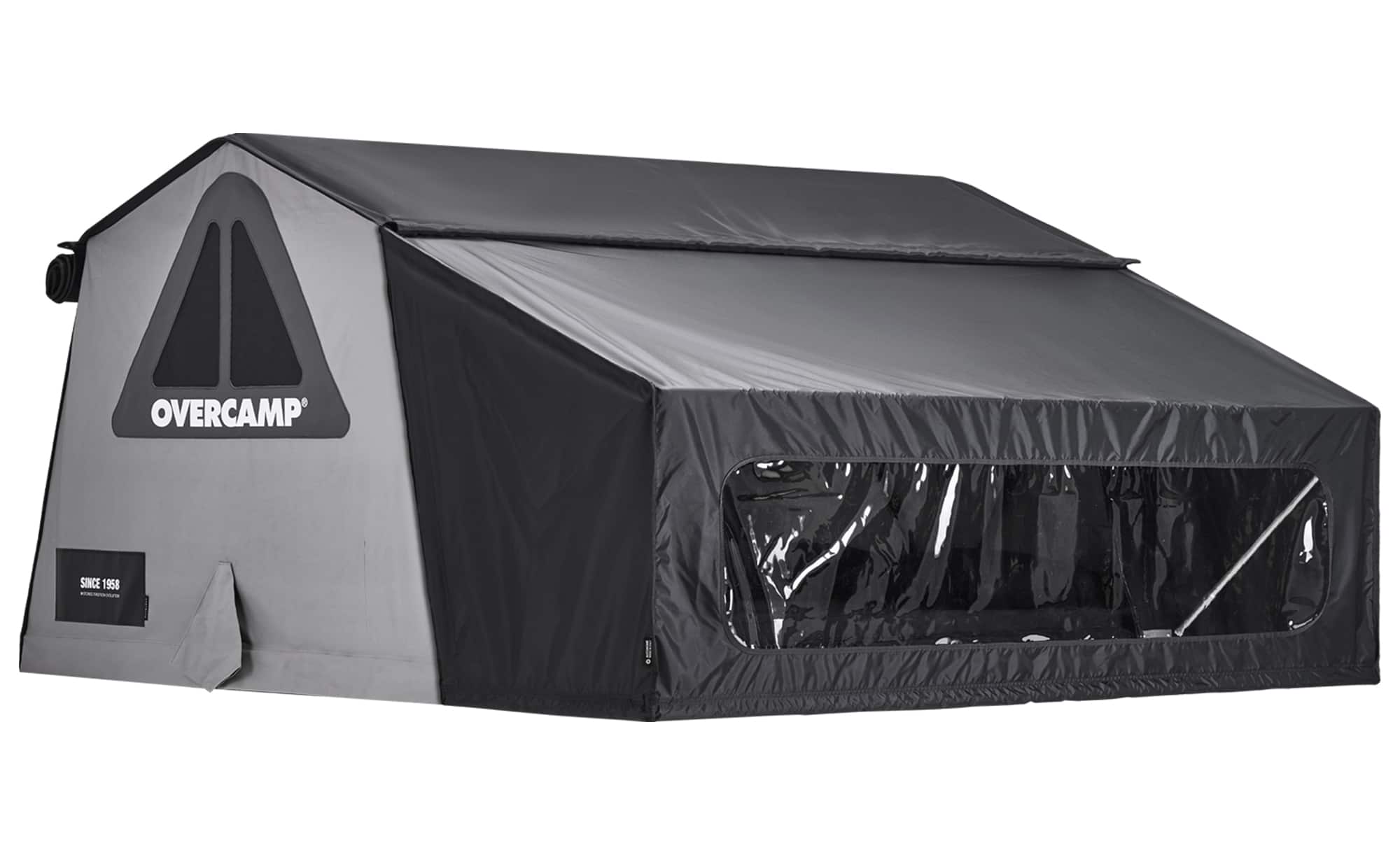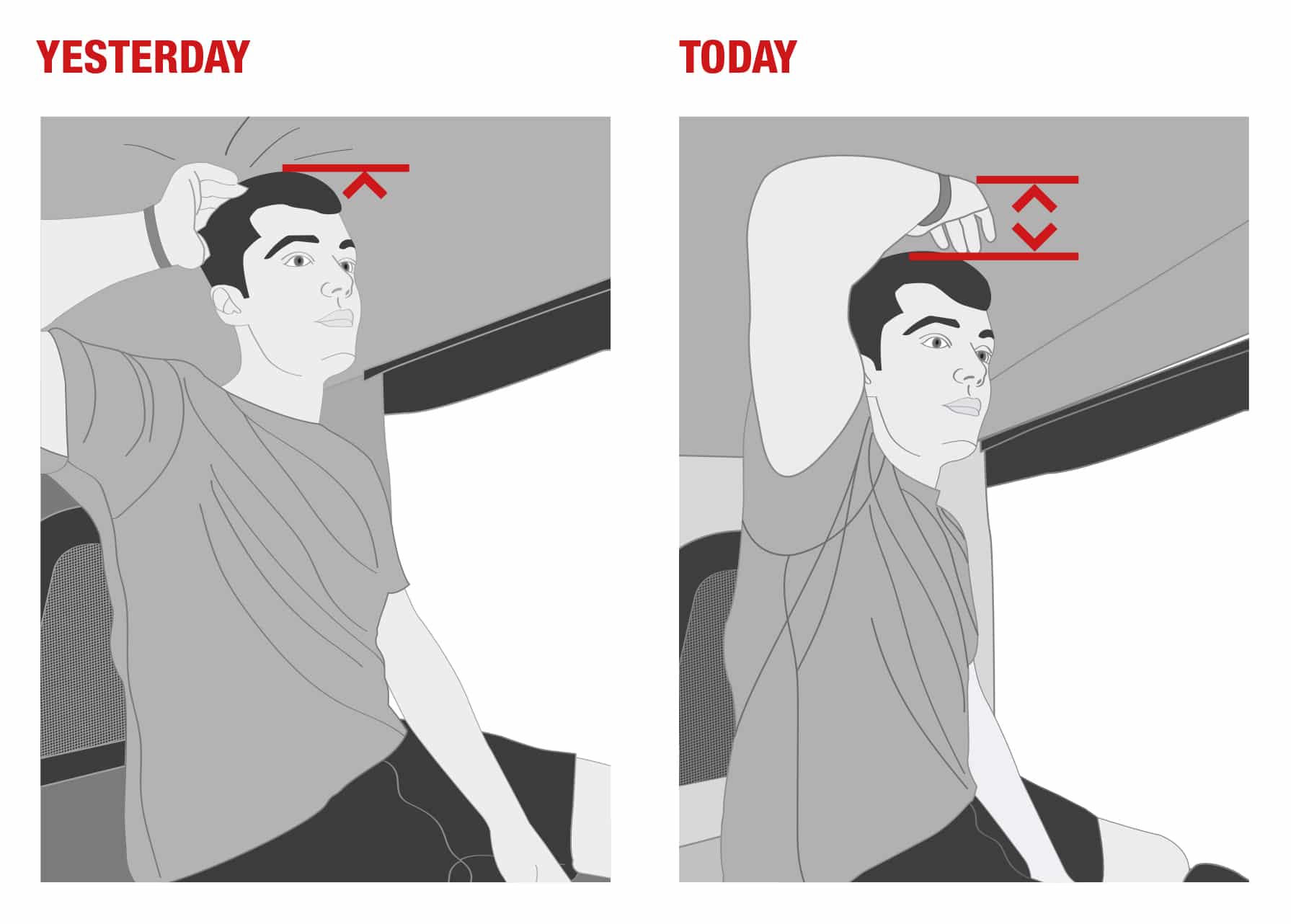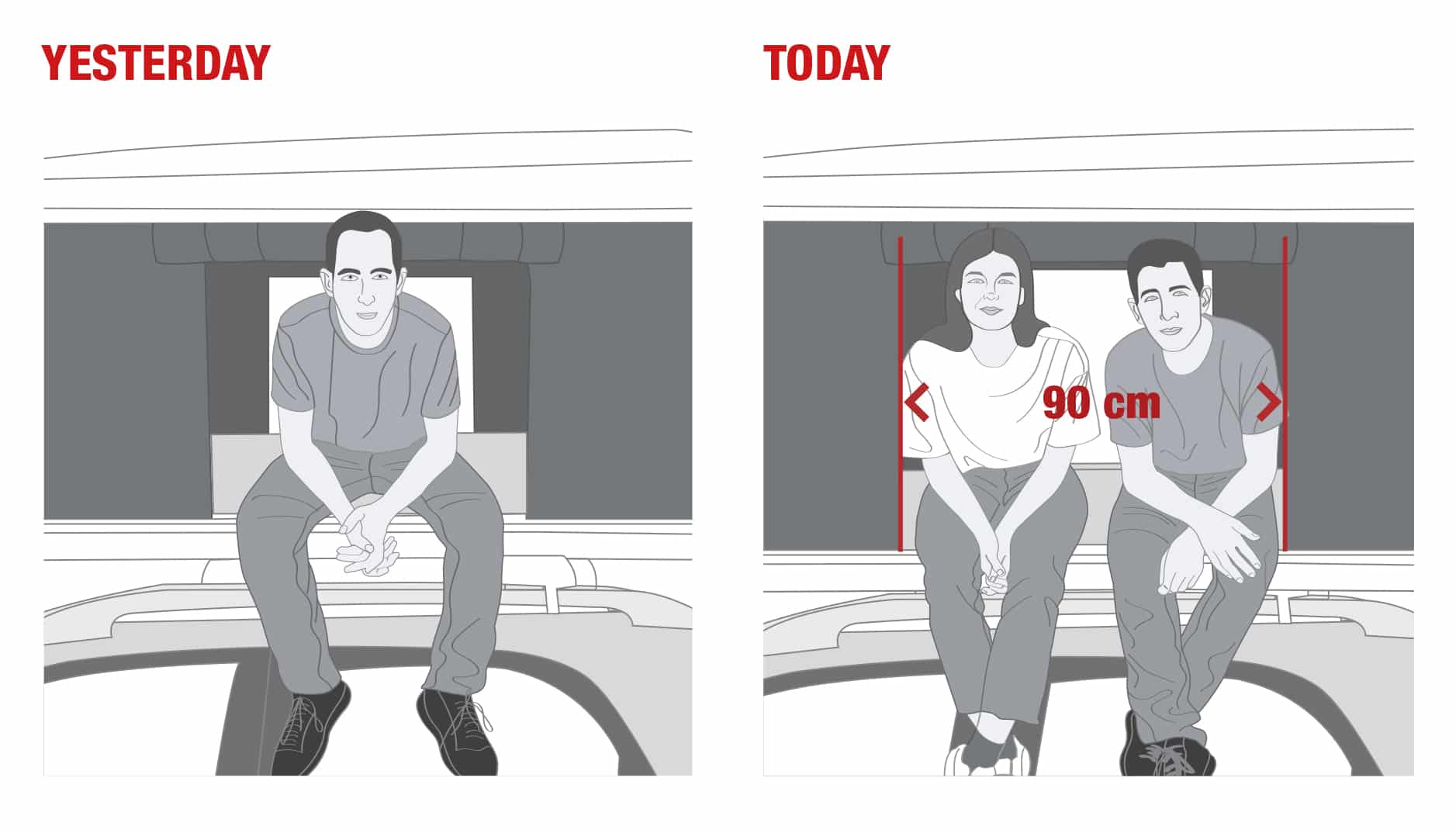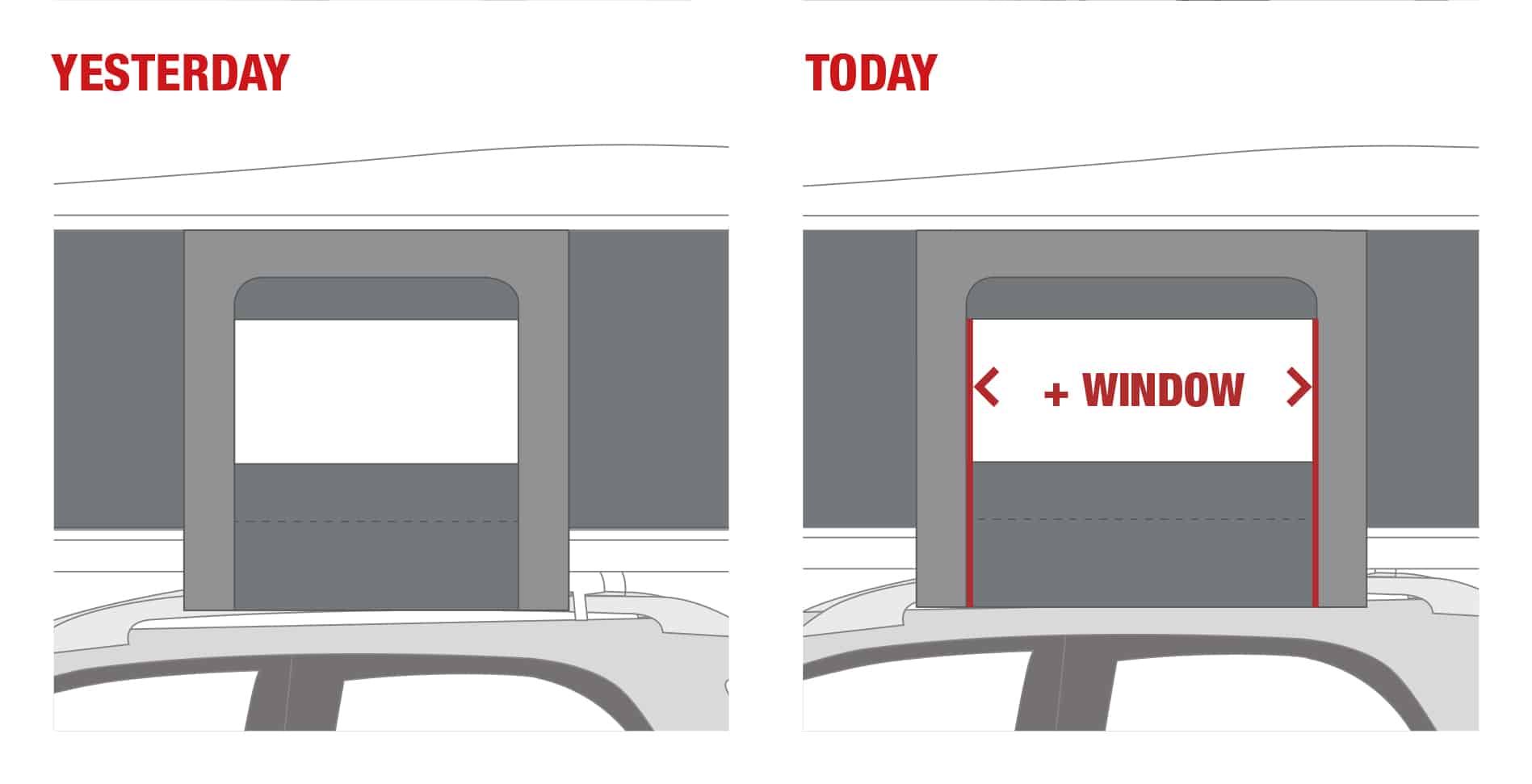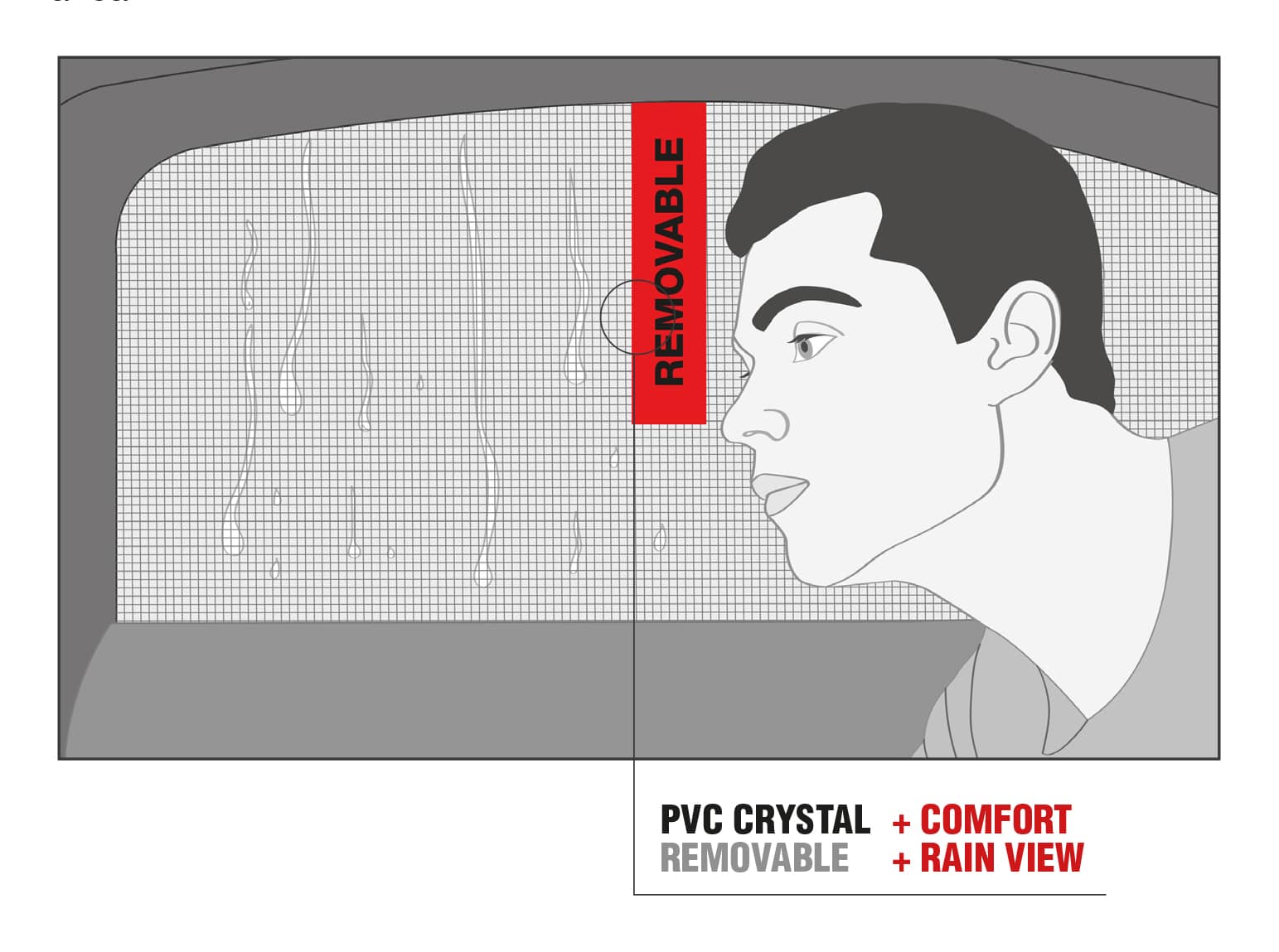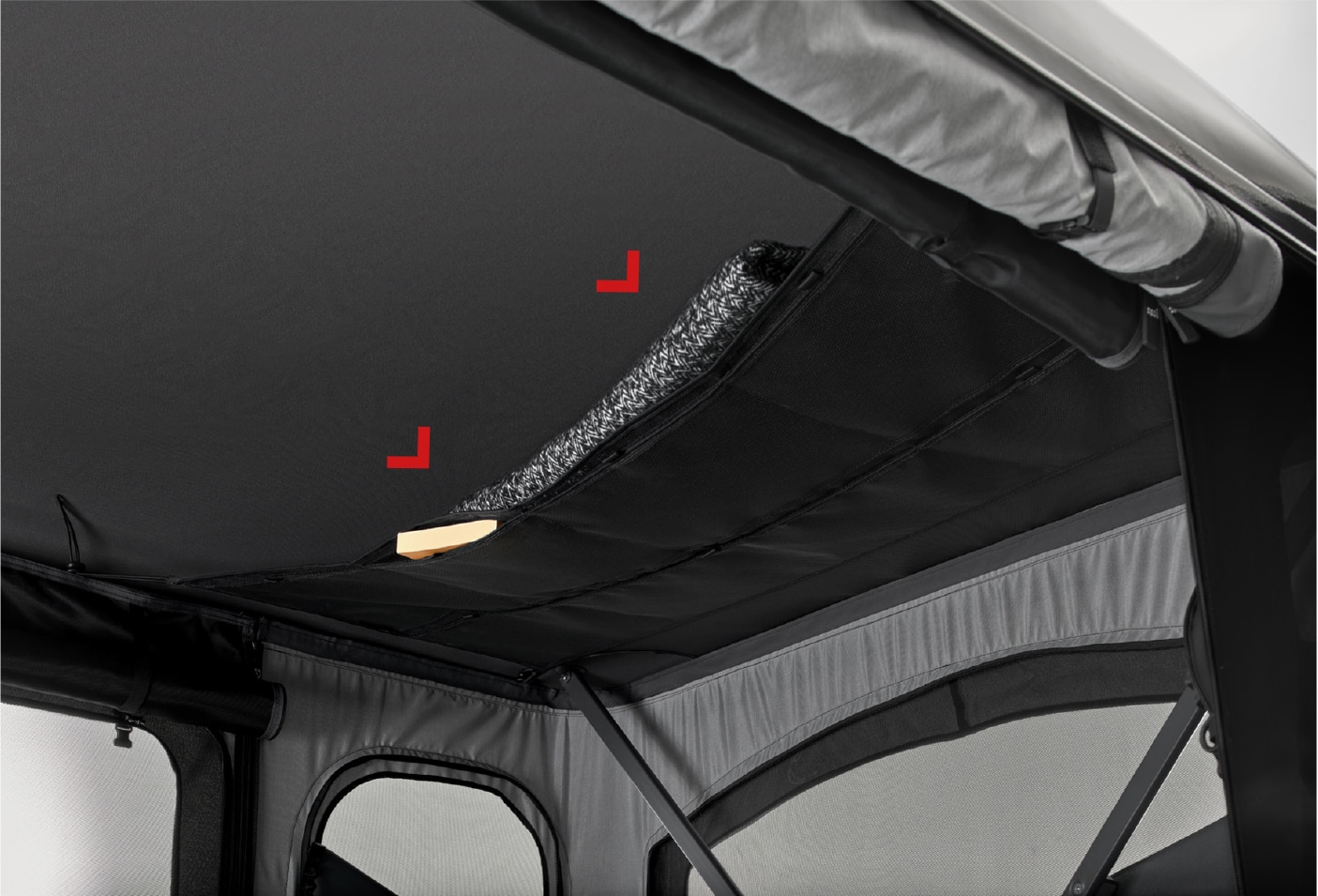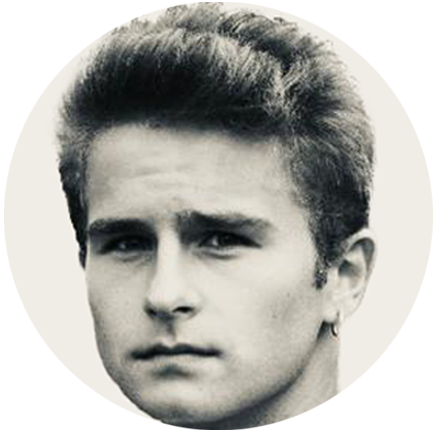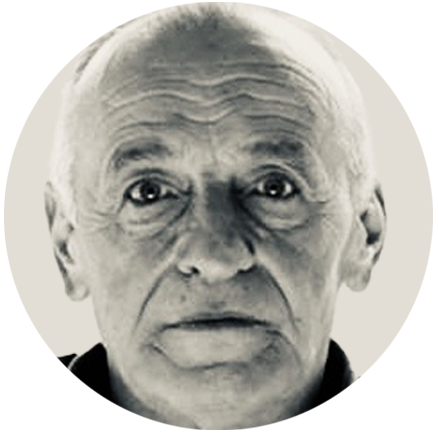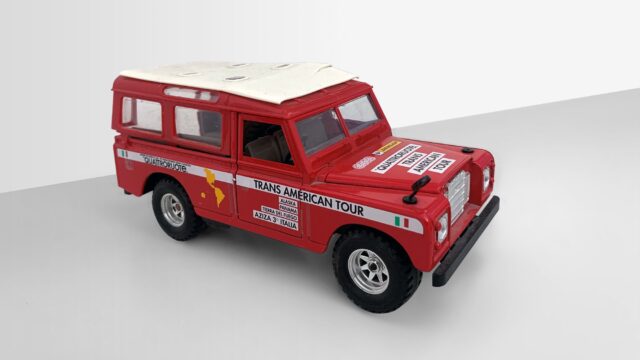ROBERTO MASCHIETTO
“I'm an off-road enthusiast, organizer of Land Rover events and not least in love with the trip that often took me away from the common routes of tourism. Today for my first solo tour of the world I chose an Autohome roof tent, Columbus Variant model, to install on my Defender 110. I started with an old '80s Maggiolina renovated several times but still a very good outdoor companion today. I am an admirer of Autohome products that I personally tested. I often found myself in a position to give advice to the company's technical staff: I did it with enthusiasm and pride. I think I gained good experience in the field; I have been following the roof tent market for years.”
“ACTIVE HARD SHELL” - PART 1
Tents in comparison
There are several roof tents on the market, but the differences in quality are consistent... Better to know them. AUTOHOME shell tents are defined by the most authoritative experts in the field "ACTIVE HARD SHELL". Namely "Tent with active roof.” A description that well represents its identity and best-in-class quality. Let's see together what it means... Let's start by talking about the top shell: it is not only the cover of the tent when you are moving, but it is the tent roof itself when it is open. 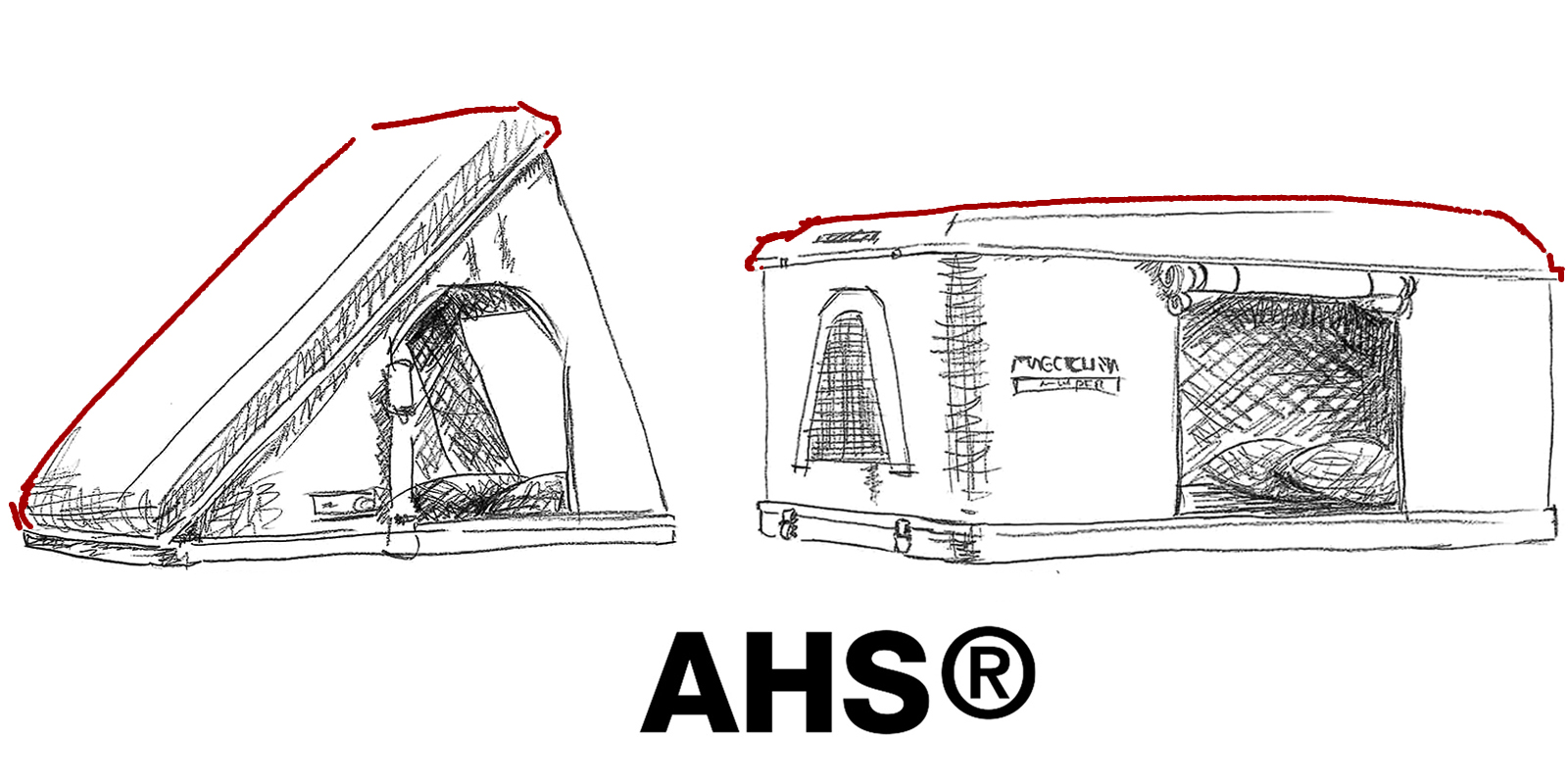
This leads to greater reliability, because the shell, when lifted, fully and actively protects the underlying environment. So, it is not a trivial passive element, a sort of wall, a simple cover without utility: it is in all respects the TRUE roof of the tent! That is why Autohome hard roofs are ACTIVE HARD SHELLS. The roof plays an active protective role. Let's now consider the advantages that this choice entails... the reasons that make Active Hard Shell an advanced project, which allows you to sleep well protected. FIRST: The roof keeps the underlying environment isolated from the heat and cold, thus less moisture and condensation. SECOND: The fabrics, thanks to the action of the roof, are less exposed to the weather. This ensures more waterproofing, protection and durability. THIRD: With a similar “active” roof, the walls of the tent are also more stable and supportive. For all these reasons Autohome stands for Active Hard Shell: the difference starts from the roof!
“ACTIVE HARD SHELL” - PART 2
Always in shape with the car
With Autohome when the tent is open and the roof in place, every structural element, from the fabrics to the service ladder, remains within the shape and perimeter of the car. The open tent falls within the space defined laterally by the car mirrors, so it does not undergo the conditioning imposed by parking areas and car parks.
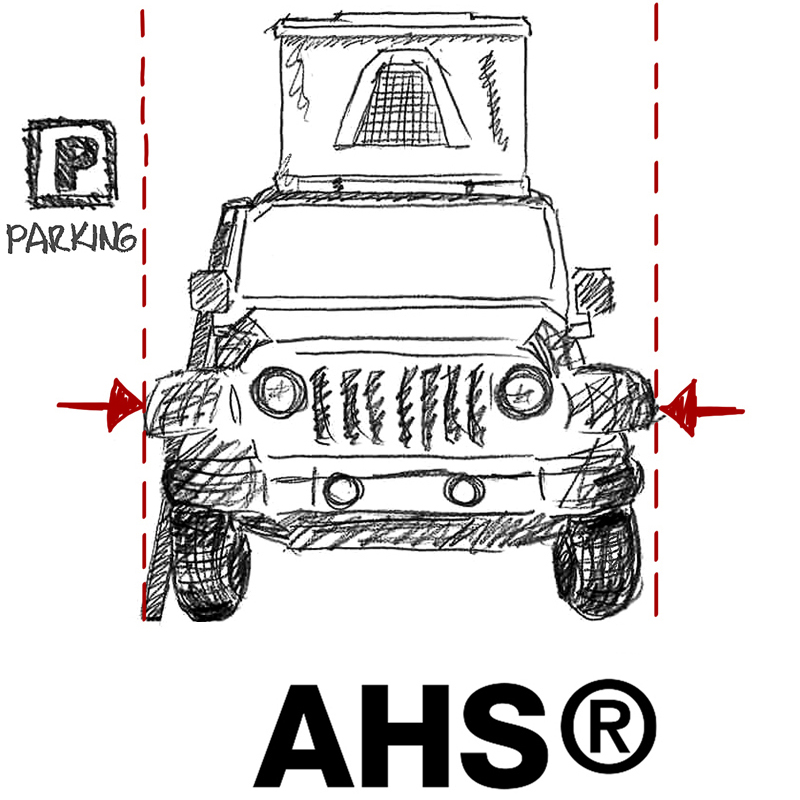
In practice, it means being able to stay anywhere, even in public areas without having to stop only at campsites. Pay close attention to this Autohome prerogative, because on the market there are shell tents or expandable models that, with a folding opening, come out of the shape of the car. They therefore necessarily require the use and overnight stay on campsites or in private areas. While with Autohome and its Active Hard Shell tents, it is possible to easily stop by a lake, a river, or the sea, in pine forests or public parks, always in complete freedom: pull the handbrake and... go to sleep! Also, for this reason with Autohome... the difference starts from the roof!
“ACTIVE HARD SHELL” - PART 3
The underside of the roof is active as well.
A unique identity, justified by numerous quality elements, capable of distinguishing itself on the market. One of these fundamental elements is the shell with active underside of the roof, or a semi-rigid inner coating designed and manufactured with great care and suitable materials: its function is in fact to concretely help counteract humidity and condensation, 24 hours a day and naturally, thus keeping the environment drier and healthier.  It differs consistently from the trivial, unreliable applied upholstery that sometimes masks poor quality with imaginative designs or eye-catching colours. Even less reliable are the low-cost finishes, almost always of Asian origin. While Autohome'S ACTIVE HARD SHELL represents a constructive principle for interiors typically Made in Italy, of high-quality standard. What makes it stand out? The presence of a double shell, a double cavity insulation, a real “second skin” that actively acts, providing for the well-being in the environment below.
It differs consistently from the trivial, unreliable applied upholstery that sometimes masks poor quality with imaginative designs or eye-catching colours. Even less reliable are the low-cost finishes, almost always of Asian origin. While Autohome'S ACTIVE HARD SHELL represents a constructive principle for interiors typically Made in Italy, of high-quality standard. What makes it stand out? The presence of a double shell, a double cavity insulation, a real “second skin” that actively acts, providing for the well-being in the environment below. 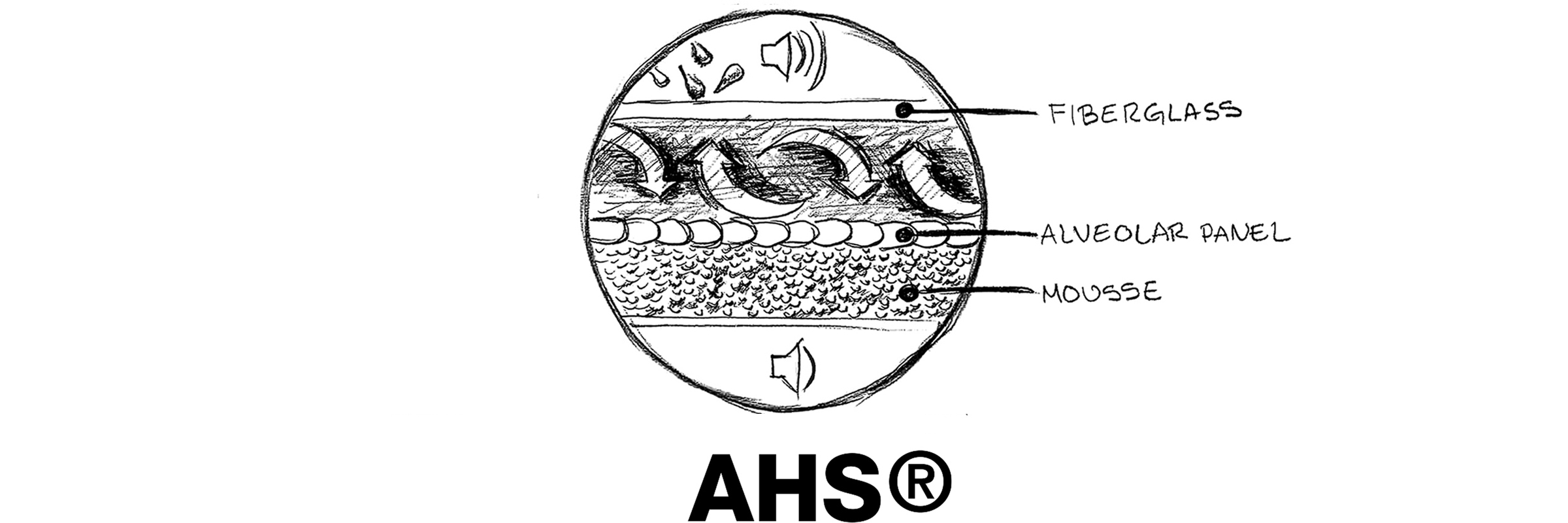
These are the choices that make Autohome standing out, the only one that can say... the difference starts from the roof!
ROBERTO MASCHIETTO
“I'm an off-road enthusiast, organizer of Land Rover events and not least in love with the trip that often took me away from the common routes of tourism. Today for my first solo tour of the world I chose an Autohome roof tent, Columbus Variant model, to install on my Defender 110. I started with an old '80s Maggiolina renovated several times but still a very good outdoor companion today. I am an admirer of Autohome products that I personally tested. I often found myself in a position to give advice to the company's technical staff: I did it with enthusiasm and pride. I think I gained good experience in the field; I have been following the roof tent market for years.”
“ACTIVE HARD SHELL” - PART 1
Tents in comparison
There are several roof tents on the market, but the differences in quality are consistent... Better to know them. AUTOHOME shell tents are defined by the most authoritative experts in the field "ACTIVE HARD SHELL". Namely "Tent with active roof.” A description that well represents its identity and best-in-class quality. Let's see together what it means... Let's start by talking about the top shell: it is not only the cover of the tent when you are moving, but it is the tent roof itself when it is open.
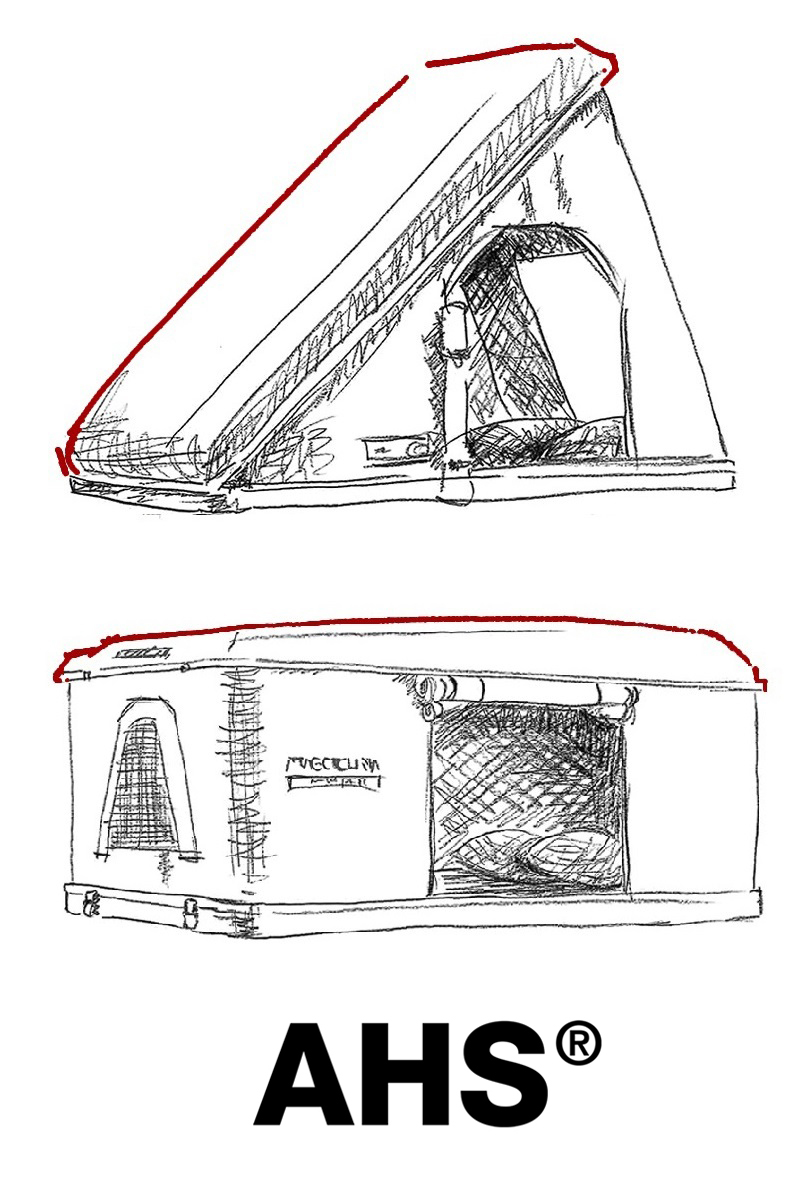
This leads to greater reliability, because the shell, when lifted, fully and actively protects the underlying environment. So, it is not a trivial passive element, a sort of wall, a simple cover without utility: it is in all respects the TRUE roof of the tent! That is why Autohome hard roofs are ACTIVE HARD SHELLS. The roof plays an active protective role. Let's now consider the advantages that this choice entails... the reasons that make Active Hard Shell an advanced project, which allows you to sleep well protected. FIRST: The roof keeps the underlying environment isolated from the heat and cold, thus less moisture and condensation. SECOND: The fabrics, thanks to the action of the roof, are less exposed to the weather. This ensures more waterproofing, protection and durability. THIRD: With a similar “active” roof, the walls of the tent are also more stable and supportive. For all these reasons Autohome stands for Active Hard Shell: the difference starts from the roof!
“ACTIVE HARD SHELL” - PART 2
Always in shape with the car
With Autohome when the tent is open and the roof in place, every structural element, from the fabrics to the service ladder, remains within the shape and perimeter of the car. The open tent falls within the space defined laterally by the car mirrors, so it does not undergo the conditioning imposed by parking areas and car parks. 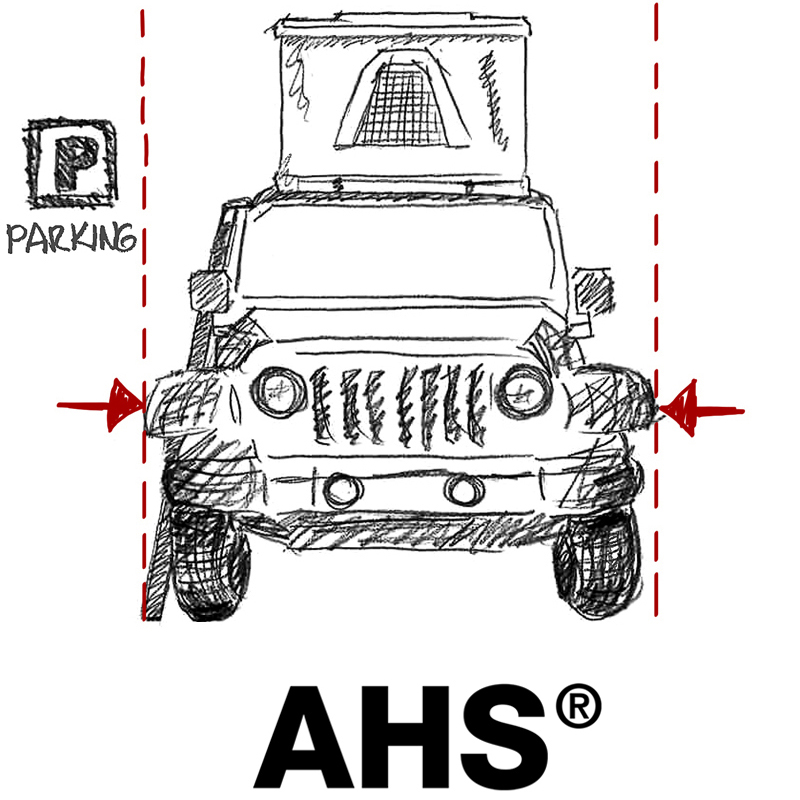
n practice, it means being able to stay anywhere, even in public areas without having to stop only at campsites. Pay close attention to this Autohome prerogative, because on the market there are shell tents or expandable models that, with a folding opening, come out of the shape of the car. They therefore necessarily require the use and overnight stay on campsites or in private areas. While with Autohome and its Active Hard Shell tents, it is possible to easily stop by a lake, a river, or the sea, in pine forests or public parks, always in complete freedom: pull the handbrake and... go to sleep! Also, for this reason with Autohome... the difference starts from the roof!
“ACTIVE HARD SHELL” - PART 3
The underside of the roof is active as well.
A unique identity, justified by numerous quality elements, capable of distinguishing itself on the market. One of these fundamental elements is the shell with active underside of the roof, or a semi-rigid inner coating designed and manufactured with great care and suitable materials: its function is in fact to concretely help counteract humidity and condensation, 24 hours a day and naturally, thus keeping the environment drier and healthier. 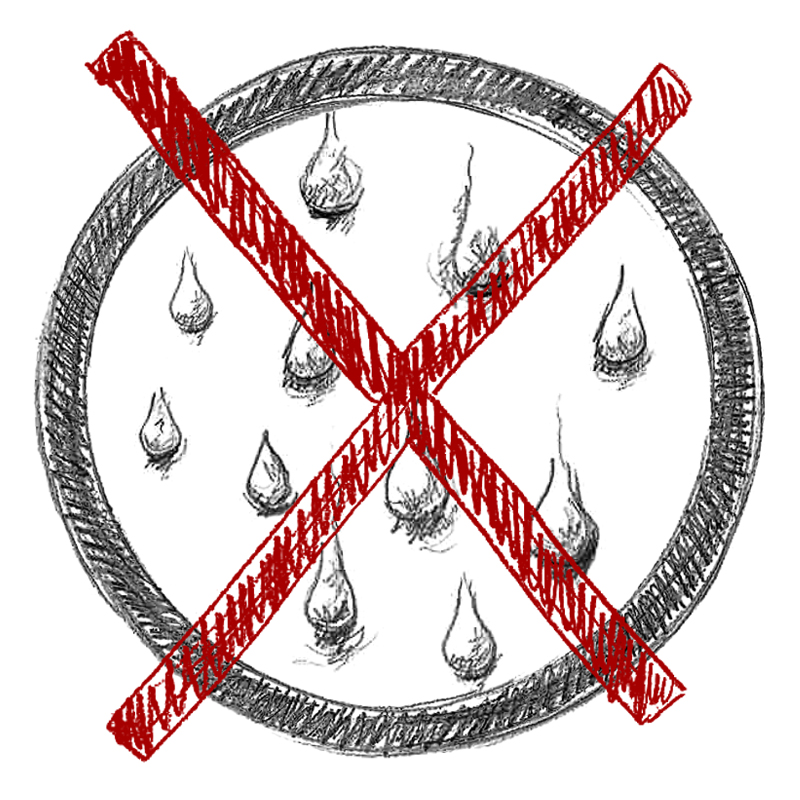 It differs consistently from the trivial, unreliable applied upholstery that sometimes masks poor quality with imaginative designs or eye-catching colours. Even less reliable are the low-cost finishes, almost always of Asian origin. While Autohome'S ACTIVE HARD SHELL represents a constructive principle for interiors typically Made in Italy, of high-quality standard. What makes it stand out? The presence of a double shell, a double cavity insulation, a real “second skin” that actively acts, providing for the well-being in the environment below.
It differs consistently from the trivial, unreliable applied upholstery that sometimes masks poor quality with imaginative designs or eye-catching colours. Even less reliable are the low-cost finishes, almost always of Asian origin. While Autohome'S ACTIVE HARD SHELL represents a constructive principle for interiors typically Made in Italy, of high-quality standard. What makes it stand out? The presence of a double shell, a double cavity insulation, a real “second skin” that actively acts, providing for the well-being in the environment below.
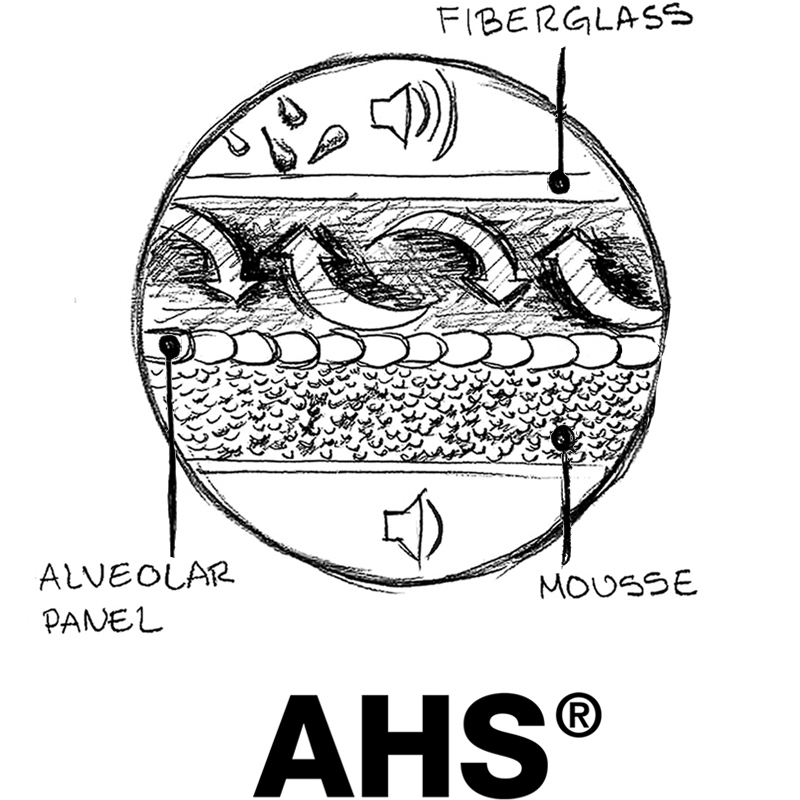
BERND WOICK
For several years, I managed stores specializing in outdoor clothing, tents and technical solutions for trekking, mountaineering and adventure travel. I started my business in 1982 in Filderstadt. Over the course of time, I also developed my commercial commitment in other German cities. I always found it important to listen to my customers' travel testimonials and I really enjoy personally testing materials and devices in the travel industry, on expeditions and tours in various parts of the world. In recent years I decided to devote myself almost exclusively to travel, in particular favouring tours based on a strong spirit of discovery in geographical areas outside the usual itineraries and such as to encourage maximum contact with nature. I particularly love travelling in a well-equipped car, thanks in part to the fact that I am an industry consultant for automotive companies. I also had a long-standing collaborative relationship with Autohome products. I directly followed the developments of the Autohome offer in the activity of my specialized shops. Together with my staff, we immediately understood the philosophy that guided Autohome and the technical-constructive choices that made it a reality of excellence, distinctive on a market where, unfortunately, improvisation existed and still exists. On the contrary, Autohome immediately pursued the path of quality. That is why we chose in our business to make it one of the mainstays of the offer. A decision that proved to be correct from every point of view, as demonstrated by the increasing success of Autohome roof tents even in extremely demanding and prepared customers. I always recommended roof tents since the beginning of their diffusion, over twenty years ago, because I knew their characteristics well in terms of practicality, comfort and safety. We can safely say that it was the roof tent that made the car more functional and competitive than other solutions for sleeping at night. Today this concept is acquired, but not completely. There are still many who do not know the differences well. So let us see together to point out some important aspects.
MAGGIOLINA®
Maggiolina, for example, everyone knows it and it is probably the most popular roof tent in the world. In the choice, however, it is important to remember first of all the "dimensions" aspect. For those who have a rather sturdy build, I suggest to prefer the Medium model. For those who have a normal physique and love aesthetic perfection, I suggest to choose the small because it is already well liveable. It also looks good on small cars. For those who are taller than 185 cm, it is best to choose one of the X-long versions, which provide comfort even for taller users. If you want even more space inside, both closed and open, it is better to prefer the Grand Tour model: inside it is a bit higher. While the Airlander model, it is slightly lower but more streamlined.AIRTOP®
Airtop is often chosen by those who own medium height vehicles. Experience confirmed this vocation. In this sense, it is interesting to remember that Airtop is the tent of choice for MINI BMW. Produced by Autohome exclusively for the MINI Countryman market. A fact that is certainly significant. It should be remembered that even Airtop, like Maggiolina, when open, always fits into the shape of the car and does not protrude from the car mirrors. This means that you can stop and camp with your tent open even in parking lots or other public areas, avoiding the imposition of "camping area only".
COLUMBUS®
Columbus is the Autohome model characterized by a sloping roof, typical of the aesthetic tradition of tents. The opening is immediate and instantaneous, thanks to only two gas springs that bring the upper shell to a height of about 160 cm. It is the tallest tent in the Autohome offer. It is a favourite model for those who own tall vehicles and for those who want a rear entrance. While devoted to practicality, Columbus respects the high quality Autohome, starting with the shells that are made of fibreglass, with all the advantages that this material offers. In addition, the roof is ventilated: insulating and anti-condensation, soundproofed even in the rain thanks to a thick mousse. The quality of the fabrics is another element that stands out and makes Columbus a quality tent: they are in fact fabrics that boast a high capacity for transmitting water vapour to the outside.
AIR-CAMPING®, OVERLAND® e OVERZONE®
Air-Camping was my first adventure companion: initially on solo tours and then travelling with my whole family. This tent is a specific range of Autohome together with Overland, Overzone. I can confirm that they are excellent curtains in use and offer great internal liveability. In particular, their habitability stands out when they are opened and they are of minimum encumbrance when they are closed: in fact they leave half of the roof of the 4x4 free, so as to allow the loading of other material on the door everything, which is very useful in every travel-adventure. Today they also rightly became a choice for moving around with the family or for those who love a comfortable camping, thanks to their versatility in use. They are even used on the ground in combination with the many accessories that allow a comfortable and long stay.OVERCAMP®
Always from this point of view, a specific quotation deserves Overcamp, a modular tent that lends itself to multiple personal choices of use. An extraordinarily practical model when combined with the veranda on a campsite. Today it is considered not only the tent of the sportsmen, but also the friend of the family, because it allows an excellent independence in the rooms. Fantastic when using 2 matching tents to have a really large and important space.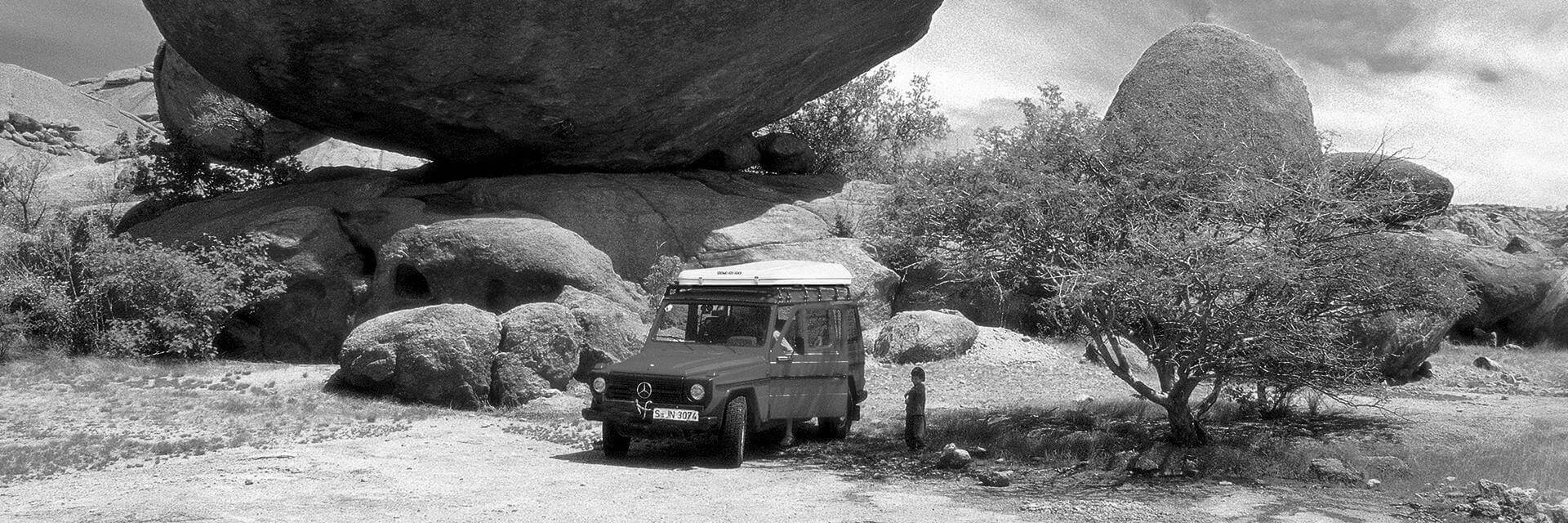
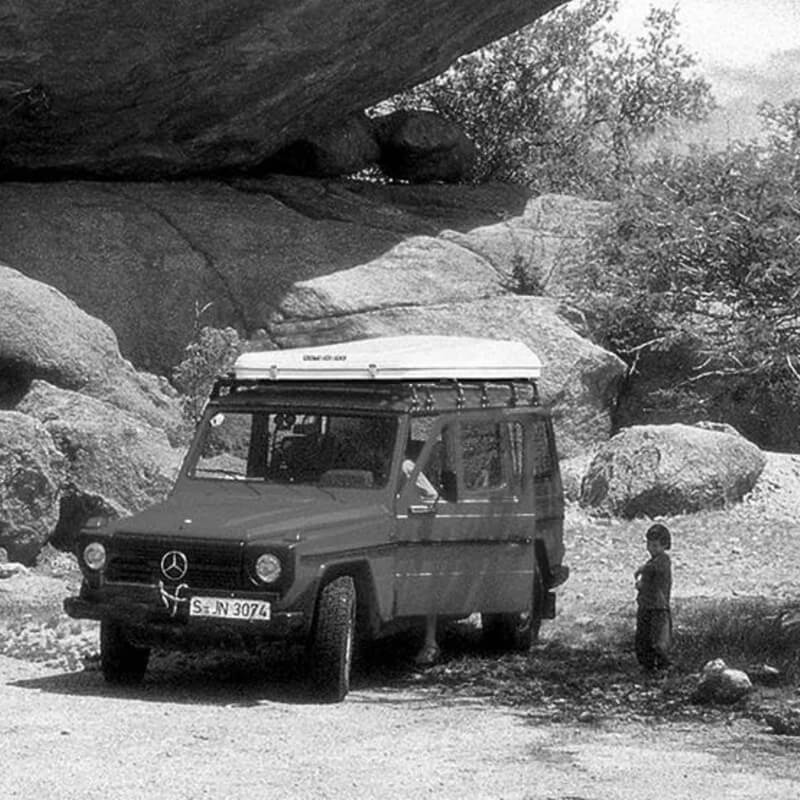
PAOLO MARIN
When I founded the Photo Challenge "The journey within everyone's reach”, I wanted to transfer my thoughts in a creative and engaging way. I think I succeeded, in light of the success of the proposal. I always thought travel is about having fun first. Surely, there are many components that lead to the adventure journey, but at the base lies the creation of a new dimension with yourself. Photography and documentary are the narrative expressions of this condition. It is no coincidence that my great passion is the deserts and in particular that of Libya, which is constantly in my heart. I work as a tour leader and teach off-road driving. However, I really like to go back to my Padua when I am not around. In my activities, I have used everything from the best 4x4 in long-distance travel, to motorcycles, quads, trucks... I talk about it in my journalistic reports that are published in various trade magazines. Always in these articles, I often remember that I am a great admirer of Autohome roof tents. With Autohome, hundreds of thousands of tourists solved in the best way the problem of how and where to spend the night. A safe, comfortable and always in the front row, in close contact with nature. I am convinced that the bed curtain is a winner compared to the classic ground curtain. Because the roof tent contains the mattress, pillows, blankets and everything you need for the night, leaving plenty of space in the car. Then you sleep on a real bed, without the slopes of the ground or the edges under the back, lifted from the ground away from the night dangers, insects and humidity. Wherever and whenever you stop, the roof tent is always ready to provide a comfortable rest: without fatigue and bending down on the ground, to stretch sheets and plant poles. Some indications and some of my advice on the main Autohome models show how the basic advantages of the roof tent are enhanced in these models.
MAGGIOLINA®
Maggiolina, first of all, which is Autohome's bestseller. What is this worldwide fame coming from? I believe that the first reason is the great convenience of opening and especially closing. However, the credit goes to all the quality of the tent and the elements that make it up. The line consists of various models to meet all travel needs and requests. The brand Airtop always belongs to the Maggiolina family. All materials are Maggiolina, so are the fittings. The only difference is the opening system, which is made by means of 4 gas springs, an operation similar to what happens with car doors. The opening mechanism is arranged on the sides, thus avoiding encumbrances in length. The model with total vision is then Airtop 360°, with mosquito nets I see and do not see integrated into the fabrics, to have privacy even when doors and windows are open.Airlander
Airlander is a streamlined, sober and clean tent that looks good on small cars, 4x4s and large vehicles. In terms of functionality and comfort, it has everything you need: 2 doors, 2 windows and each opening has a mosquito net. As I experienced personally several times, the mattress is really perfect and the fabric, as in the whole Maggiolina series, it is highly breathable ensuring a cool, dry and healthy environment. Very appreciated is also the waterproofing, there are no problems even when it rains very hard. Airlander's plus model is essentially characterized by the door finishes, which, being equipped with additional arched hinges, allow for customized partial openings. This way, while lying down, you get a great view on all sides of the tent, while maintaining the necessary privacy.Grand Tour
Gran Tour, on the other hand, is characterized by its consistent size: the shell is in fact a little taller and larger than Airlander, with a higher internal volume. I recommend this model for medium cars, such as Suvs, Vans and 4x4s. Its identity is based first of all on the original style, then on an aesthetic factor. The finish and every other detail are the same as Airlander Plus, while the front door is slightly larger. The fabric is also the same, therefore always highly breathable and, of course, perfectly waterproof. Gran Tour 360°, launched in 2019, is a model fitted with mosquito nets I see and do not see integrated into the fabrics. They guarantee privacy even when doors and windows are fully open.Extreme
With the Extreme tent you enter directly into the conceptual territory of the "long journey", when all the available cargo space has to be used to the fullest; but also simply in the sport holiday, where the loads and overall dimensions of the equipment have to be well managed. Technical-functional features, equipment and everything else are the same as Airlander Plus and Grand Tour: the difference lies in being able to further load materials over the roof.Airlander Plus 360° X-Large
X-Large, also launched in 2019, is the largest shell model on the market: 180 x 230 cm, made with the crank opening system. Even on vans and large vans it does not pass the mirrors, so it fits in the shape of the car. This means you can camp anywhere, even in public areas of normal vehicle parking. Nothing of the tent protrudes and therefore there is no need to go camping.
COLUMBUS®
Finally Colombus, a model that is really appreciated, because it focuses on simplicity: 2 springs only, so little space for lifting mechanisms inside the tent. Two gas springs and everything is ready: the curtain opens and closes without any further need. You like the immediacy of operation, the shape when open, but above all the internal height that reaches 160 cm; this means that you can even "change clothes" while staying comfortably in the tent. Also worth highlighting, the doors on the sides that turn into comfortable and large windows. The Variant model exhibits a very open back, equipped with an arched zip that allows considerable customization of opening. The equipment is similar to the standard model. It is the elastic mesh in the attic that makes the difference, as well as the interior light and the posts that transform the tailgate into a comfortable awning.
AIR-CAMPING®, OVERLAND® e OVERZONE®
Autohome also offers a specific line of fabric curtains: Air-Camping, Overland, Overzone and Overcamp. Once the PVC canopy is removed, these curtains all open like a book with a single, simple gesture, using the ladder. They all have a very effective and reliable fabric: consistent and robust, it has excellent stability. This means no noise and no flapping of fabrics in the wind, even when there is a breeze at night. The fabrics do not swell: the walls and roof are in fact well attached to each other, firmly sewn together. Even the windows are windproof and silhouetted on the walls, so as to avoid the sail effect of the wind. In addition, the windows open and close while remaining comfortably in the tent: this is thanks to special tie rods, prepared for an operation similar to the shutters of the house. To remember: being a series of cantilevered tents, they come out of the silhouettes of the car so the European rules impose the use of the tent only in camping areas. Camping is not allowed in public areas or parking lots.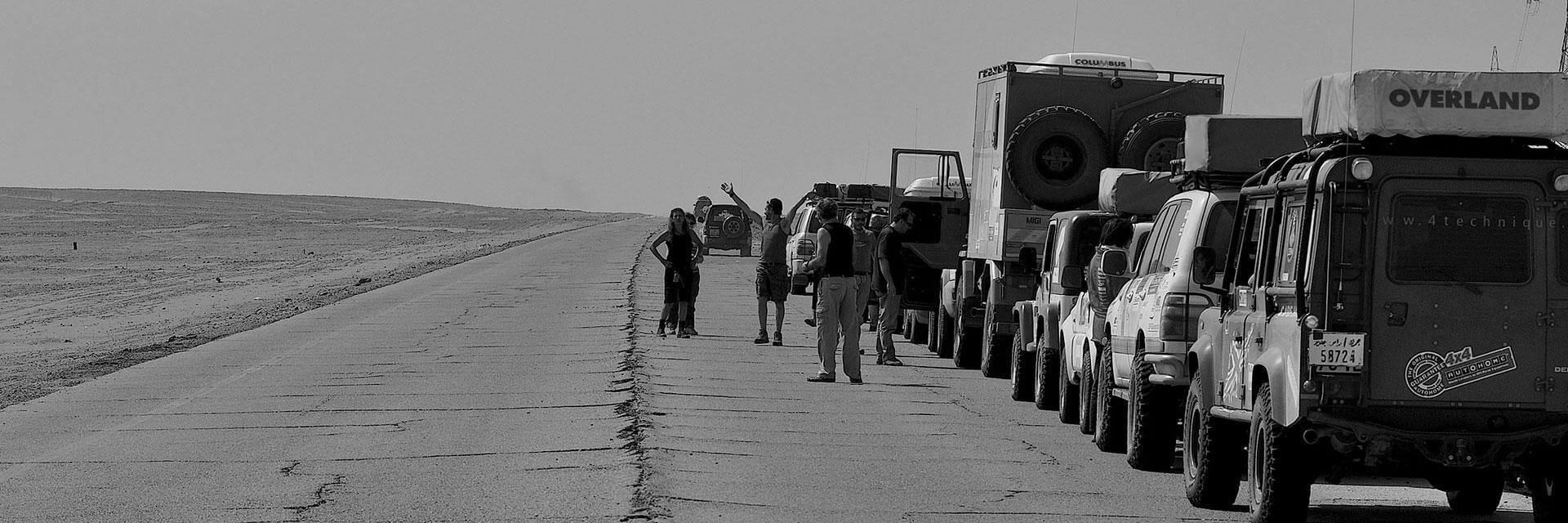
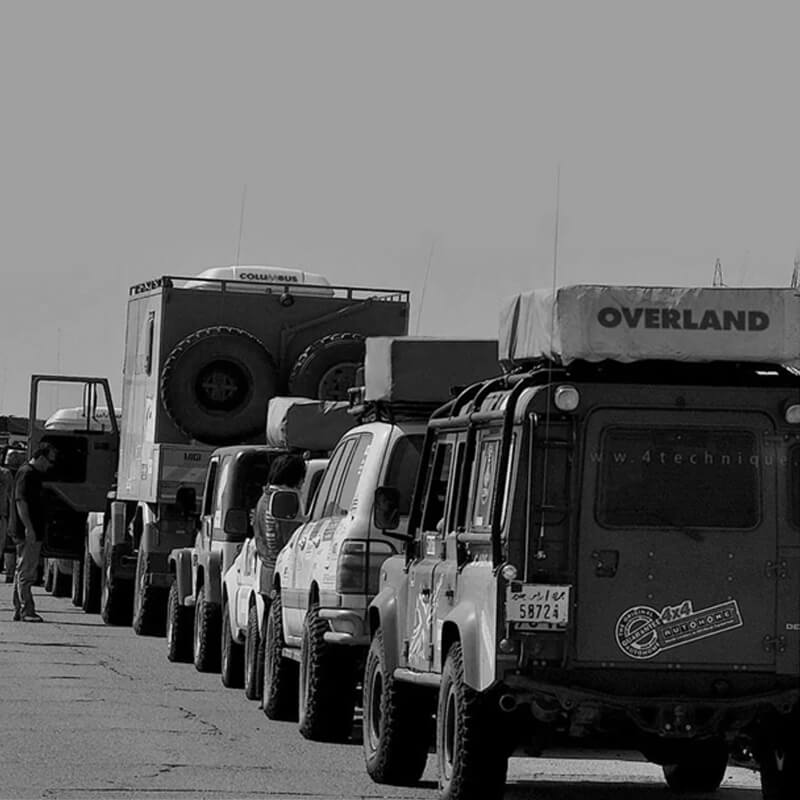
JÜRG SOLLBERGER
I have always been convinced that a true traveler must be the maker of his dreams. The journey spontaneously leads to freedom and knowledge. That is why I mainly dedicated myself to new projects, sometimes even a little crazy, which then became classics of adventure travel. Even as a boy, I was a dreamer, a rebel. I wanted to be free to go where I wanted. It was almost inevitable that even in my feelings I would look for and find a person, a woman able to share (and bear...) my character. Therefore, it was with Doris, who actively shares my adventures. I happen to be impulsive, to carry out courageous projects, but from a technical and equipment point of view, I think I am very strict. Maybe that is why they asked me to be a travel consultant and experimenter. Even Autohome asked me. Since the '90s. Also in those years, I started to take courses as a trans-Africa tour instructor. We began to put Autohome products to the test in Asia, developing the world of travel-adventure in the East. For example, on one tour I touched "extreme" sites in China, Burma and Tibet. During numerous expeditions and events, I publicly thanked Autohome as "Superior rooftent". The reasons? Let us see some of them together. Taking for example my favourite curtains and some accessories.
COLUMBUS®
I start with Colombus whom I love very much, especially because she is taller than normal: she reaches 160 centimeters. I directly experienced what this comfort means: I am over 190 centimetres tall and I am also sturdy. It is no coincidence that I chose the X-LONG model of 2.30 centimeters. Inside the tent, I can comfortably change my dress. Wearing fresh, clean clothes after hundreds of miles is an absolute pleasure! I also appreciate very much that the two shells are directly hinged to each other on the front, so the lowered roof is more supportive to the base and has no support mechanisms. Very functional is also the large rear opening that I can customize. I like the arched design of the two large doors on the sides that also become windows. The fabric is Airtex technology, perfectly waterproof and of high quality, but above all it is not bulky and folds easily into the tent. I therefore believe that Columbus is the tent for a dynamic and concrete itinerant journey, for those who travel at every sunset, ideal for those who demand the essential but do not want to give up comfort.
Wings
Let us see Wings. When I first saw the typical "bat wings" I thought they were really what the Maggiolina series needed! Creating 160 cm coverage at the entrance to the tent is an advantage for several reasons, especially if it does not hinder the movement of the tent. In practice, you get a large protected entrance that allows you to take off your shoes without staying under water, for example. In fact, very comfortable are the hooks for slippers or boots, which remain hanging on a corner of the cover. In addition, when you wake up in the morning, in case of rain you are not immediately under water. With Wings, the advantages are also under the sun: in the case of high temperatures, the awning doors can in fact remain fully open to facilitate the recirculation of air, while remaining protected from water, sunlight and prying eyes, thus ensuring greater privacy. Therefore, it is a great idea, and what's more, there is no work to be done on the tent: no holes in the shells, nothing! The Wings are easily applied simply by acting with a special support pole that hooks into the slots under the roof, everything is provided as standard.Accessori Autohome®
Finally, I tell you about some other Autohome accessories that I often use. First of all, the winter hood. I tested its pleasant function both as an additional protection against cold and sudden changes in temperature and as a "collector" of heat in the early morning sun. A piece of advice: when you mount the hood, it is best to keep a few windows ajar, in order to have enough air circulation to let the humidity out. Equally functional is the locker room cabin. I experienced many times how useful it can be to have an environment connected to the tent. You can change your clothes, of course, but you can also keep your personal belongings, store other accessories or equipment and so on. Security, but also privacy: you have an additional protected area, completely lockable on all 4 sides. It is a rational accessory also in the assembly: it is in fact made with a few poles that hook quickly to the roof tent. In many travel and camping situations, awnings and verandas are valuable. The first is a very useful accessory when you want to get a big cover at the entrance of your tent, to protect yourself from sun and rain. In the easiest way, you can create a space to have lunch or relax in the shade. I remind you that the awning can be hooked on both sides of the awning and can be used in combination with a changing room cabin or awning. In this way, you get a complete system of sun and weather protection. With the veranda, you have a self-standing structure that remains mounted and stands alone, without the need to have your car near. A protected space to store things when you leave the tent. Particularly convenient is being able to quickly put your sports equipment away. Installing the veranda is also very useful to guard your camping site, avoiding to find it partially invaded by other campers.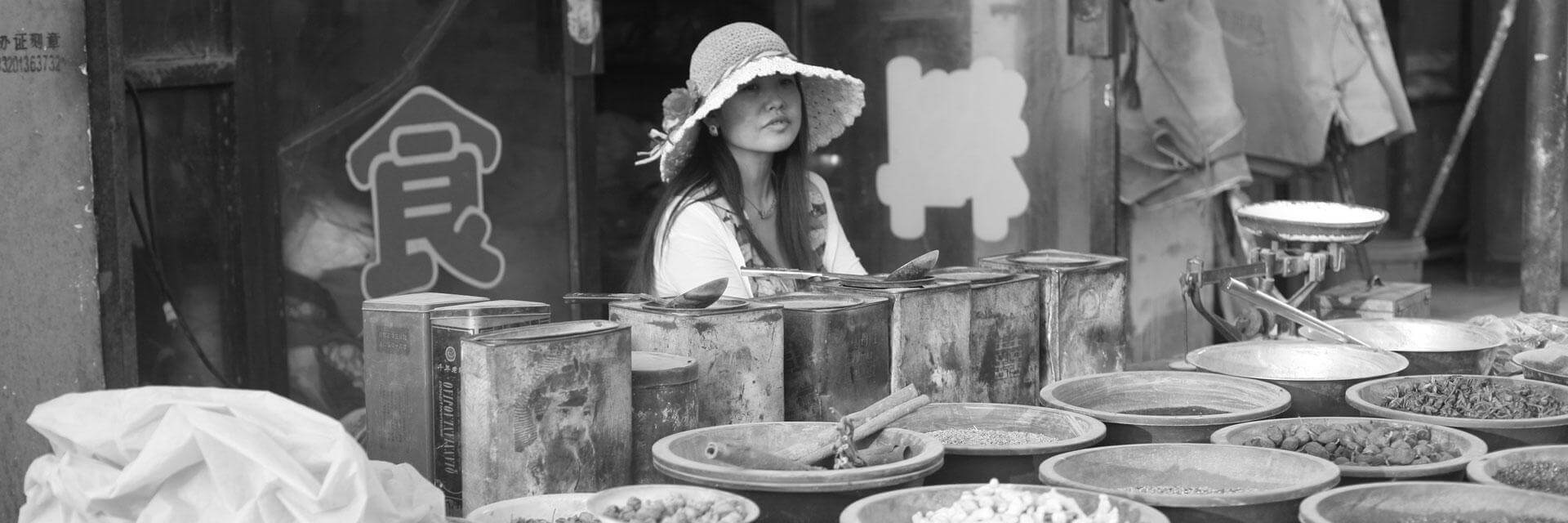

AKIS TEMPERIDIS
After years of journalism, I felt the need to launch myself more directly into the part of the traveller, the one who starts and goes. In addition, it was passion right away! With my expedition "The world Offroad I" I wanted an experience of great commitment right away, without half measures. I set up a Land Rover Discovery3 equipped with a Maggiolina Extreme Forest tent and in 2007 I set off on a round-the-world trip. I knew it was going to be hard, but I had no idea to travel 167,000 km in 1,234 days, touching 67 countries and 5 continents. How did I do that? Passion and curiosity. Shared with Vula, my life and travel companion. Maggiolina has been our home and refuge for 718 nights in about 600 different places! For Vula and me those were unforgettable moments, perhaps unrepeatable. We were excited and we loved that total sense of freedom that only an Autohome roof tent can provide. I underline: a very good roof tent, because if there had not been the quality of Maggiolina on several occasions there would have been trouble. I have told it many times remembering this great journey: Maggiolina gave us positive energy from day to day. We slept both in hot temperatures and in freezing conditions, but in the Maggiolina we always found ourselves pampered.
An irresistible desire to travel
Our first big tour was in collaboration with the leading automotive magazine in Greece, for which I worked. Writing has always been my main job, which also includes editing books and travel guides. With Vula and our daughter, we lived in Italy for several years, but the desire to travel never abandoned us. Not really! We had many more experiences since 2010. For example, we took part in the project "Around the World" launched by "7Milamiglialontano". After this collaboration "The World Offroad II" was set up, which is taking us along new routes starting from the mythical "Silk Road". In this adventure, I am driving an IVECO 4x4 motorhome, but without renouncing to mount a 90 cm wide Overland Autohome tent on the roof, as a wildcard space useful both for relaxation and to accommodate additional travelling guests. Also during the new tours, I continue my activity as a writer and photographer, which today is carried out mainly thinking about the online world, on sites, portals and social networks. It will always be the network to welcome my next reports, documentaries created with particular attention in observing the countries and populations with which we come into contact. Cultural experiences as well as adventure, on which I like to involve my daughter very much.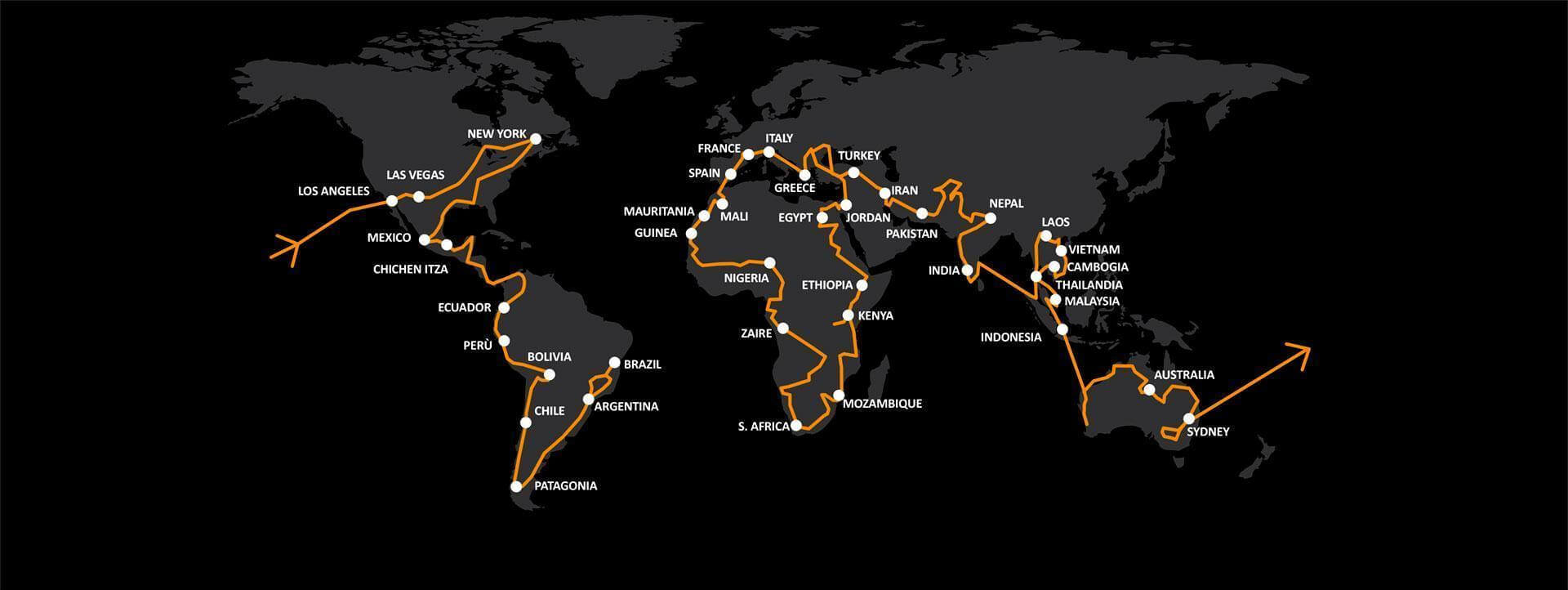

VULA NETOU
MOTHER AND WIFE OVERLANDER
I have always been a dynamic, vibrant woman. When I start up something, I put all of myself into it. That is what happened with my off-road project. Although my background was more related to art and theatre culture. I have in fact had a career in dance, both as a performer and then as a choreographer and teacher. I fell deeply in love with the adventure trip when I met Akis Temperidis. Therefore, for me it was a double love! I shared with him the dream of travelling the world for almost four years, in our project "The World Offroad", which started in 2007. It was an experience of extraordinary intensity, which also allowed me to play the role of tester of the equipment we used, first of all the Autohome roof tents. After several other travel experiences, including a long stay in Africa, we moved to Italy where our daughter Anastasia was born. However, the desire to travel, that desire that fans know well, led us to design another challenge, even longer and more demanding. In 2018, together with our daughter, we set off on a second expedition along new routes around the world, which is still going on and will certainly last for years. I also renewed the task of tester, focusing even better on the needs of women in difficult, not to say extreme, journeys. An Autohome tent accompanies and assists us on this second expedition: Overland. On the contrary, it would be better to say "the system" Overland, because it is an articulated system, intelligent, I would even say "brilliant" in its daily practicality. This result is obtained first of all in the relationship between the tent and its accessories, which make Overland ideal both for big trips and for short stays of relax and holiday. Based on my constant use of the Overland system, I have the opportunity to provide some practical advice that I believe will be useful for everyone. I am focusing on some accessories.
Veranda
Let us start with the veranda. It is an independent structure from the tent that can be used to store various things while you are away, for example going to the beach or shopping. Therefore, it is a perfect accessory for campers. I assure you, however, that even on more demanding trips it can be very useful. In addition, because with the versatility of the Overland system, the veranda can be coordinated with the roof awning or with the awning on the ground feet for longer stays.Changin room
It only takes a few days of use to understand how much the locker changing room is an indispensable part of the equipment. It is made with 4 walls of the same fabric as the tent, connected by a zipper, and can be easily applied under the base of the tent. It ensures practicality without cluttering up because it adapts perfectly to the tent. It creates a space of privacy to change clothes, but also to store camping equipment, especially in bad weather.Feet
The feet on the ground are only apparently marginal accessories, but I can guarantee from direct experience that they are often essential. Of course, they become indispensable in the case of long stays. An important additional advantage to remember: with your feet and tent on the ground you do not have to respect the closing times of the campsites, you can return on foot without restrictions.Winter hood
The winter hood was a real salvation for Akis and me so many times! How many sub-zero nights we spent protected by this indispensable accessory. As simple as it is precious. Remember that even when extreme climates are not reached, the winter hood is still very useful. In particular, it is an ideal barrier against temperature fluctuations. Perhaps not everyone knows that even in Europe there are many places that have daytime and night-time fluctuations of 25°C!

EUGENIO MARTIGNANI
Eugenio Martignani has a long track record in adventure travel on board a series of off-road vehicles. He has transformed his passion for nature and exploration of far-off lands into a profession, as a journalist specializing in 4WD autos. For the past thirty years, he has contributed to Italian and international magazines, worked in TV as a test driver, technician, sportsman and travel reporter. He has seven Camel Trophies, years of experience in African Rally Raids, has crossed Siberia in winter and headed up the frozen Mackenzie River as far as the Beaufort Sea. And more. For work or fun, he has driven in all the Continents: from the Amazon to Mongolia, from Australia to the Polar Circle, from Indonesia to South Africa. He has written books and guidebooks for off-road vehicles and, when he has a little time, heads off to somewhere new, with a preference for deserts, which he has explored the world over. His “mission” is to leave civilization behind and explore unknown destinations, because – as he says - “the four elements of our planet are earth, water, air and fire, not asphalt or cement!” On his off-road adventures, he has used and tested the roof tents of various manufacturers and, in particular, the wide range of Autohome products, which are able to meet even his demanding needs. “What do I look for in a roof tent? Distance from the ground, protection against animals, rapid opening and closing and comfort inside because a good night’s sleep is all important if you want to travel well.”
THE BASIC FEATURES OF AUTOHOME QUALITY
In general, they are all tents of superior quality, with manufacturing and technical features that undoubtedly place them at the top of the sector. Technically (function, performance and comfort) and in aesthetic terms, they are unbeatable. Autohome represents “history” and the continuous development of roof tents for vehicles; the company is the market leader with products that just can’t be copied. It is no accident that they were the first in the world to patent and develop this type of tent. Since 1958 they have created a whole range of innovations and successful products. Their tents are the biggest sellers the world over, which is unusual because quality doesn’t usually coincide with quantity. But with Autohome, it does. Another added value which today is particularly important is pride in a product that bears the “Made in Italy” label, with exclusively Italian and some European suppliers.PROFILE OF INDIVIDUAL PRODUCTS
MAGGIOLINA® (AIRLANDER - GRAND TOUR- EXTREME – EXTREME FOREST)
These are models that open and close with a handwheel, using 4 lifting poles, two at the front and 2 at the rear. Fabrics used: DRALON® (Made in Germany) and AIRTEX (German-made, of the highest technical quality).AIRTOP®
Airtop opens with gas springs fitted into the 4 lifting arms, in pairs on both sides of the tent. Fabrics used: DRALON® and AIRTEX®COLUMBUS®
Tent models opening with gas springs fitted into 2 lifting poles on the sides. Fabric used: AIRTEX®AIR-CAMPING® / OVERLAND®
This tent opens “like a book” with 2 platforms hinged at the sides with 3 ribs supporting the fabric.OVERZONE®
Conceptually similar to Overland, opening like a book and again with 2 platforms hinged at the sides with 3 ribs supporting the fabric and a further adjustable rib at the entrance to the tent.OVERCAMP®
Opening with 3 adjustable ribs supporting the fabric. I should point out that one of the advantages of these tents is that, when they are closed, they only take up half of the space on the vehicle roof, leaving room for sports gear (for example for surfing or canoeing) or other equipment.LA MIA PAGELLA – PERFORMANCE
LEGENDA DI VALUTAZIONE
 = BUONO
= BUONO
 = OTTIMO
= OTTIMO
 = ECCELLENTE
= ECCELLENTE
 = SUPER
= SUPER
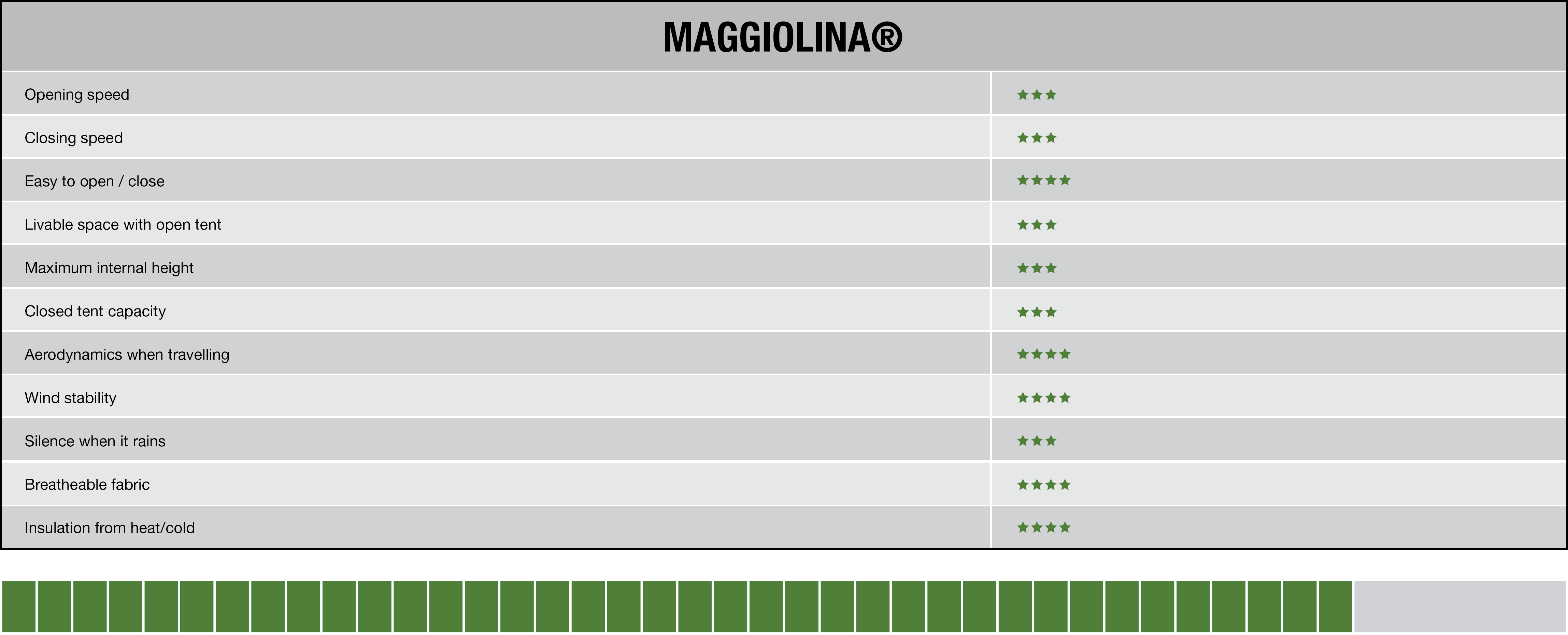
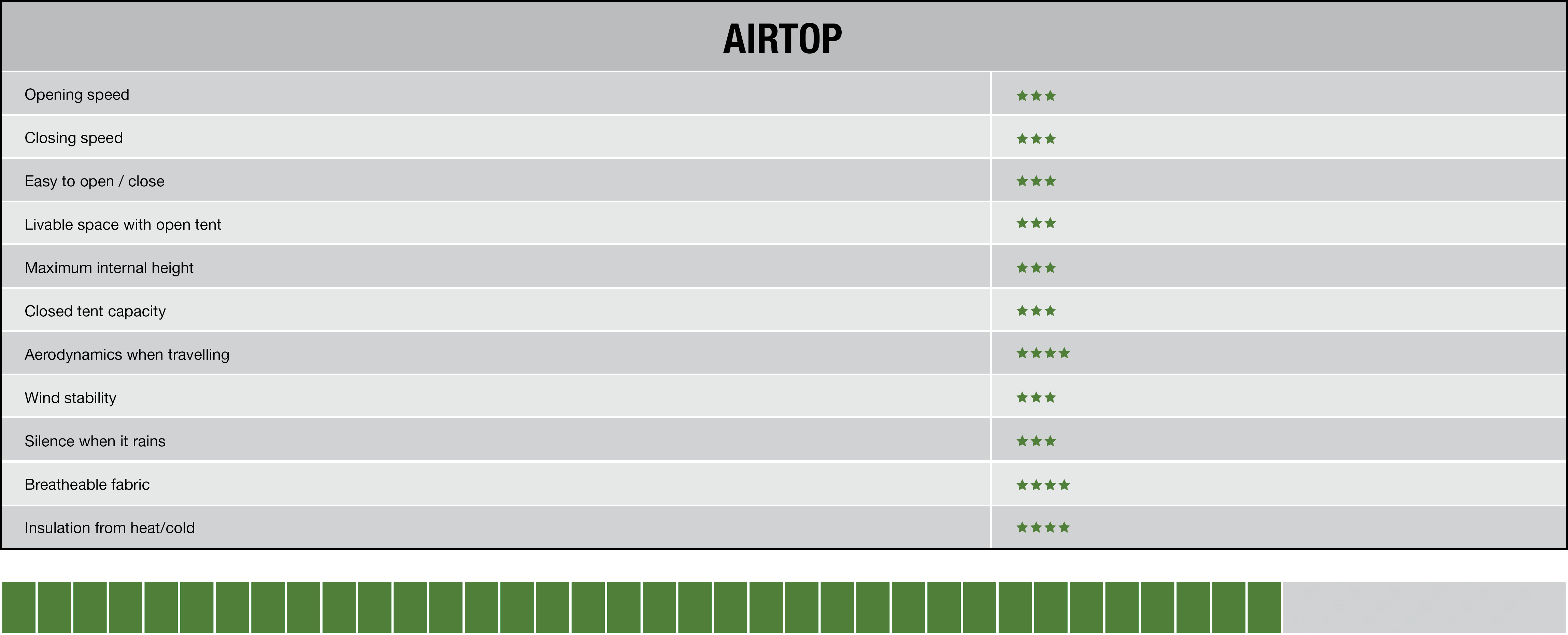
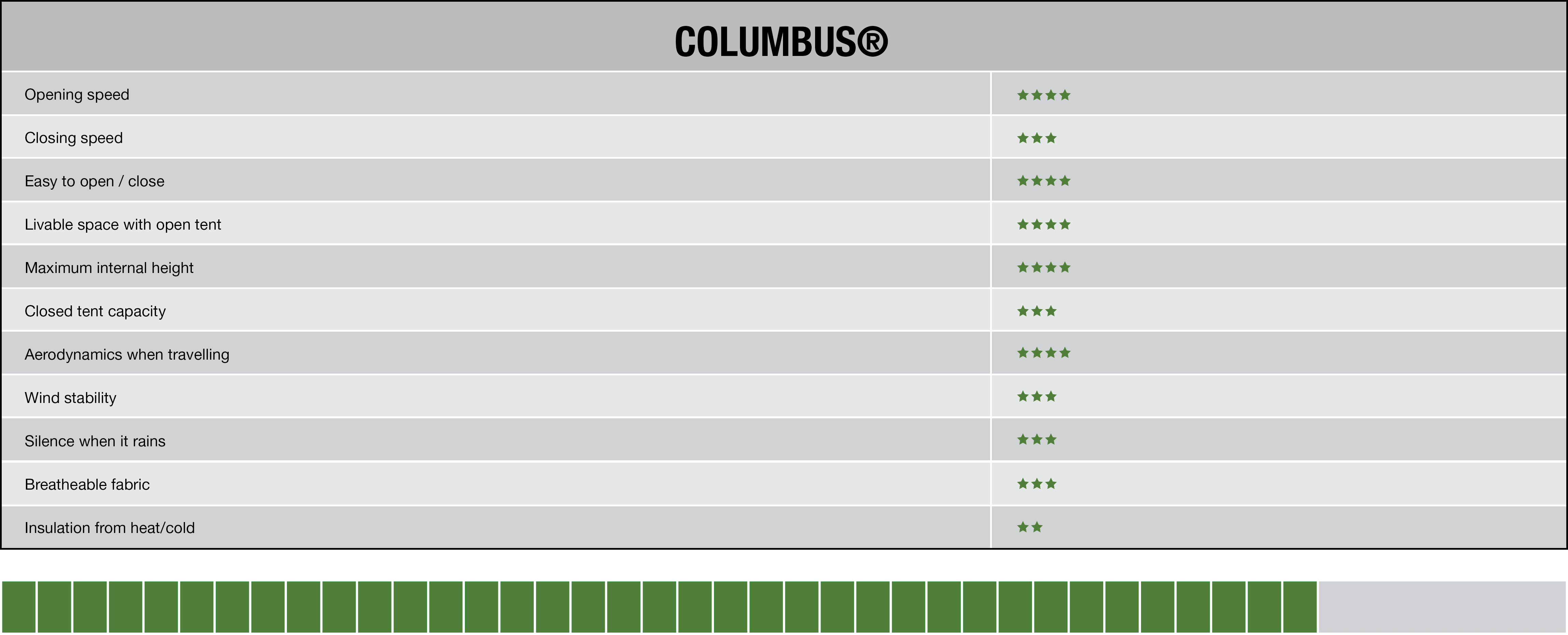
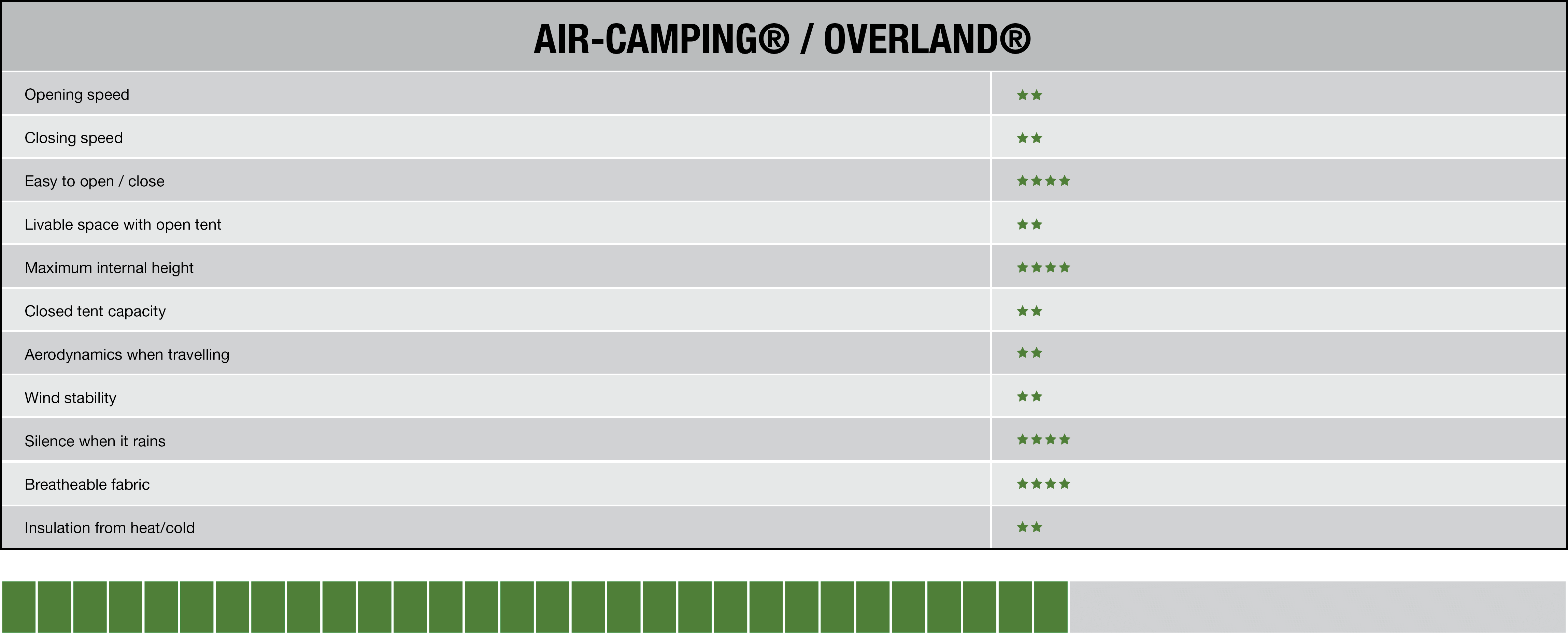
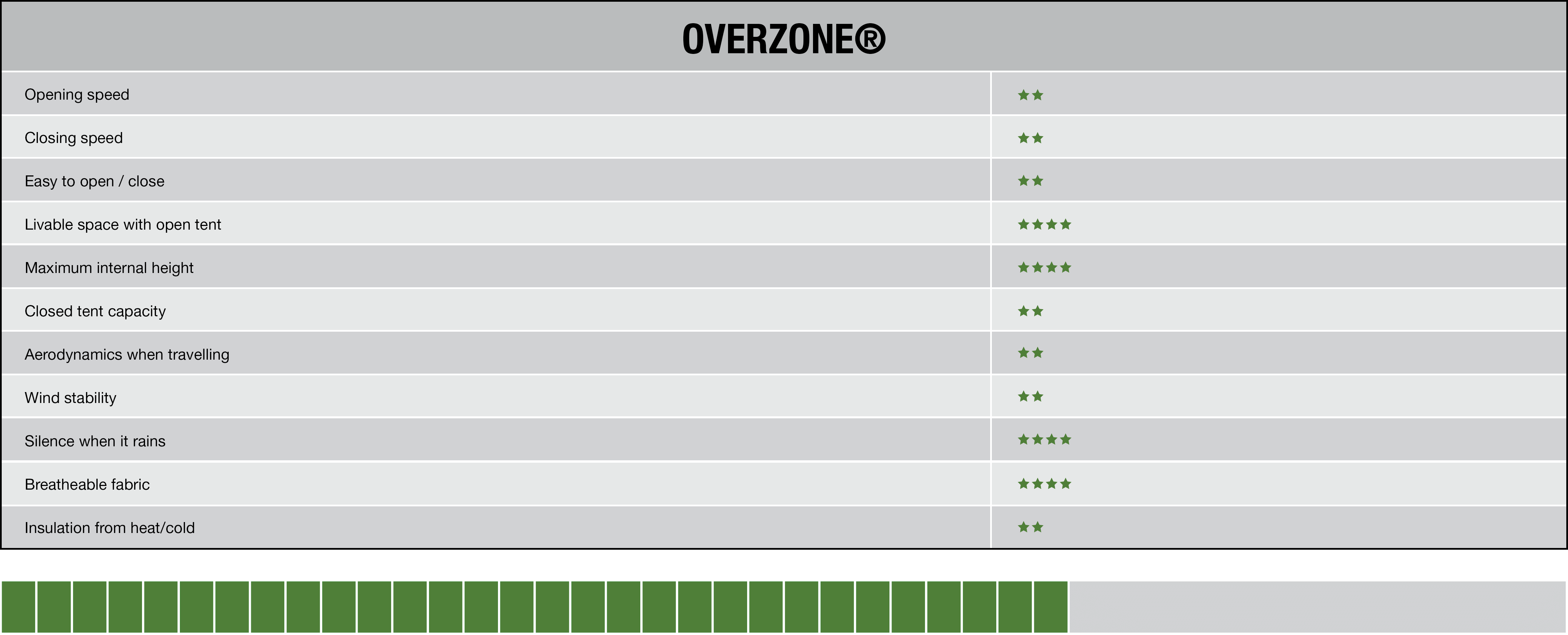
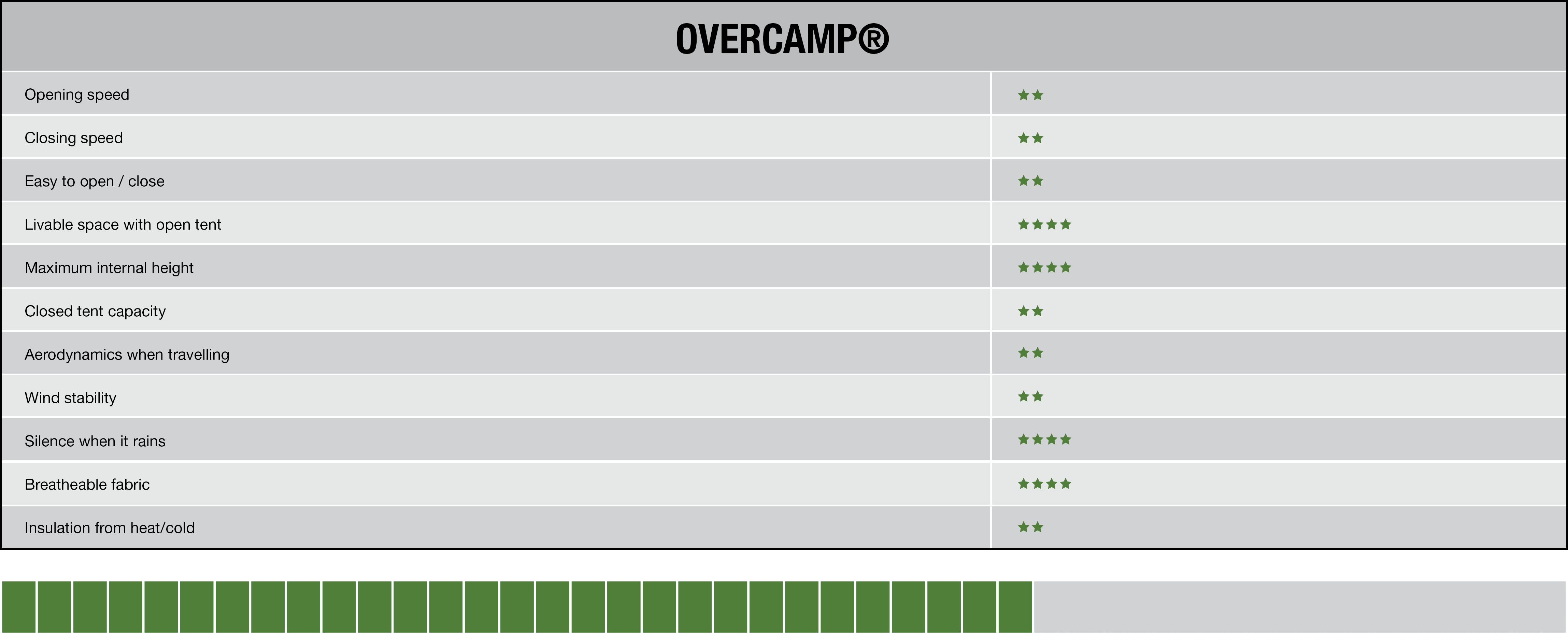
LA MIA PAGELLA – PERFORMANCE
LEGENDA DI VALUTAZIONE
 = BUONO
= BUONO
 = OTTIMO
= OTTIMO
 = ECCELLENTE
= ECCELLENTE
 = SUPER
= SUPER
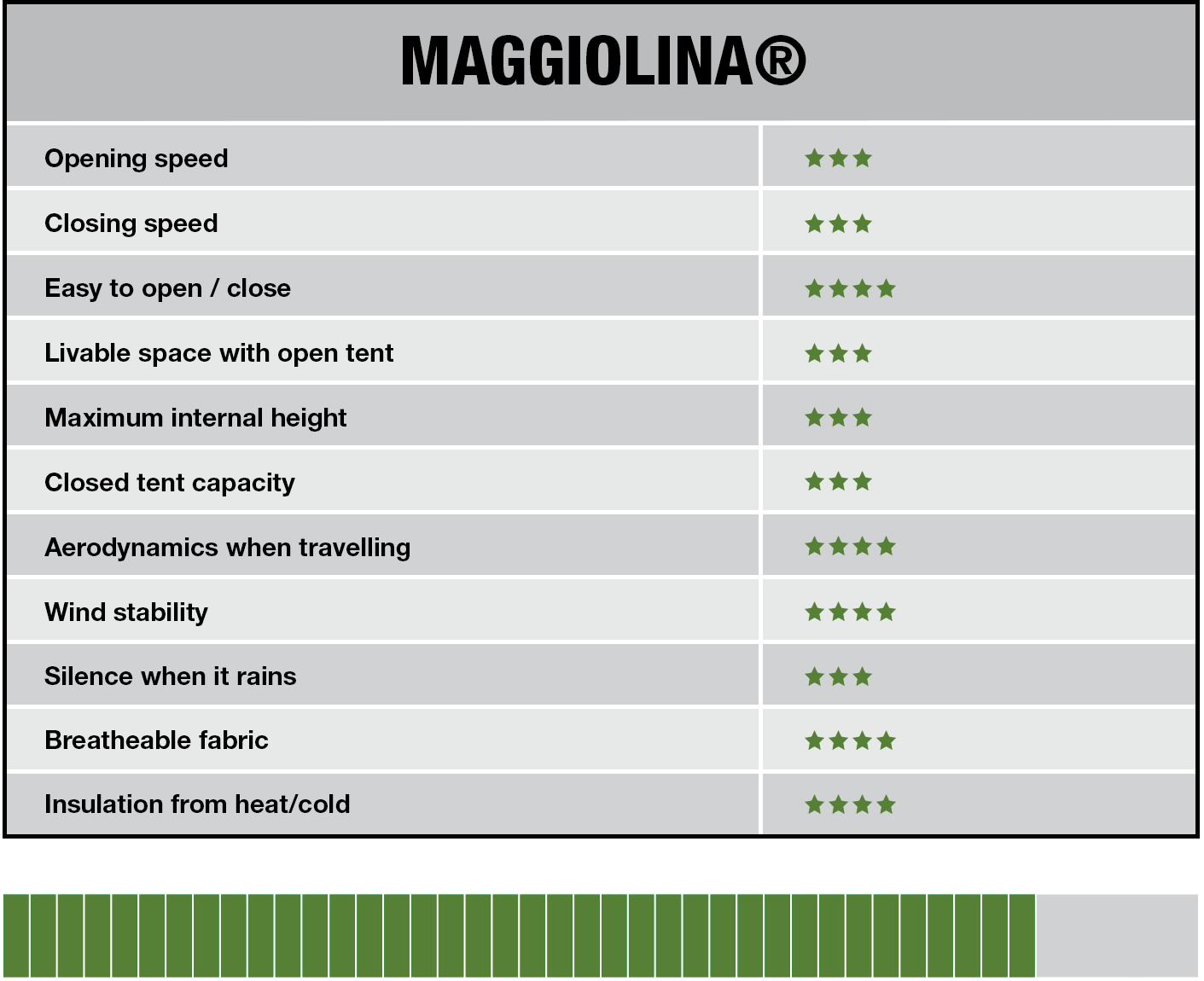
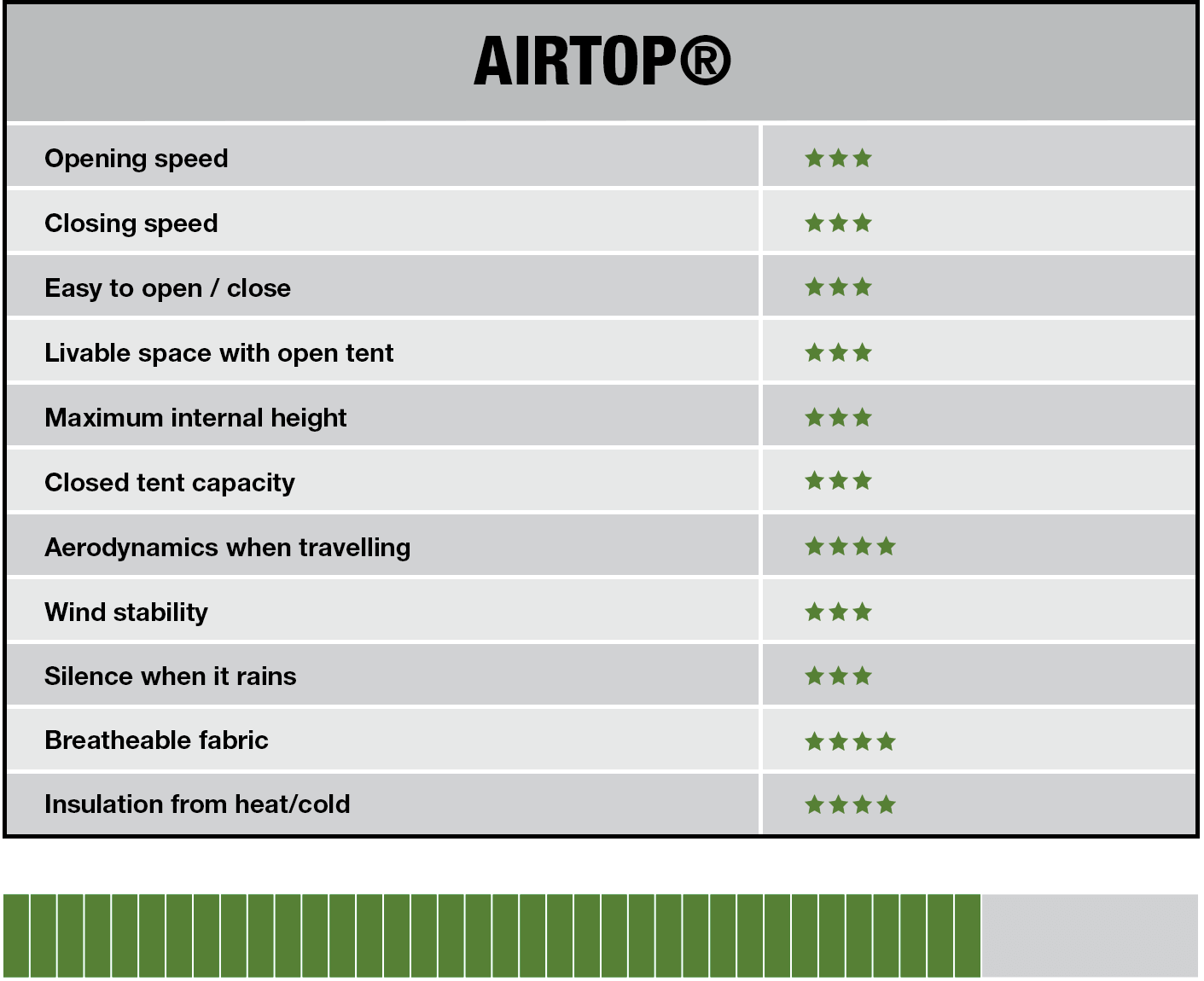
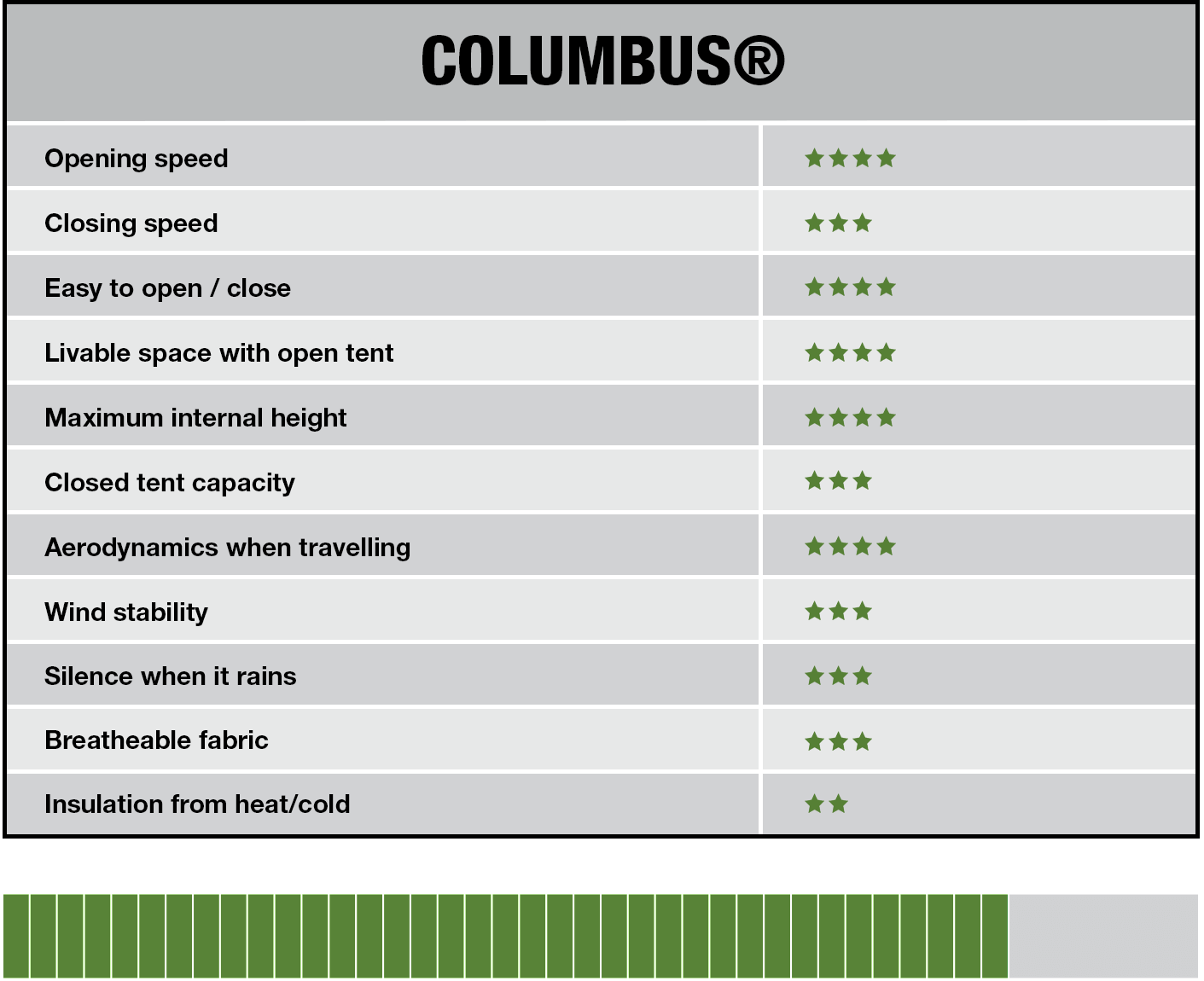
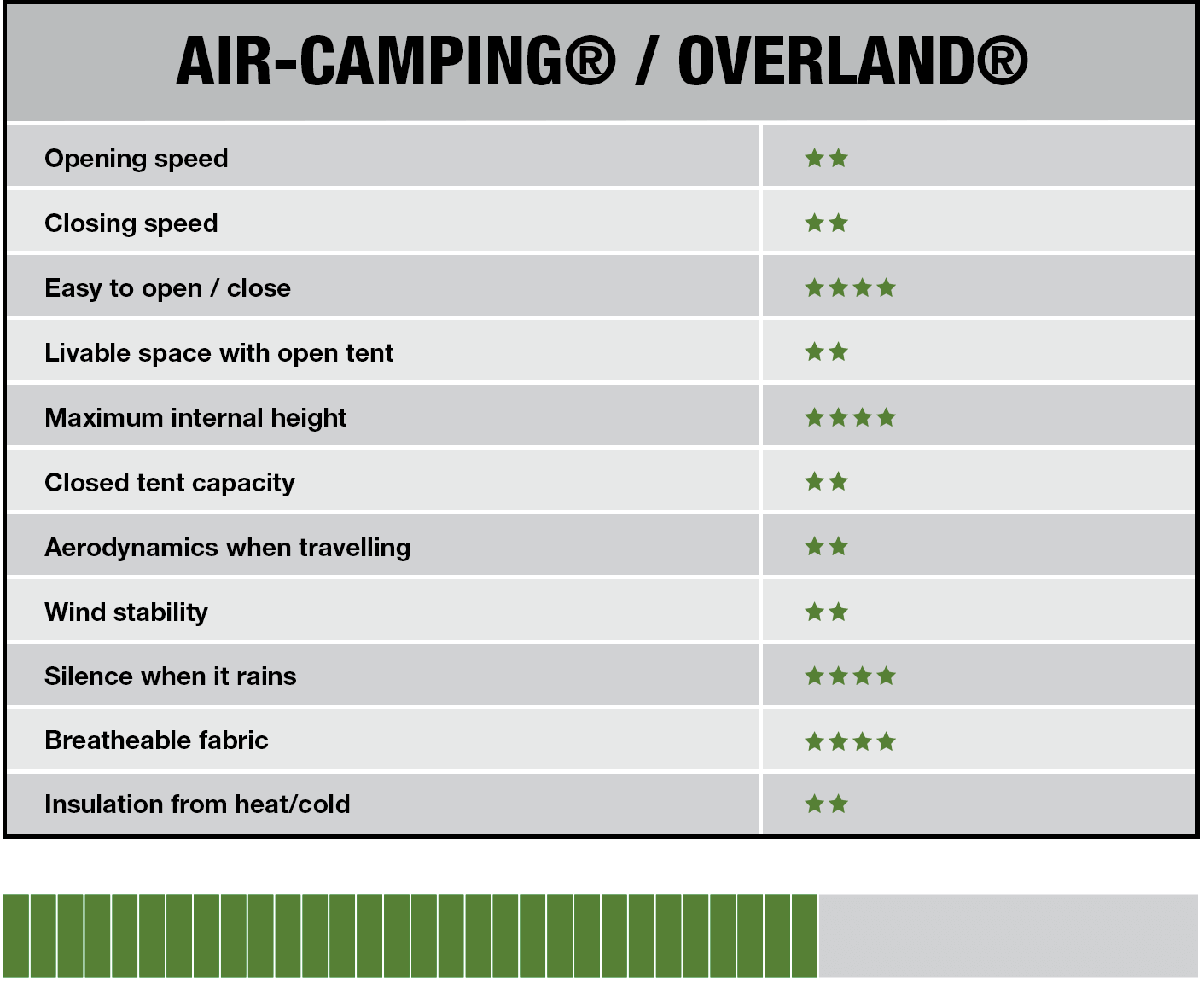
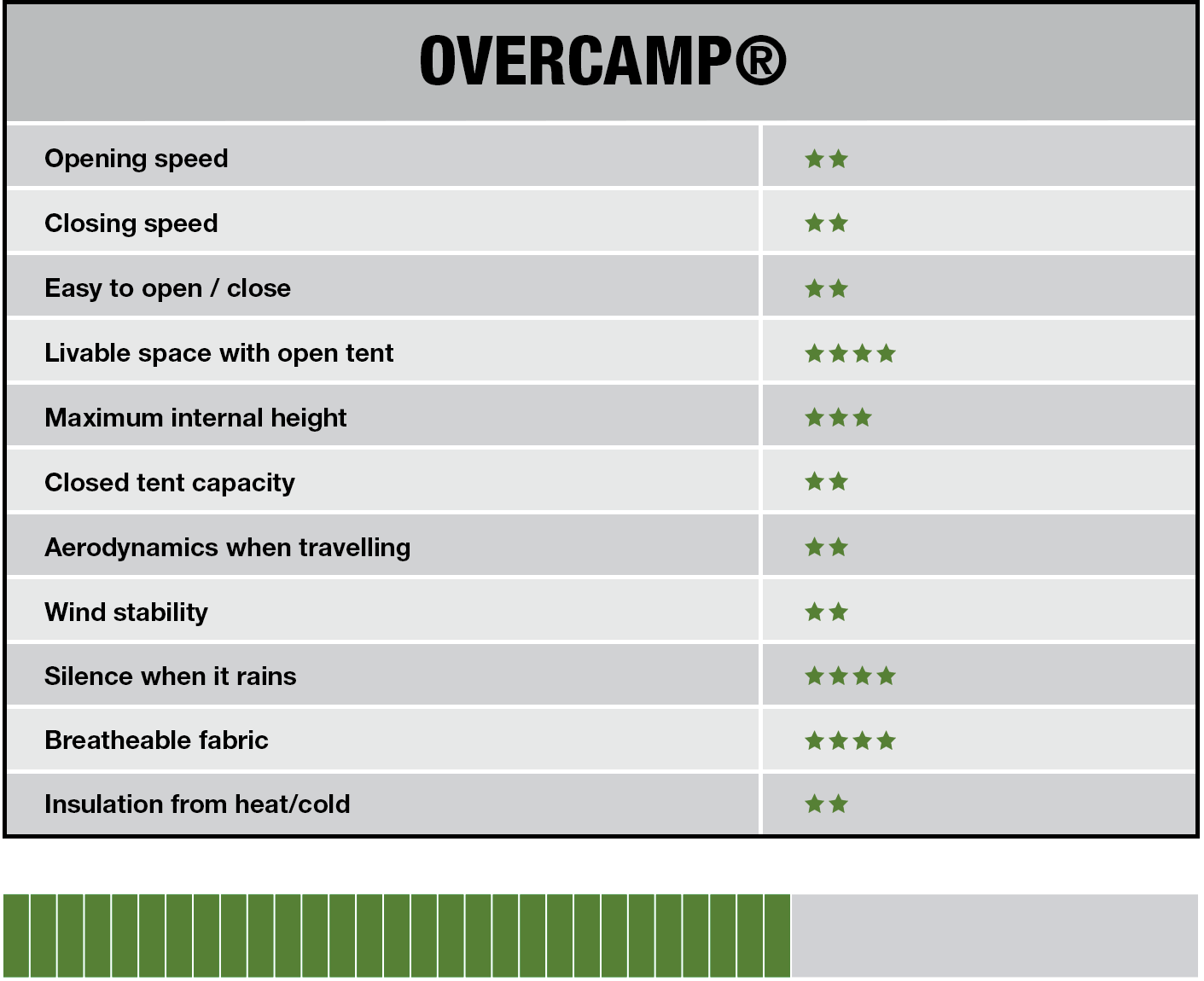
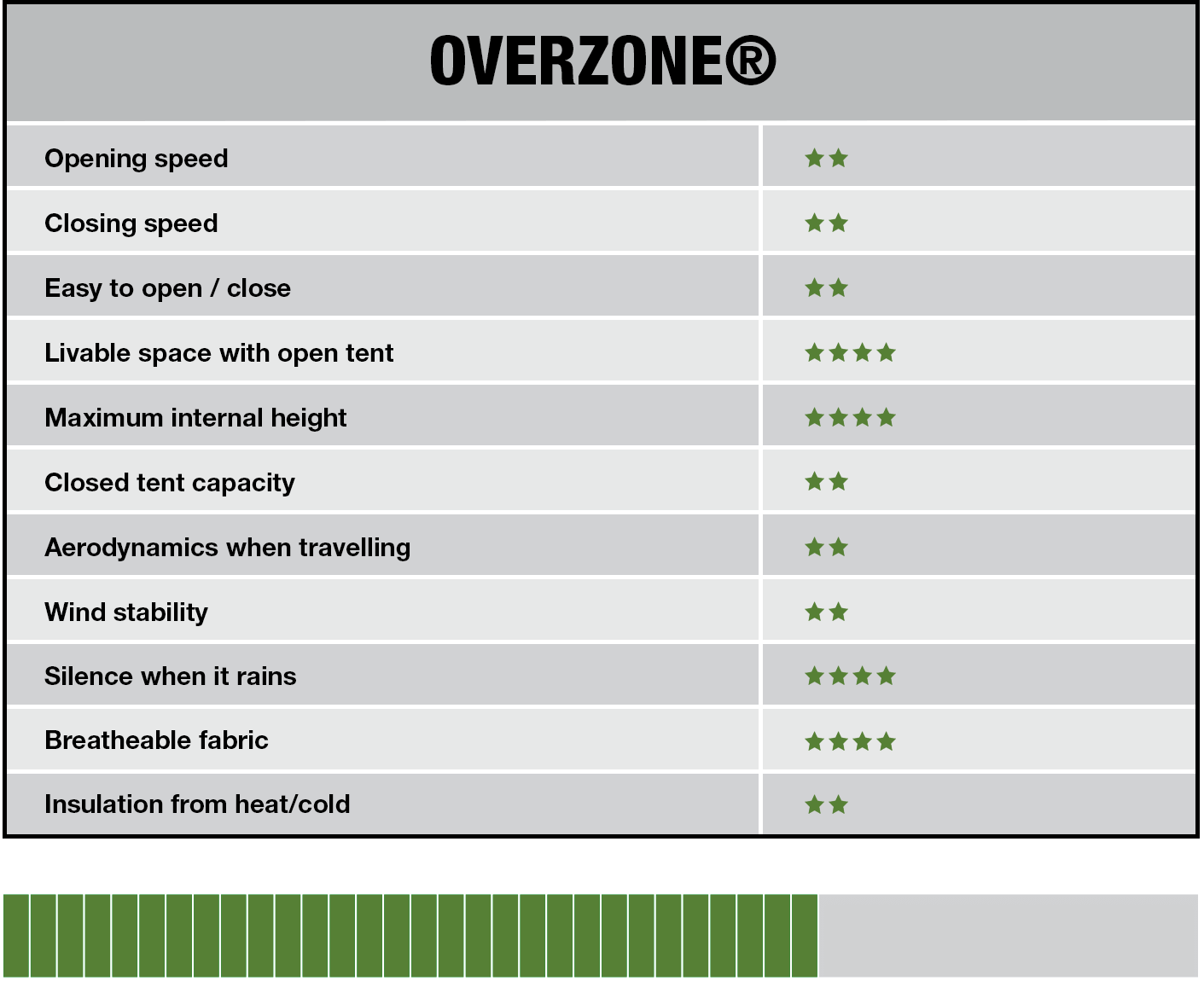
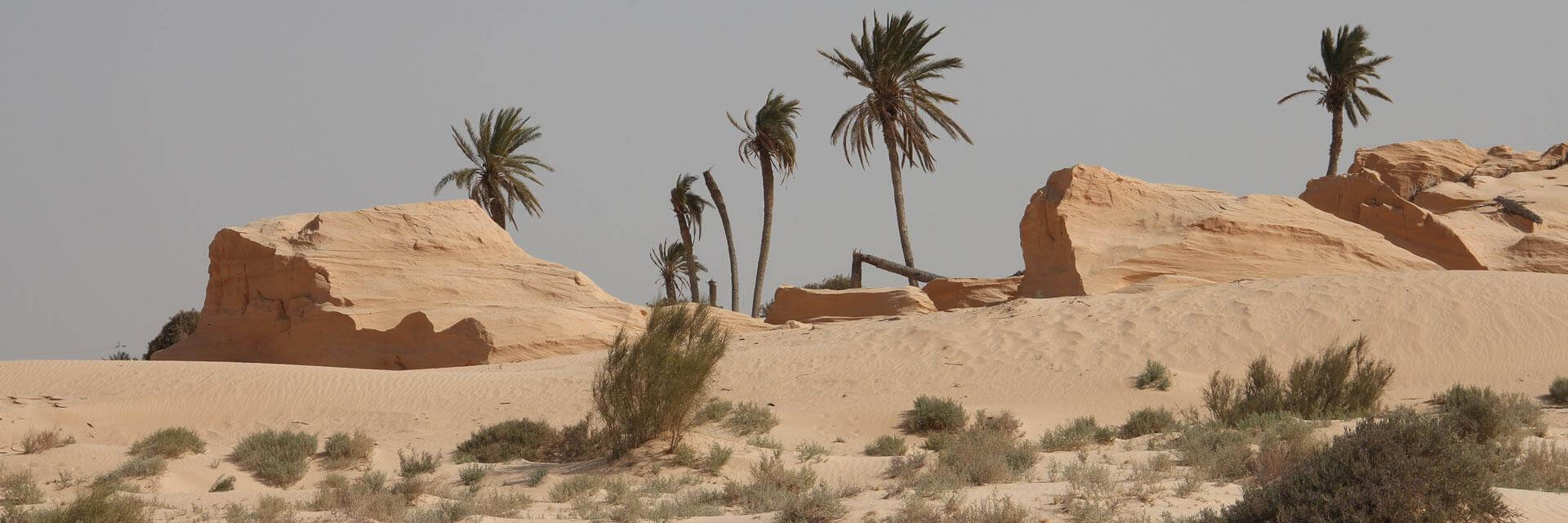

ROBERTO MANOCCHI
THE OFF-ROAD GURU
I am always a little surprised when they call me a 4x4 wizard. If I were born in India, what would they call me? Guru? Let us not kid ourselves... No magic, but a lot of experience and a bit of intuition, which is it, that is it! I started working in the sector back in 1990 and continue today in my workshop in Portogruaro, specialized in setting off-road vehicles for the most demanding challenges. In many years of work, I have helped many projects and many dreams of adventure around the world. My task is essentially one: to ensure that the vehicle is consistent with what it will have to face. Developed in every detail to prove himself worthy of the situation. Everyone knows I have a great love: The Defender. It does not matter the age or the conditions of use... love is love! I think I know really well this extraordinary creation that for many years never ceases to amaze. My workshop is clearly orientated towards the Land Rover world, with which I work both commercially and for specific projects in the field of adventure travel. Maybe that is why they also ask me to be a tester. They say I am inflexible in evidence and judgement... I think instead I am simply rational and honest. If there is something wrong, I will say it openly and plainly. If I find something I really like, I recommend it. That is all. In any case, I always justify my opinions. I am a big off-road enthusiast, but I never got carried away by easy enthusiasm. It is probably for these reasons that Autohome asked me to join the team of verifiers, who are impartial in their judgments precisely because they are external to the company. I have a deep esteem for the quality of Autohome products, but with as much frankness, if there is something that does not work I report it. Text products, services and accessories. I notice that they trust my judgements, so much so that before going into production they always ask for my opinion. Among the most recent tests I conducted is the one dedicated to the new closures, introduced for all rigid shell awnings from 2020. After gruelling field tests, I can confirm that these closures are truly innovative and make a significant improvement to the concept of functionality in the industry. A reconfirmation of the commitment that distinguishes Autohome in all the technological elements, even those that sometimes tend to be forgotten or neglected.
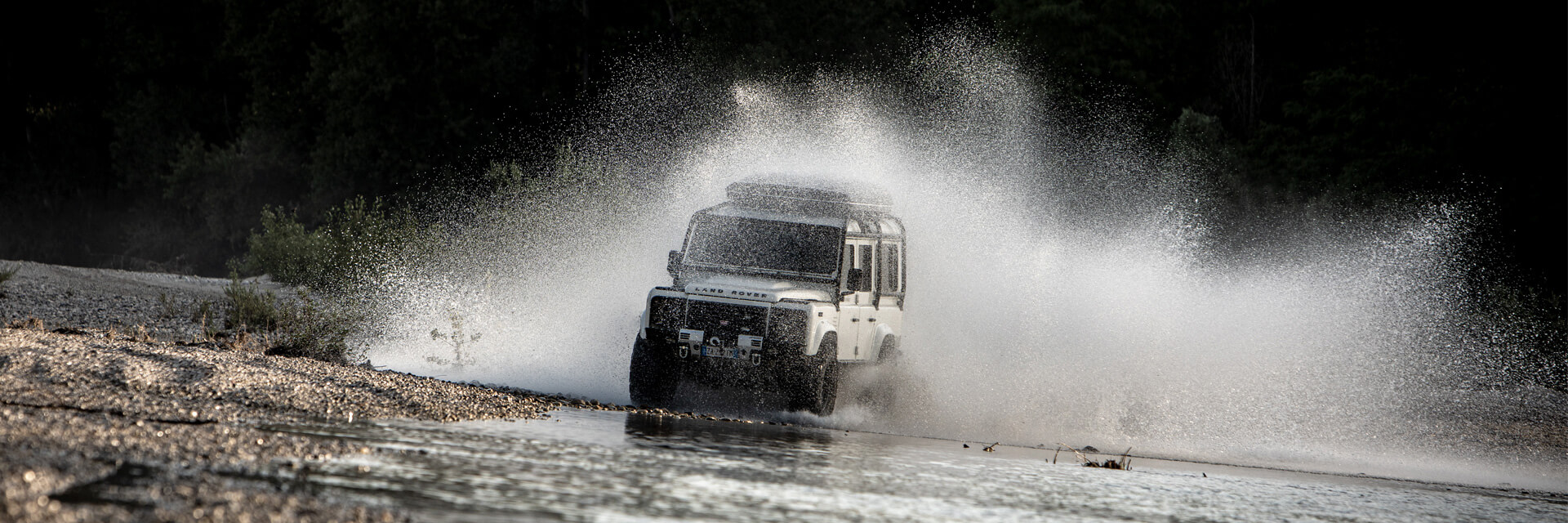
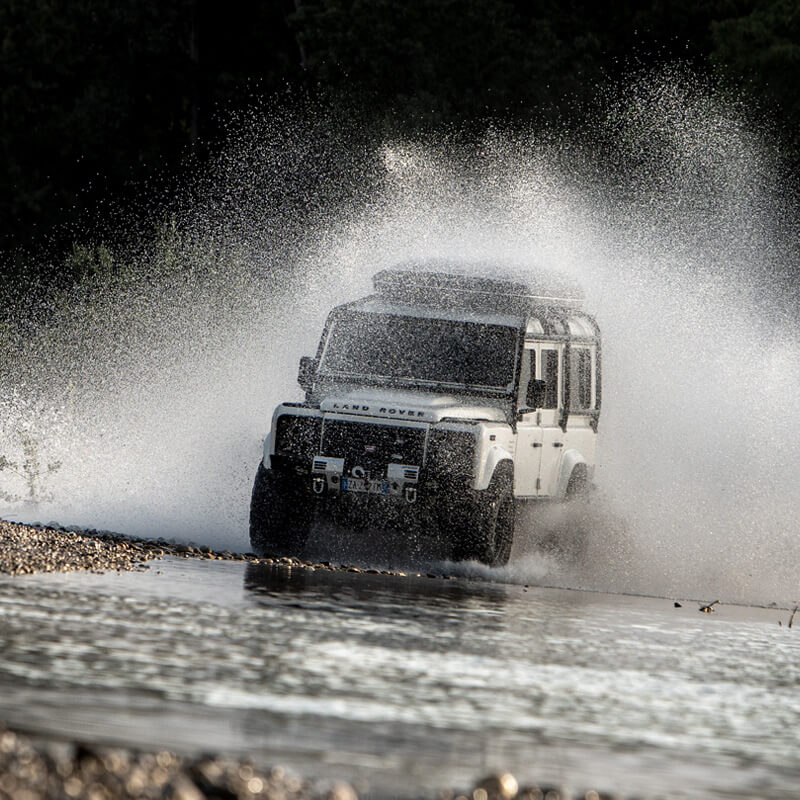
"Luggi" LUDWIG SCHMID
The expert’s opinion
Ludwig Schmid offers professional off-road equipment. He is one of the best southern Germany specialists in the fitting and preparation of vehicles for long-distance adventure travels. Thanks to his high-level mechanic job and to being part of the DTM Audi (GT-series) team at the Rally Dakar, he also has a wide and qualified experience in off-road. His passion for the off-road world has been handed on from his father. As he remembers: “I’ve always been fascinated by off-road, by the spirit of freedom, the contact with nature that makes it unique. At the same time, this is a world where technology is essential and precision and rationality are necessary. This is probably why I managed to make a job out of my passion. I love not having any barrier between my hobby and my job”. It is not a coincident that, apart from the off-road, his favorite hobbies are fishing, hunting, skiing and ice hockey. Hitting the road is what makes him happy the most and makes him able to improve his professional skills.
“His” tent is Maggiolina Grand Tour 360°
Luggi travels a lot by using roof tents, especially in Europe in any season. His tents have always been from Autohome. He prefers the difficult weather conditions of the North and during his journeys he came up with the idea of optimizing the Maggiolina tent; using his intuition the Maggiolina Grand Tour 360° was created. “This is a tent that in its basic project has been designed to offer great space in the inside and maximum view outside. Moreover, it is very solid and stable, so much that it can be used as a trunk during the journey. On the top shell of the rooftop tent it also offers roof racks to load some more material. Thanks to my advices, the production department highlighted the characteristics of Maggiolina and made Grand Tour 360° the ideal tent for every climate: thanks to the wide windows, it’s ideal for hot weather a d for those needing high protection from bad weather. A further element that I highlighted is the necessity to get maximum protection against insects. A demand that is shared by journeys to North and South alike. Thanks to a high-quality darkening net, Maggiolina Grand Tour 360° protects your privacy by keeping good air circulation. This is due to AIRTEX® fabric on the side walls: waterproof yet able to expel water vapor outside the tent. Moreover, I always appreciated the great accuracy with which Autohome has thought through and created this product. For example, he fact that doors and windows can be partially or totally darkened for a maximum comfort."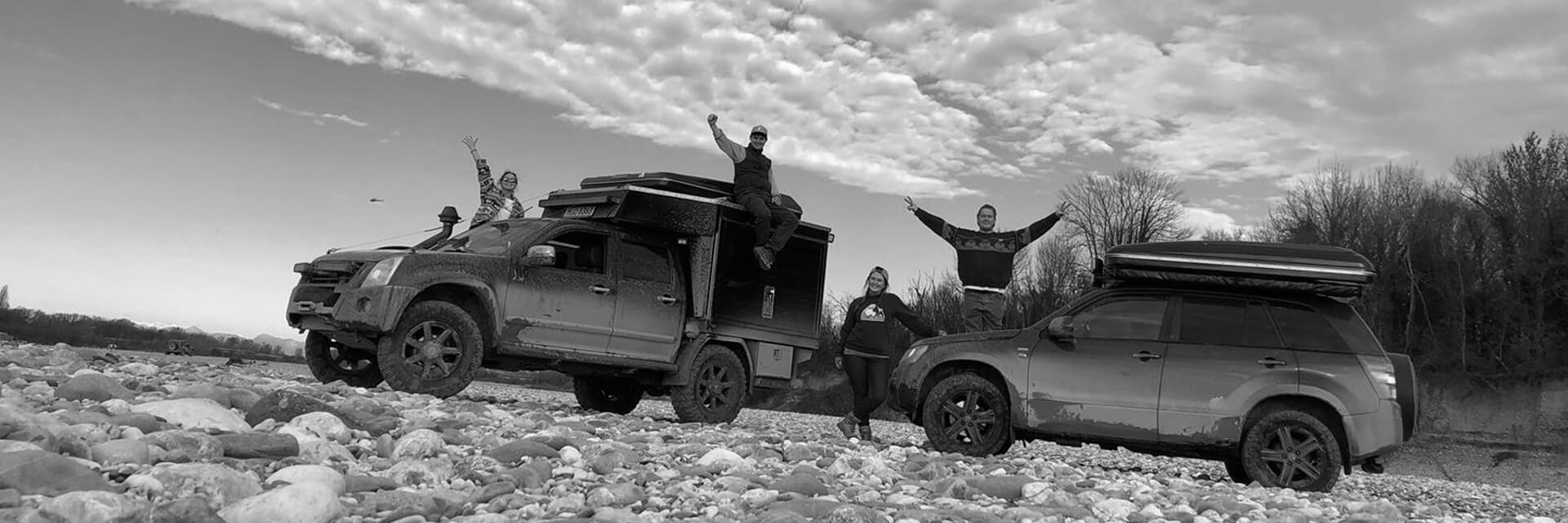
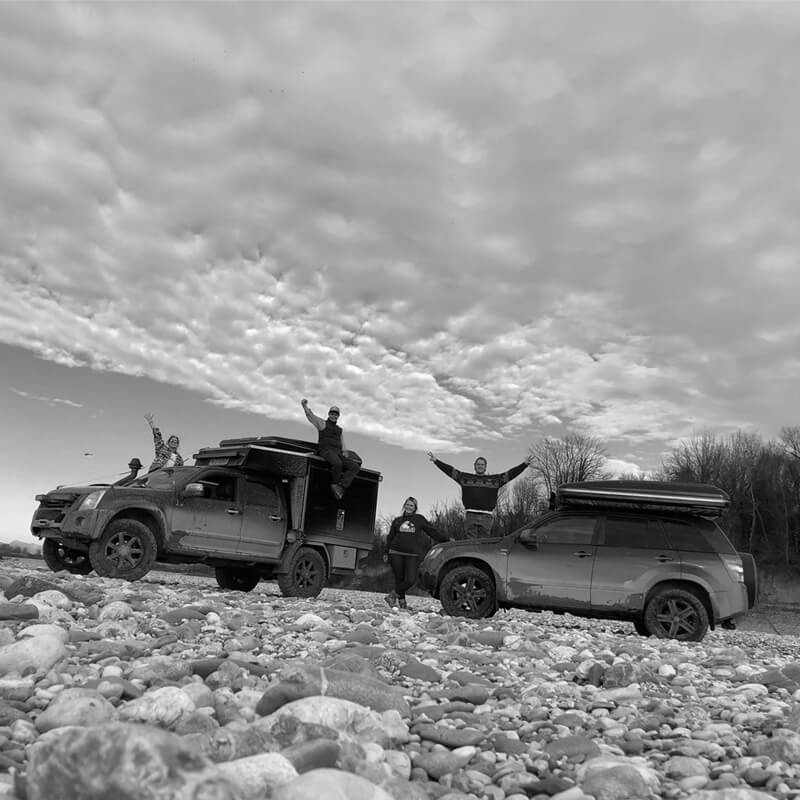
GIUSEPPE FERCODINI
INTERVIEW
By Eugenio Martignani
Roof tents: which one to choose?
An interesting conversation with Giuseppe Fercodini, founder and owner of Autohome. The main principles of a mythical product that became the symbol of the journey in freedom and its guide to the purchase of the right tent.
Who is Giuseppe Fercodini, a life dedicated to roof tents?
Only by knowing the character can we understand the philosophy that led him to create a product that has become a status symbol and synonymous with adventure.
I have recently turned 60 and I can safely say that much of my life was devoted to knowing, improving and promoting our product "roof tents”. Over the years, my brother Giacomo and I, with the Autohome brand, always aimed at making us understand first of all what quality means in our sector. A commitment which we still consider to be a priority today. Indeed, today perhaps even more than once! We were pioneers in our field and we had in mind, since we designed the legendary Maggiolina, that quality, which then means practicality, livability and durability of the product, should be our must have. We built our market positioning on these principles. That require honesty and transparency. Because quality is a concept that goes beyond brands. The same applies to Autohome. I still consider myself a "craftsman-entrepreneur”. I am not a trader, let alone an accountant or importer of products that come from abroad. I'm just a perfectionist, that's what they say about me! I think I am a person who loves beauty and beautiful things, created by man and nature. I have two passions that I believe in: freedom and travel. Each tent has its own soul, a story to tell. Our job is to help people achieve this goal: to travel freely. I don't even know exactly how many models and combinations we have in Autohome, between sizes and colours we may exceed 100 variations. If Autohome did and continues to do the history of roof tents, it is because since 1958 it has always been consistent with these principles.
Why does the roof tent like more and more and what is its charm?
First of all, it is a choice of independence, which opens up prospects that other ways of travelling cannot offer. Whatever the type of trip, discovery, adventure, relaxation, from the big stage raid to the short weekend, the roof tent can be quick and easy, transforming the vehicle into a house in a few seconds, wherever you are. The real roof tents, and I emphasize true, are stable and safe in the wind, they do not undergo installation constraints. They always allow a comfortable accommodation in the front row: by the sea, the lake, the river, in the pine forest... however in direct contact with nature.
What is the most requested and preferred tent by users today?
Take our offer as an example: Autohome shell tents are exported to more than 40 countries and account for 70% of sales; the remaining 30% is for fabric tents. Only a few years ago the sales quotas were the exact opposite. Why this reversal of trend? Because only a few years ago, "pure and hard" adventurers, Saharans included, who were prone to folding fabric tents, prevailed.
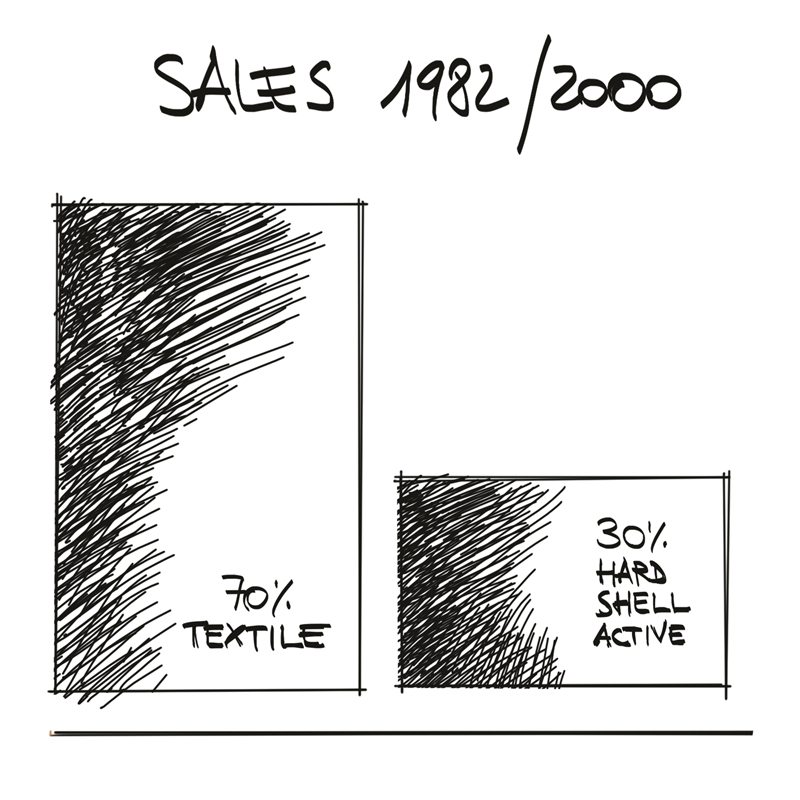
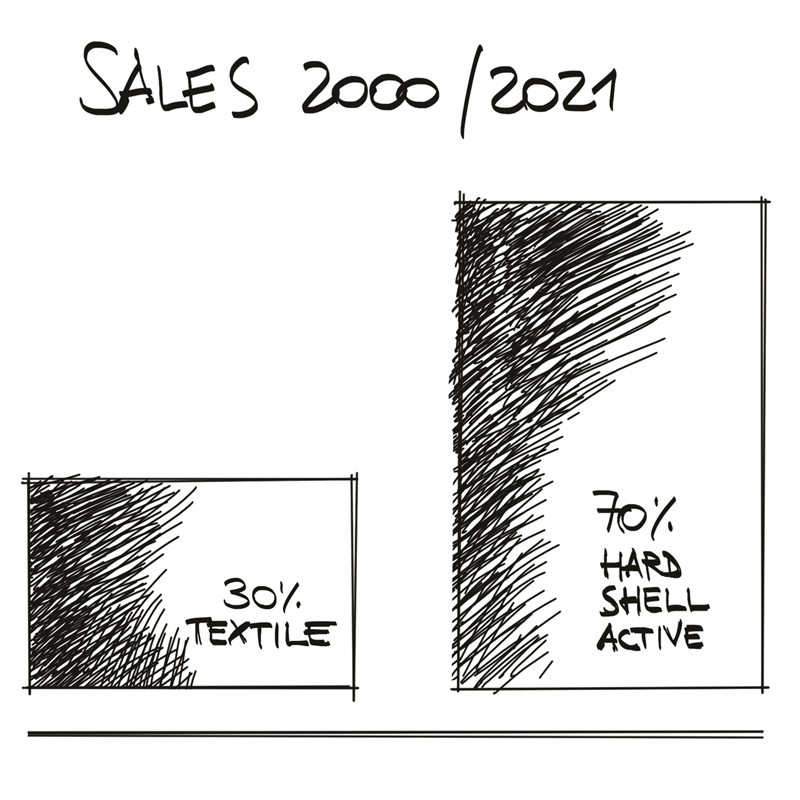
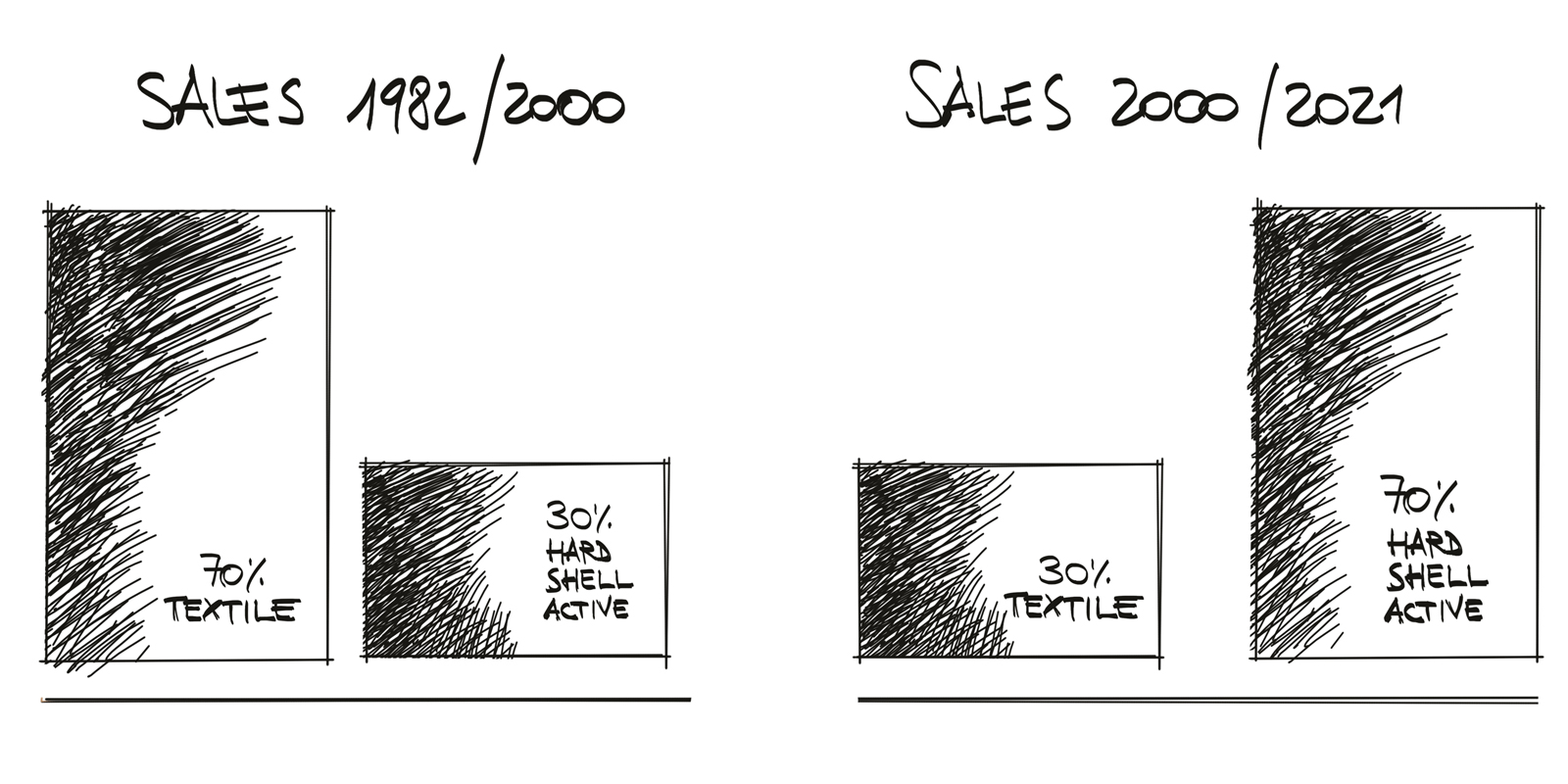
Africa and the desert were their main destinations, ideal destinations for explorers and travellers. We are talking about tents intended mainly for large 4x4-Off Road vehicles. It can rightly be said that the success that became planetary of roof tents began with the legendary Land Rover 109, thanks to the memorable feats of the legendary Nino Cirani, still today an icon of adventure for fans.
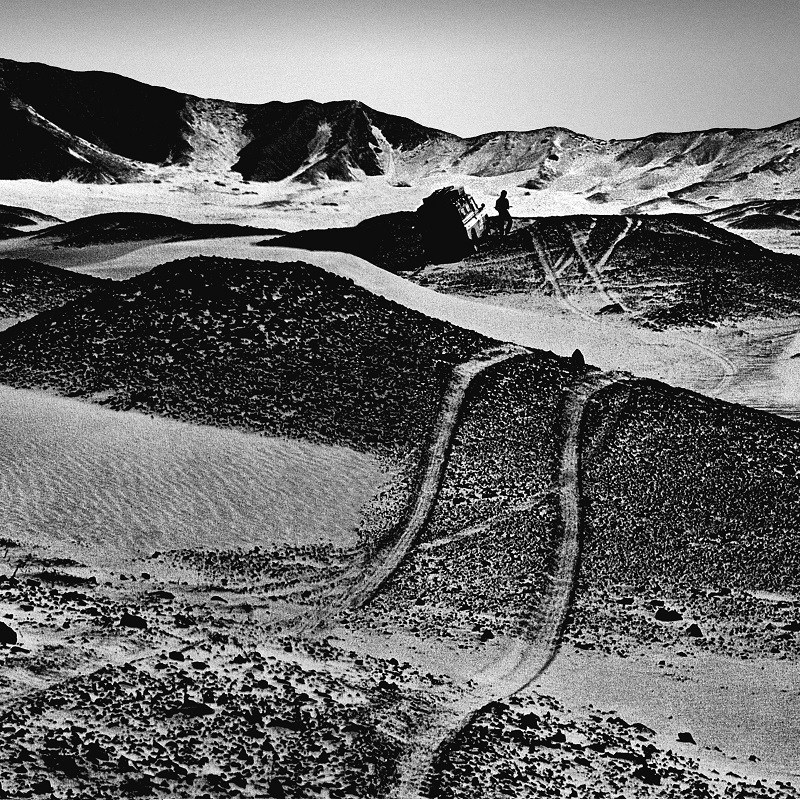
Above the Peruvian desert. Image by Nino Cirani, published in the book "Il raid automobilistico”, editorial Domus.
The main reason for choosing the fabric tent was that it occupies half the roof of the off-road vehicle, thus leaving the other half in space to carry tanks, spare tires and travel equipment. This was the main choice in the Off Road world that distinguished the market. But that is no longer the case today. The tent with a shell roof has taken over. There are those who say: but it costs more. I am convinced that in our sector the priorities go to other aspects, at least for those who really love free travel. I remember a traveling friend who said, “... you go to a good restaurant and eat very well, you will remember what you ate and not the bill”.
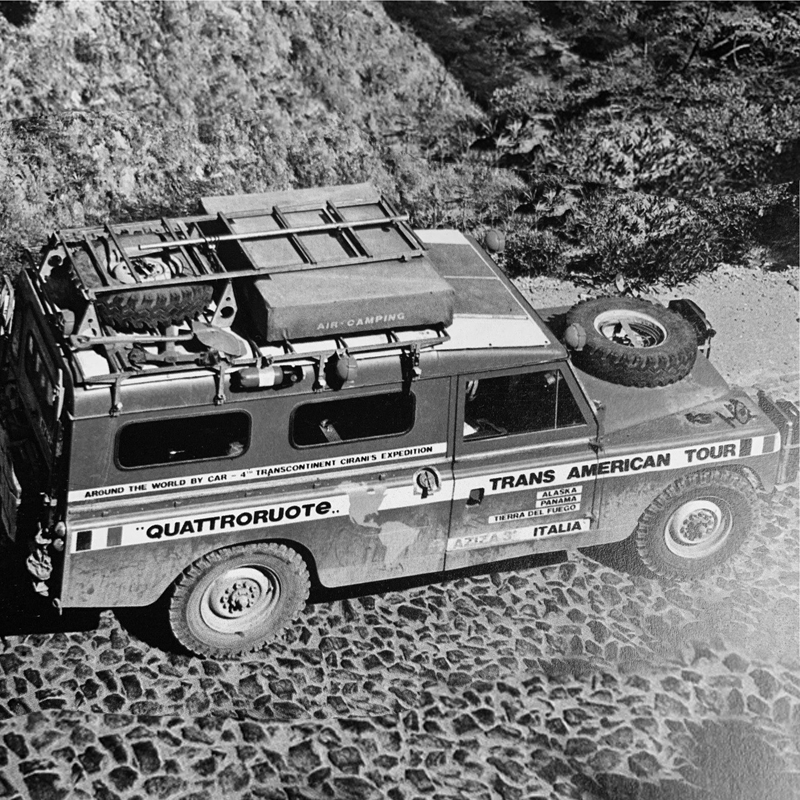
This is Nino Cirani's share 3 - Land Rover 109.
It should be noted that the tent occupies half the roof of the vehicle, thus leaving space to carry spare tyre and other travel equipment.
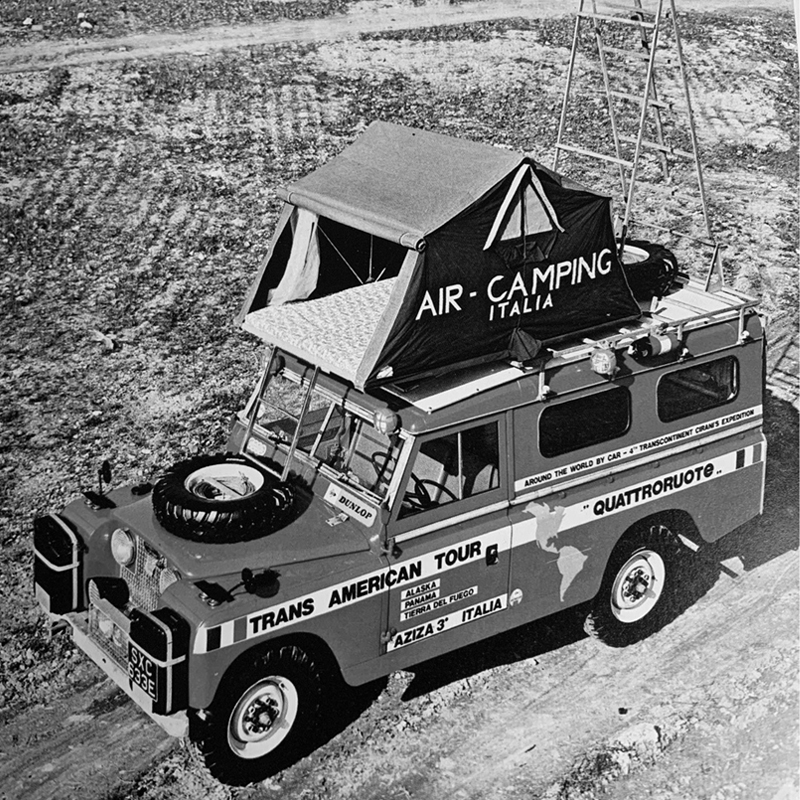
Assembly of the tent in the Nino Cirani’ style.
The open tent does not come out of the shape of the car, which means that it is possible to camp wherever you are.
Let's first talk about the traditional fabric tent. What are the strengths and weaknesses, and on which particulars to focus your attention to make the right purchase?
The fabric tents are essentially very compact when closed, and become well habitable when open. But be careful though: they open with a cantilevered platform and then come out of the shape of the car.
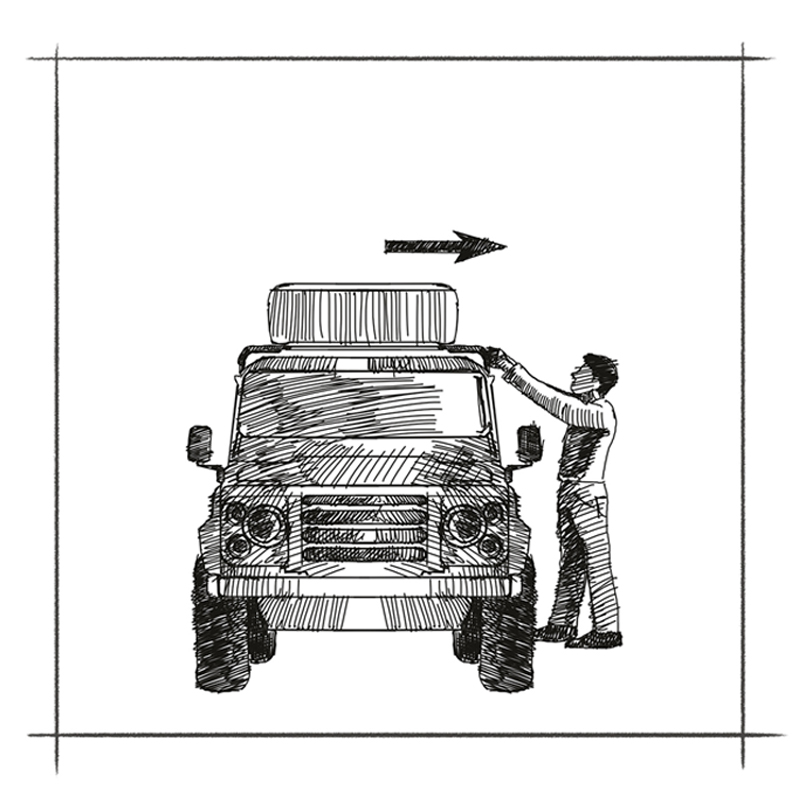
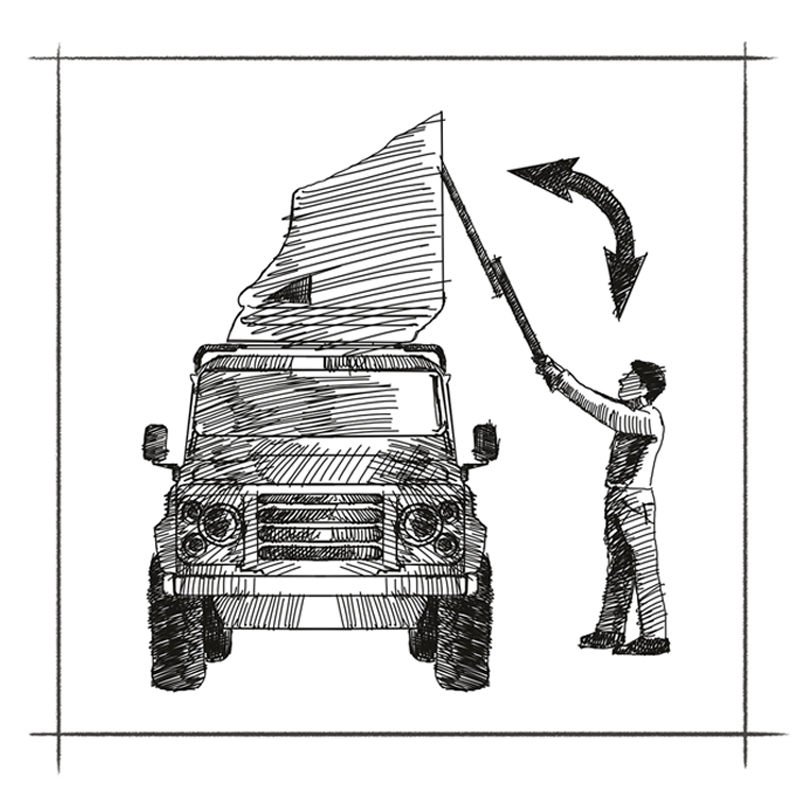
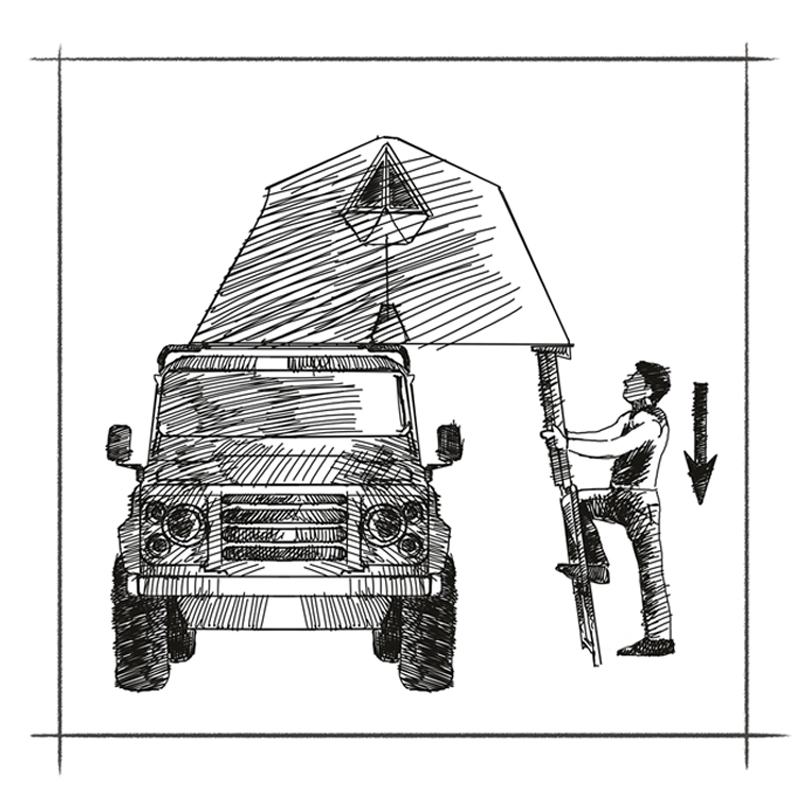
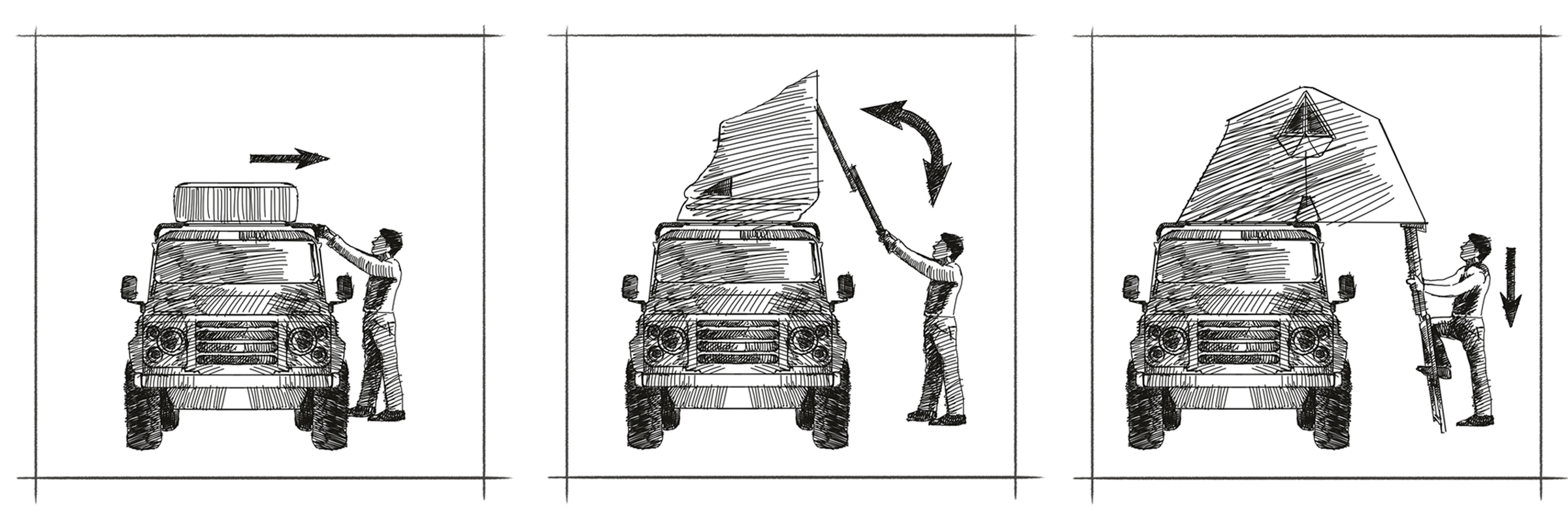
Let's see some aspects not to be underestimated.
The first point is the ladder: it should not be considered as an element to be kept detached from the tent and stored in the trunk of the car, that is to say, to be hooked whenever the tent is opened. Conceptually the ladder is a structural and load-bearing element of the tent in all respects. So I recommend checking that the ladder is integrated.
Second point: materials and structure of the platform. Autohome fabric tents have waterproof and water-repellent hardwood base with high elasticity, thus ensuring reliability and durability. Quality guarantees very different from tents of Asian origin that have floors in... coated polystyrene! So, before each purchase, check this item very well.
Third point: windows. That they must be perfectly integrated and not have protruding structures, because let's not forget that we are high from the ground. Personally I hate any stakes to match the windows as well as you can notice in low quality competitors product. Another aspect that I do not share in those tents are the windows on the roof, because they can easily become a source of rainwater infiltration risks. Over time it can prove to be a very serious problem. And then pay attention to the wind: a tent about two meters from the ground cannot have accessory, such as canopies and so on. The tent must be a single body, the roof must necessarily be integral with the walls. If you do not control these aspects in the purchase, there is a risk from the first use... of taking flight and going to hang gliding! Not to mention the sailing effect of fabrics: in many parking places the wind is a constant, which can create instability and noise, causing sleepless nights.
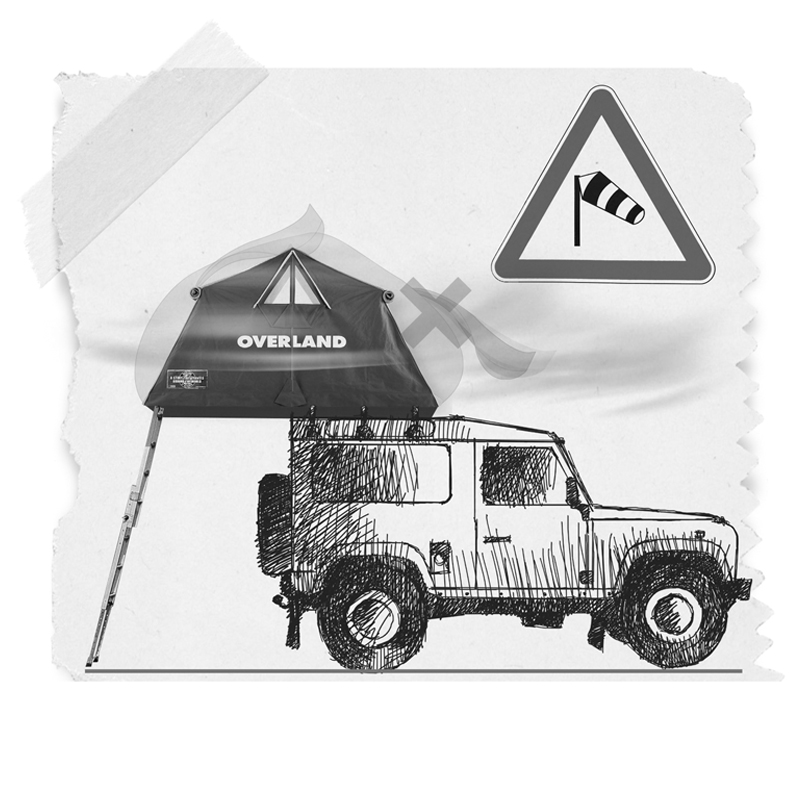 An Autohome range tent is represented here.
An Autohome range tent is represented here.
A real windproof roof top tent. A serious, original and grand design project that does not generate turbulence and noise, much less "the sail effect" or "the ball effect" that are avoided.
In Autohome we have always known these problems and we solve them on our fabric tents with fabrics and designs that are the result of the experience of many years of activity. One day, an authoritative off-road character said, "You are Italian and you like cooking, so you know how to dose the ingredients to make a good dish." This joke has stuck with me, I still treasure it today and I apply it to my tents that must be made of heavy fabric, this is the first ingredient.
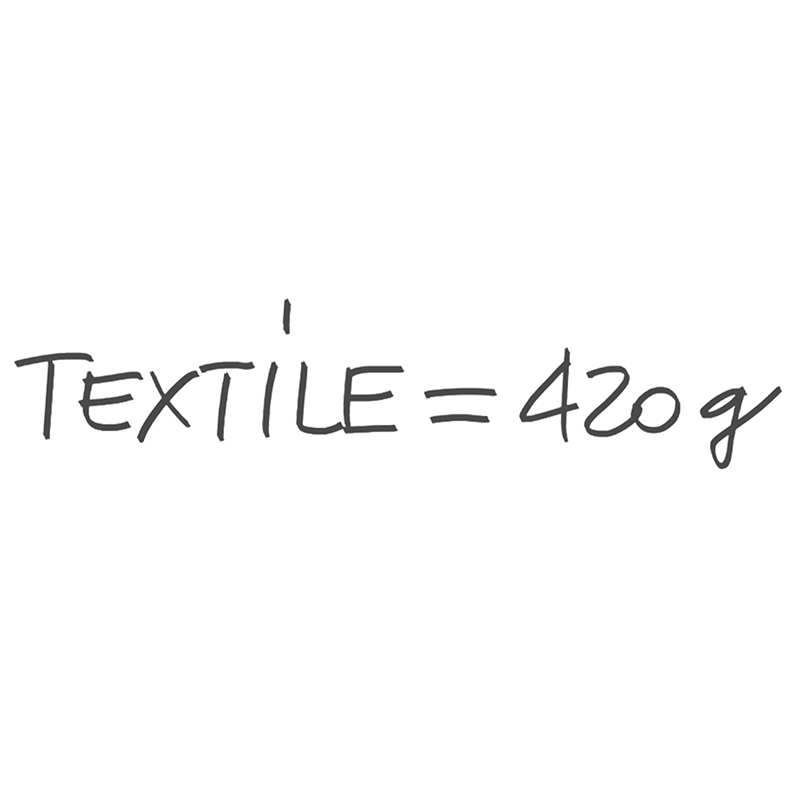
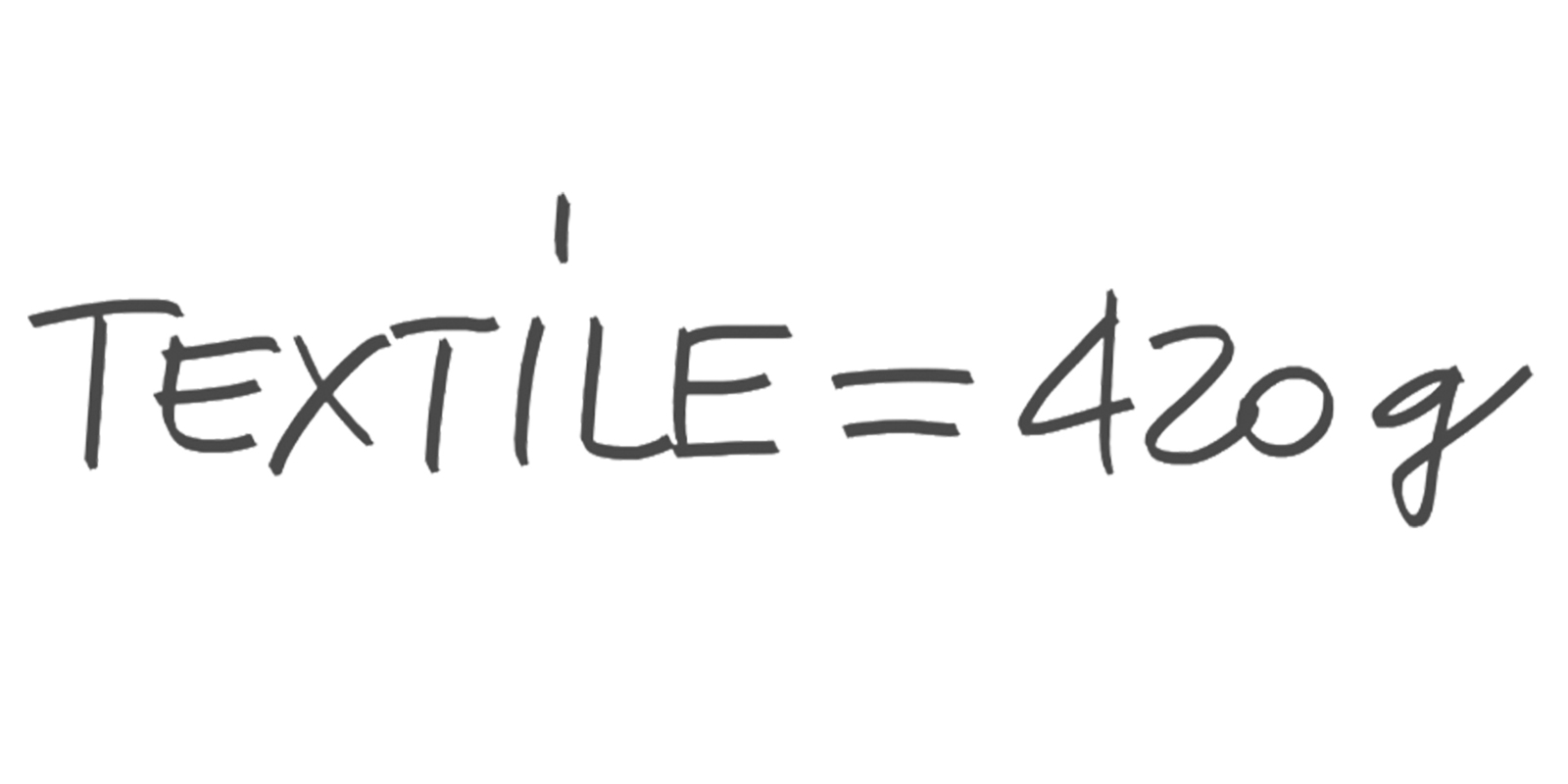
The second ingredient is that they must be simple and have little protruding fabric that generates sailing effect. It is usually preferable to stay in a private area or camping with a fabric tent. This is at least the law in force. The tent does not fit in the shape of the car, it comes out of the mirrors and therefore it is believed to occupy public land. They are therefore bound by the rules on the occupation of public land, a fundamental difference compared to the rigid roof tents, which are kept in shape. To recap: the great advantages are habitability and comfort. The most obvious problem is to have overnight limits in public areas.
Well, now let's consider the hard-shell tent. What are its strengths and how to choose it?
I believe that today these tents really have something more than fabric tents. In particular, it is the roof that makes the difference. Having a roof made of rigid and suitable materials means having a more insulated environment: you are more insulated from the heat and cold, more protected from every point of view. It is no coincidence that experts call them ACTIVE HARD SHELLS, that is, TENTS WITH AN ACTIVE ROOF.
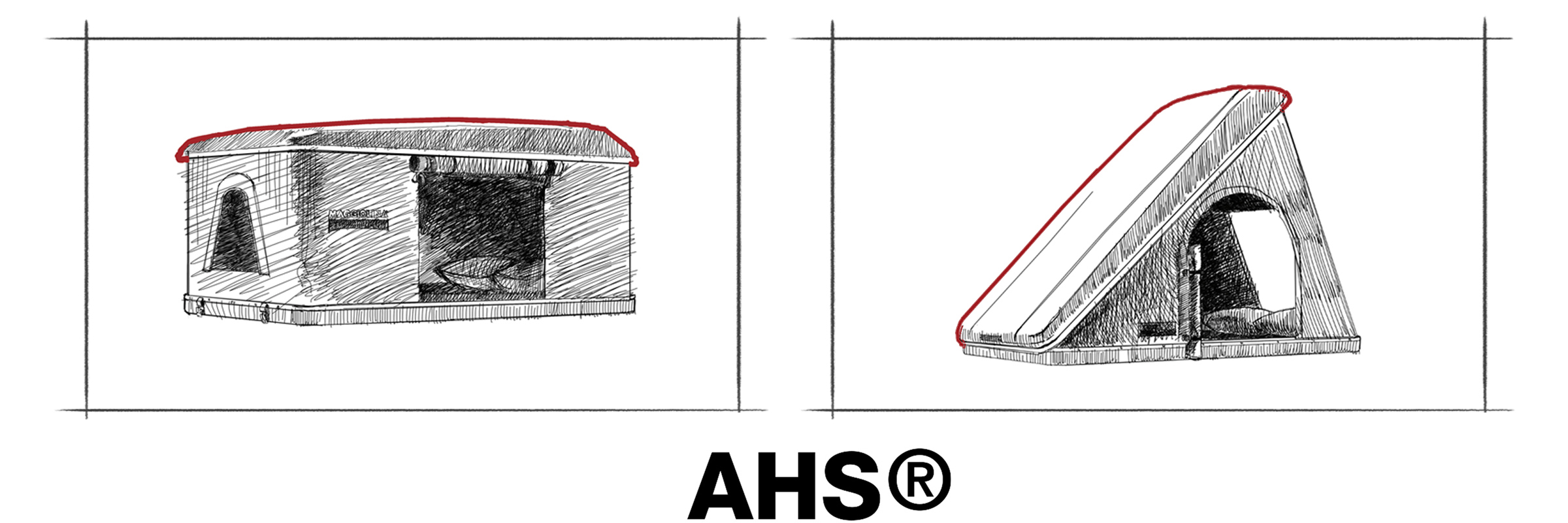

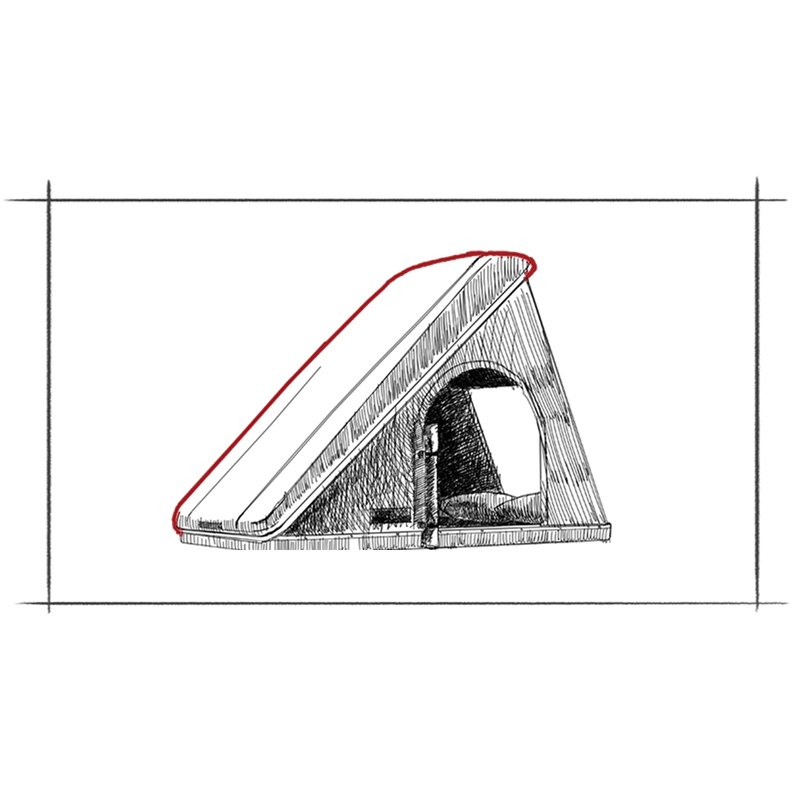
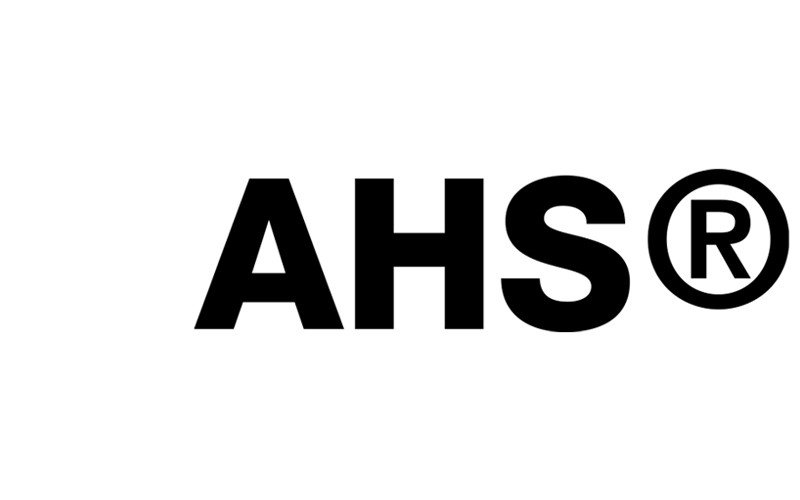
INSULATED ROOF
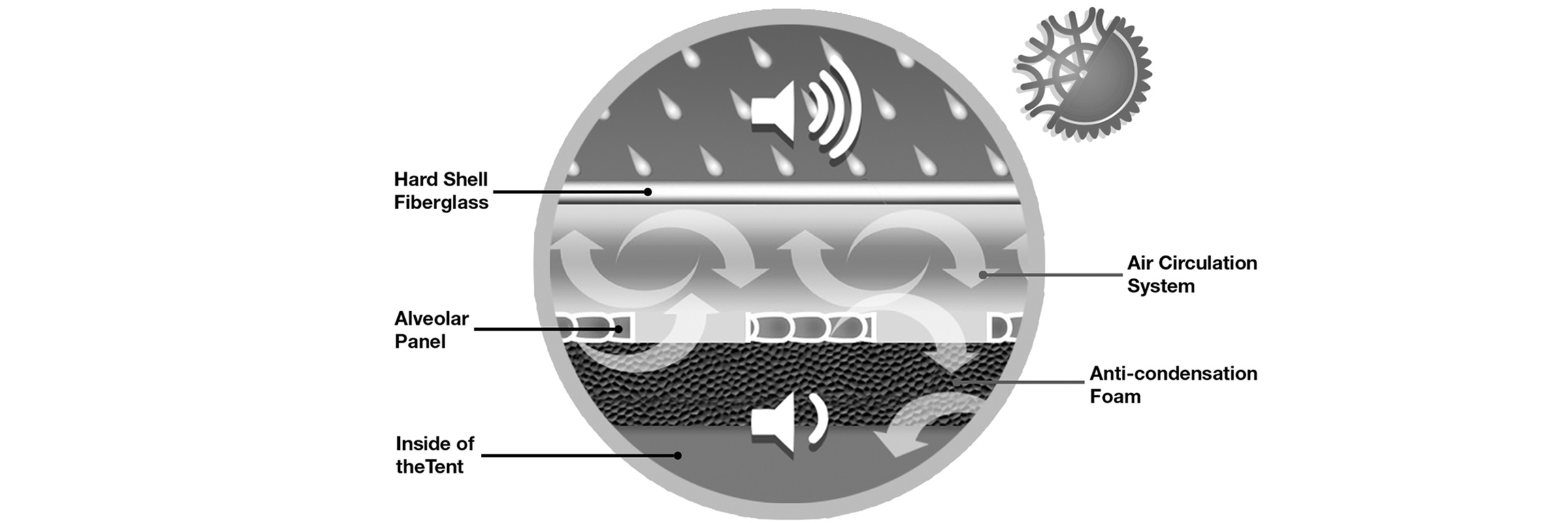
In fact, they have a little less internal habitability than fabric tents, but just choose a tent of the right size and the spaces become ideal. It must be considered that the shell tents are more compact and more stable than those in fabric, especially in the case of storms. They completely prevent infiltration. Welded fabrics, double sheets and PVC cannot compete with a rigid roof, among other things made of fiberglass which is also equipped with an internal insulating membrane. So, to sum up, I would say that the main advantages of shell tents are: an extraordinary stability without sacrificing the speed of opening and closing; to this is added the fact that the mattress is slightly higher and does not fold as for fabric tents. It is a single piece and has not been spliced. In addition, shell tents have no limits in deciding the location of overnight stays in public areas, because the tent and the ladder fall within the shape of the car.
The disadvantage, if we can define it that way, is only one: a higher cost of purchase than the fabric tents. But I strongly invite you to consider what they can guarantee over time in terms of comfort and safety, especially in adverse weather conditions.
Let's go into the specifics of materials and talk about fabrics. What is the best material and how to recognize it? 


It is a decisive choice in a tent, it naturally affects its quality and costs. Everything is on the market: more or less heavy, breathable, waterproof fabrics. In detail, it ranges from fabric with high impermeability or watertightness such as PVC, to lightweight nylon such as in Igloo tents, to coated, resined, synthetic, acrylic, eco-friendly fabric, natural cotton and mixed fabrics. Autohome does not trust products from markets outside Europe, and this is because quality is too variable. Our purchasing department is particularly attentive to this issue. In summary: for fabrics, as for yarn for stitching and also for mosquito nets we turn to Made in Germany suppliers of great seriousness and specialist expertise. I think it is essential to use the most breathable fabric possible or, in any case, a the fabric that best transmits heat and condensation to the outside, obviously it must be waterproof. A perfectly breathable fabric is certainly more expensive, but it is what allows you to get a cooler and healthier environment. Autohome tents have a high degree of breathability and optimal heat transmission to the outside. That's why they don't need to use fans, vacuum cleaners or extractors to spin the air. Next to the fabric, packaging and stitching must be considered. We always try to avoid them at critical points. On this subject, I say that I have little confidence in the chemistry applied to fabrics: for example, hot tape adhesives do not satisfy me; sometimes with temperature changes they lose grip. In my opinion, better mechanical solutions or alternative packaging methods are better. The most exposed zips, in particular, must be of high quality standard. Ours, the tents most exposed to water, are all waterproof and above all “spiral”, to resist abuse and wear. As you can easily understand, in this case you need to check well before buying. Above all, do not be enchanted by certain prices offered by unknown brands or without a story, often present only on the Internet. The concept is almost trivial, but it is always important and must be remembered: even in our sector, nobody gives anything away and every decision has its price.
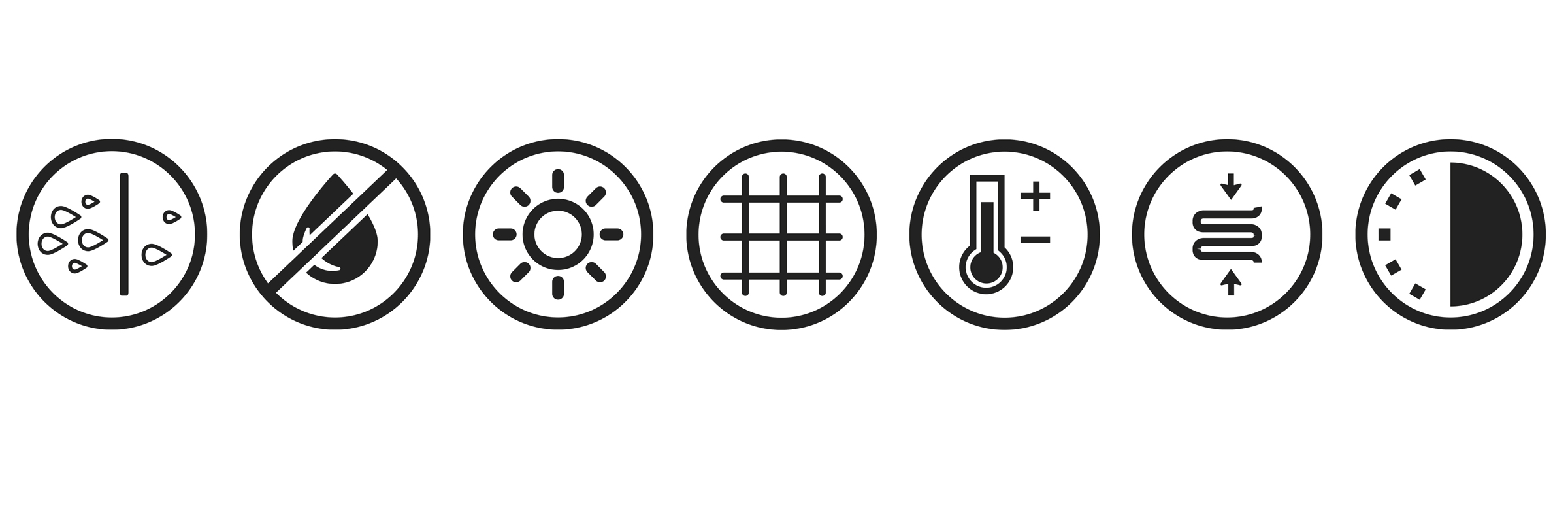
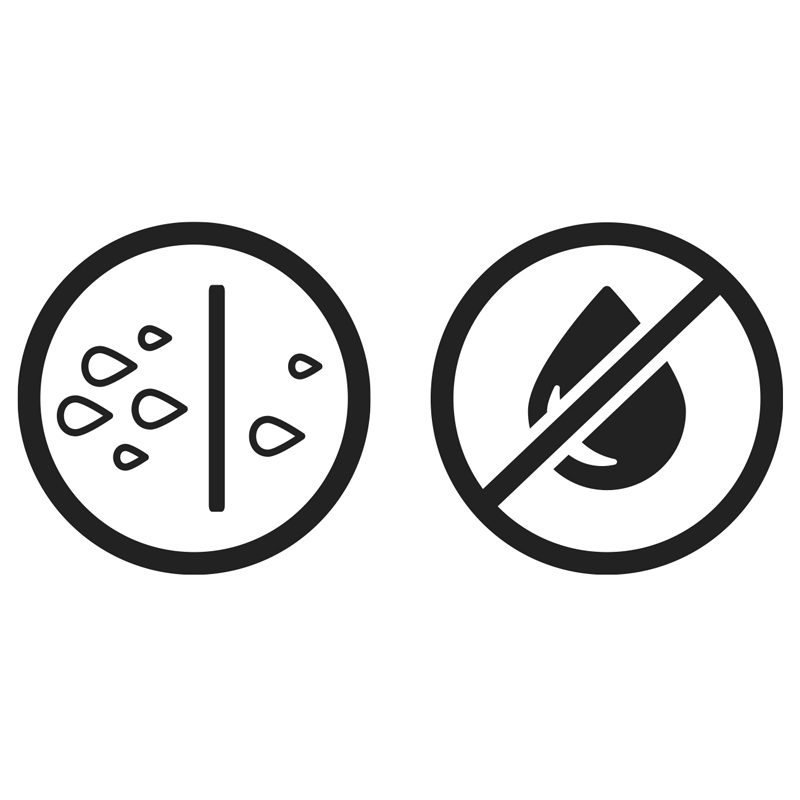
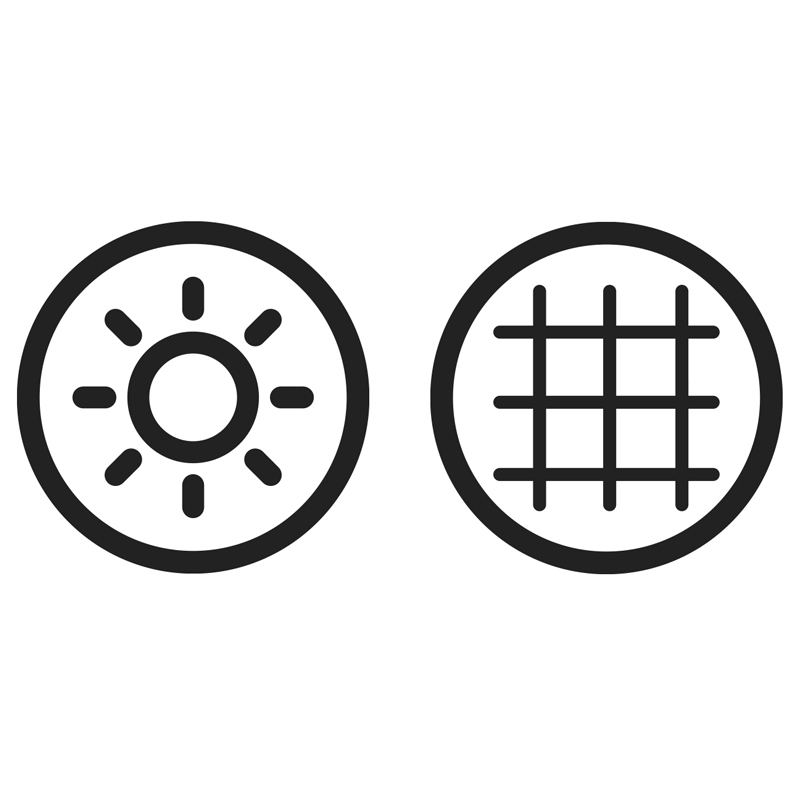


But an expert like you, Giuseppe, who has had the opportunity to thoroughly test and test all the tents in the Autohome range and knows their features well, which tent does he use personally?
When I was young, my first tent was the Maggiolina, which has always been my favourite. What memories! ... and that years of great enthusiasm and continuous discoveries... Initially I placed it on a Volkswagen Golf of 1982, then on a Passat Variant of the ’90s. I also used the mythical Air-Camping, but I did not have the right car to be in tune with what an extreme traveller did such as the great Nino Cirani, to be clear! Today that I am 60 years old, I use a Columbus shell with great joy. Exactly the X-long Land Rover model. This is because I want to be 100% safe and find myself in aesthetic harmony with my personal and timeless "Defender", year 2008. Also on this topic I would have a lot to tell... maybe next time, if you want.
GIUSEPPE FERCODINI
INTERVIEW
Roof tents: how to choose them?
A dialogue on the principles that characterize a mythical product of the journey in freedom, the roof tent, with the advice of Giuseppe Fercodini, founder and owner of Autohome.
Let's start by getting to know Giuseppe Fercodini first than the main product of our dialogue. Why have roof tents become an integral part of your life?
I recently turned 60 and I can safely say that much of my life was devoted to knowing, improving and promoting our product "roof tents”. Over the years, my brother Giacomo and I, with Autohome, always aimed at making people understand first of all what quality means in our sector. A commitment which we still consider to be a priority today. Indeed, today perhaps even more than once! We were pioneers in our field and we had in mind, since we designed the legendary Maggiolina, that quality, which then means practicality, livability and durability of the product, should be our must-haves. We built our market positioning on these principles. That require honesty and transparency. Because quality is a concept that goes beyond brands. The same applies to Autohome. There are elements that are essential. Either you adopt them or you don't adopt them. Period. Here's the difference. We apply them. But I say just as clearly: I am not aligned with one model or another, I have no particular preferences. I still consider myself a "craftsman-entrepreneur”. I am not a trader, let alone an accountant or importer of Asian products. I'm just a perfectionist, that's what they say about me! I think I am a person who loves beauty and beautiful things, created by man and nature. I have two passions that I believe in: freedom and travel. Each tent has its own soul, a story to tell. Our job is to help achieve this goal: to travel freely. I don't even know exactly how many models and combinations we have in Autohome, sizes and colors, maybe we exceed 100 variants. But I know that everyone is inspired by these values. If Autohome did and continues to do the history of roof tents, it is because since 1958 it has always been consistent with these principles.
What fascinated you in the roof tent product?
give. Whatever the type of trip, discovery, adventure, relaxation, from the big raid to stopovers to the short weekend, the roof tent can be fast and easy, transforming the vehicle into a home in seconds, wherever you are. The real roof tents, and I stress true, are stable and safe in the wind, do not undergo installation constraints. They always allow comfortable accommodation in the front row: by the sea, by the lake, by the river, in the pine forest... however in direct contact with nature.
What do users currently prefer?
Let me take our offer as an example: Autohome shell tents are exported to more than 40 countries and account for 70% of sales; the remaining 30% belongs to fabric tents. Only a few years ago the sales division was exactly the opposite. Because fabric tents are the origin of the product. Even just a few years ago, "pure and hard” adventurers stood out, including Saharans, prone to folding fabric tents.


Africa and the desert were the main destinations, ideal destinations for explorers and travellers. We are talking about tents intended mainly for large 4x4-Off Road vehicles. It can rightly be said that the global success of roof tents began with the legendary Land Rover Defender 110, thanks to the memorable exploits of the legendary Nino Cirani, still an icon of adventure for enthusiasts today.

Above the Peruvian desert. Image by Nino Cirani, published in the book "Il raid automobilistico”, editorial Domus.
The main reason for choosing the fabric tent was that it occupies half the roof of the off-road vehicle, thus leaving the other half in space to carry tanks, spare tires and travel equipment. This was the main choice in the Off Road world that distinguished the market. But that is no longer the case today. The tent with a shell roof has taken over. There are those who say: but they cost more. I am convinced that in our sector the priorities go to other aspects, at least for those who really love free travel. I remember a traveling friend saying, “... when you go to a good restaurant and eat very well, you remember what you ate and not the bill”.

This is AZIZA 3 - Land Rover 109 from Nino Cirani.
It should be noted that the tent occupies half the roof of the vehicle, thus leaving room for transporting spare rubber tyre and other travel equipment.

Assembly of the tent in the Nino Cirani’ style.
The open tent does not come out of the shape of the car, which means that it is possible to camp wherever you are.
Let's first consider fabric tents. Where should attention for any choice be paid to?
The fabric tents are essentially very compact closed and become well habitable when opened. Be careful though: they open with cantilevered platform and then protrude from the shape of the car.



Let's look at some aspects of attention. First of all, the ladder: it should not be considered as an element to be kept detached from the tent and stored in the trunk of the car, that is to say, to be hooked whenever the tent is opened. Conceptually the ladder is a functional element of the tent in all respects. So I recommend checking that the ladder is integrated.
Second aspect: materials and structure of the platforms. Autohome fabric tents have waterproof and water-repellent hardwood base with high elasticity, thus ensuring reliability and durability. Quality guarantees very different from tents of Asian origin that have floors in... coated polystyrene! So, before each purchase, check this item very well.
Thirdly: the windows. That they must be perfectly integrated and not have protruding structures, because let's not forget that we are tall from the ground. Personally I hate any stakes to match windows, as you can see in poor quality Asian products. Another aspect that I do not share in these tents are the windows on the roof, because they can easily become a source of rainwater infiltration risks. Over time it can prove to be a very serious problem. And then pay attention to the wind: a tent about two meters from the ground cannot have structural sloping elements, such as canopies and so on. The tent must be a single body, the roof must necessarily be integral with the walls. If you do not control these aspects in the choice phase, there is a risk from the first use... of taking flight and going to hang gliding! Not to mention the sailing effect of fabrics: in many parking places the wind is a constant, which can create instability and noise, causing sleepless nights.
 Shown here is an Autohome range tent.
Shown here is an Autohome range tent.
A real windproof car roof tent. A serious, original and great design project that will not generate turbulence and noise, let alone “the sail effect” or “the ball effect” which are averted. scongiurati.
We always knewn these attentions to be paid in Autohome and we solve them in our fabric tents with suitable solutions, the result of the experience of many years of activity. An authoritative manager once said, “You are Italian and like cooking, so you know how to dose the ingredients to make a good dish”. This joke impressed on me and I still treasure it today and it is part of my personal experience. Fabric roof tents must be of heavy fabric, this is the first ingredient.

They must also be simple and have little protruding fabric that generates a sailing effect. It is preferable to stay in a private area or campsite with a fabric tent. This is at least the law in force. The tents does not fit in the shape of the car, it protrudes from the mirrors and it is therefore believed to occupy public land. They are therefore bound by the rules on the occupation of public land, a fundamental difference from the rigid roof tents, which remain in shape. To recap: the great advantages are habitability and comfort. The most obvious problem is having overnight limits in public areas.
Let's look at the rigid tents with shells. What are the considerations to taken into account when choosing?
I believe that these tents actually have something more today than fabric tents. In particular, it is the roof that makes the difference. Having a roof in suitable materials means having a more insulated environment: you are more isolated from the heat and cold, more protected from every point of view. It is no coincidence that the experts call them HARD SHELL ACTIVE, THE TENTS WITH AN ACTIVE ROOF.
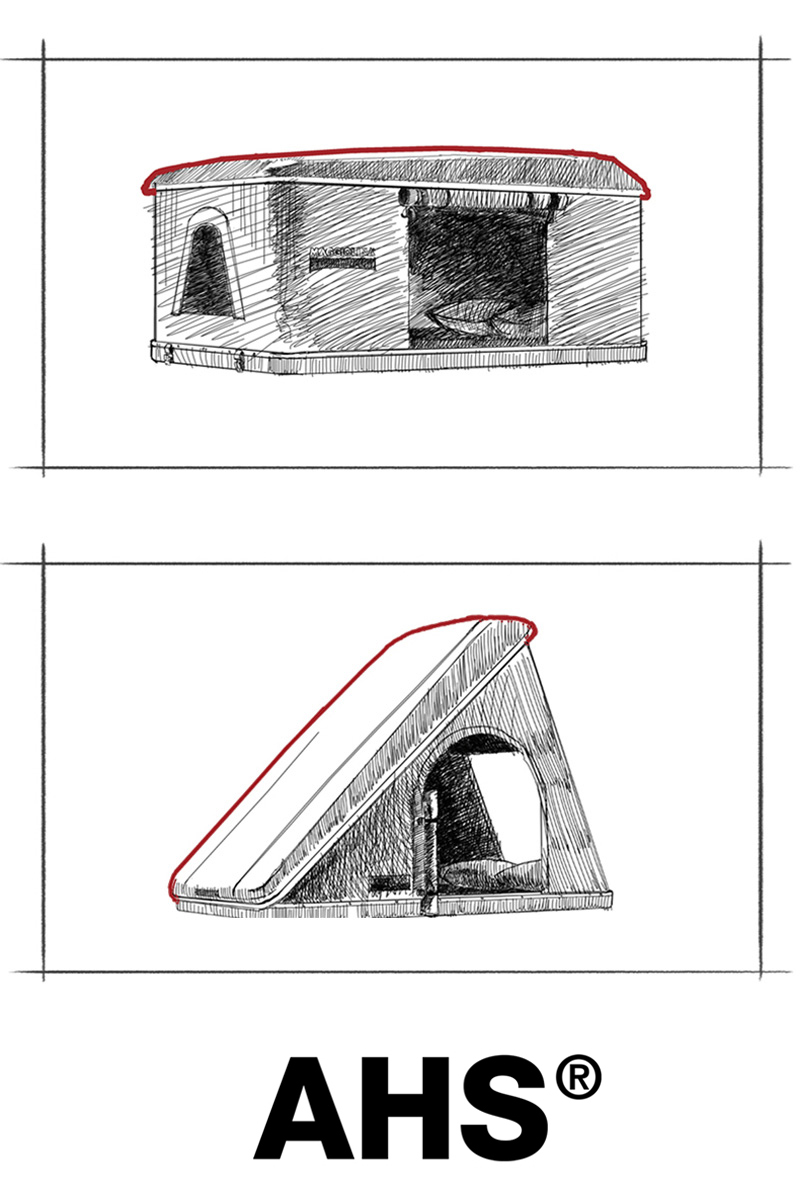
INSULATED ROOF
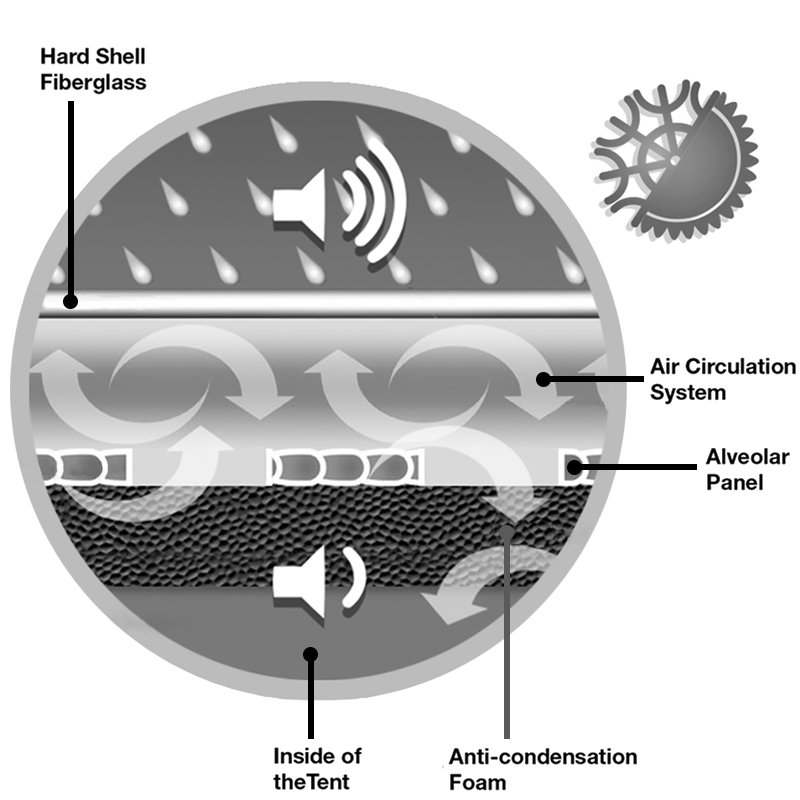
In fact they have a little less internal habitability than fabric tents, but just choose an adequate size of tent and the spaces become ideal. Shell tents are more compact and stable than fabric tents, especially in storms. They completely prevent infiltration. Welded fabrics, double sheets and PVC cannot compete with a rigid roof, among other things made of fiberglass which is also equipped with an insulating inner membrane. Not surprisingly for quality fabric tents, such as our Air-Camping, for example, we minimize seams on the roof. Let alone put zips on the roof or windows, as it appears on certain low-cost models from Asia.So, to sum up, I would say that the main advantages of shell tents are: an extraordinary stability without sacrificing the speed of opening and closing; to this is added the fact that the mattress is slightly higher and does not fold like the fabric tents. It is a unique piece with no joints In addition, shell tents have no limits in deciding the location of overnight stays in public areas, because the tent and ladder fall within the shape of the car.
The disadvantage, if we can define it that way, is only one: a higher cost of purchase than the fabric tents. But I strongly invite you to consider what they can guarantee over time in terms of comfort and safety, especially in adverse weather conditions.
Returning to fabrics, but considered as materials, what can we specify as a focus of attention to our readers? 

It is a decisive choice in a tent, it naturally affects its quality and costs. Everything is on the market: more or less heavy, breathable, waterproof fabrics. In detail, it ranges from fabric with high impermeability or watertightness such as PVC, to lightweight nylon such as in Igloo tents, to coated, resined, synthetic, acrylic, eco-friendly fabric, natural cotton and mixed fabrics. Autohome does not trust products from markets outside Europe, let alone Asia, and this is because quality is too variable. Our purchasing department is particularly attentive to this issue. In summary: for fabrics, as for yarn for stitching and also for mosquito nets we turn to Made in Germany suppliers of great seriousness and specialist expertise. This allows us to leave behind unreliable production paths. For example, making tents using double sheets: they are too fluttering and unstable solutions that create turbulence in the wind, in addition to causing bulk. I think it is essential to use the most breathable fabric possible or, in any case, a the fabric that best transmits heat and condensation to the outside, obviously it must be waterproof. A perfectly breathable fabric is certainly more expensive, but it is what allows you to get a cooler and healthier environment. Autohome tents have a high degree of breathability and optimal heat transmission to the outside. That's why they don't need to use fans, vacuum cleaners or extractors to spin the air. Next to the fabric, packaging and stitching must be considered. We always try to avoid them at critical points. On this subject, I say that I have little confidence in the chemistry applied to fabrics: for example, hot tape adhesives do not satisfy me; sometimes with temperature changes they lose grip. In my opinion, better mechanical solutions or alternative packaging methods are better. The most exposed zips, in particular, must be of high quality standard. Ours, the tents most exposed to water, are all waterproof and above all “spiral”, to resist abuse and wear. As you can easily understand, even here you need to be certain before buying. Above all, do not be enchanted by certain prices offered by unknown brands or without a history, often present on the Internet. The concept is almost trivial, but always important and must be remembered: even in our sector, nobody gives anything and every decision has its price.




But an expert like yourself, Mr Fercodini, directly involved in the sector, which tent do you personally use?
When I was young, my first tent was Maggiolina, which has always been my favorite. What memories! ... and what years of great enthusiasm and continuous discoveries... Initially I placed it on a 1982 VW Golf, then on a VW Passat Variant from the '90s. I also used the legendary Air-Camping, but I didn't have the right car to be in tune with what an extreme traveller did, such as the great Nino Cirani, to be clear! Today I am 60 years old, I use a Columbus shell with great joy. Exactly the X-long Land Rover model. This is because I want to be 100% sure and find myself in aesthetic harmony with my personal and timeless “Defender”, year 2008. By the way, even the legendary Defender celebrates its 60th birthday! Also on this topic I have a lot to tell... maybe a next time, if you want.





